Coucou, mes cailles! After NY, London and Milan, we’re on the final stop of our fashion world tour in Paris, ready to see all the stunning collections coming out of the city of light and love for AW23. Of course, there are bound to be many jaw-dropping moments, coming from blockbuster maisons like Louis Vuitton, Chanel, Comme Des Garçons, Valentino and Miu Miu, not to mention the sure-to-be-shimmering debuts of Harris Reed at Nina Ricci and Ludovic de Saint Sernin at Ann Demeulemeester. Keep this page bookmarked as we update with everything you’ll want to see from Paris Fashion Week.
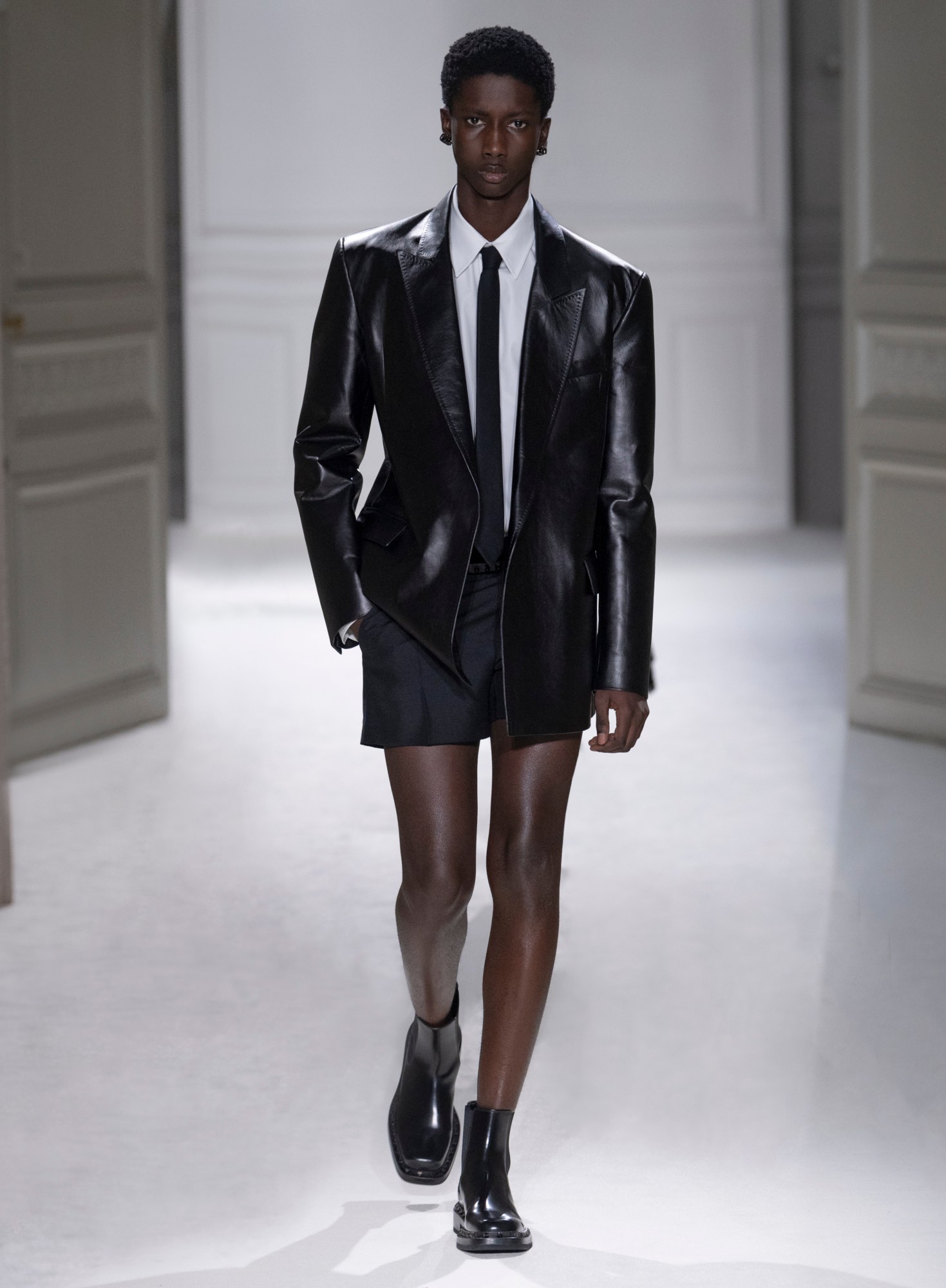
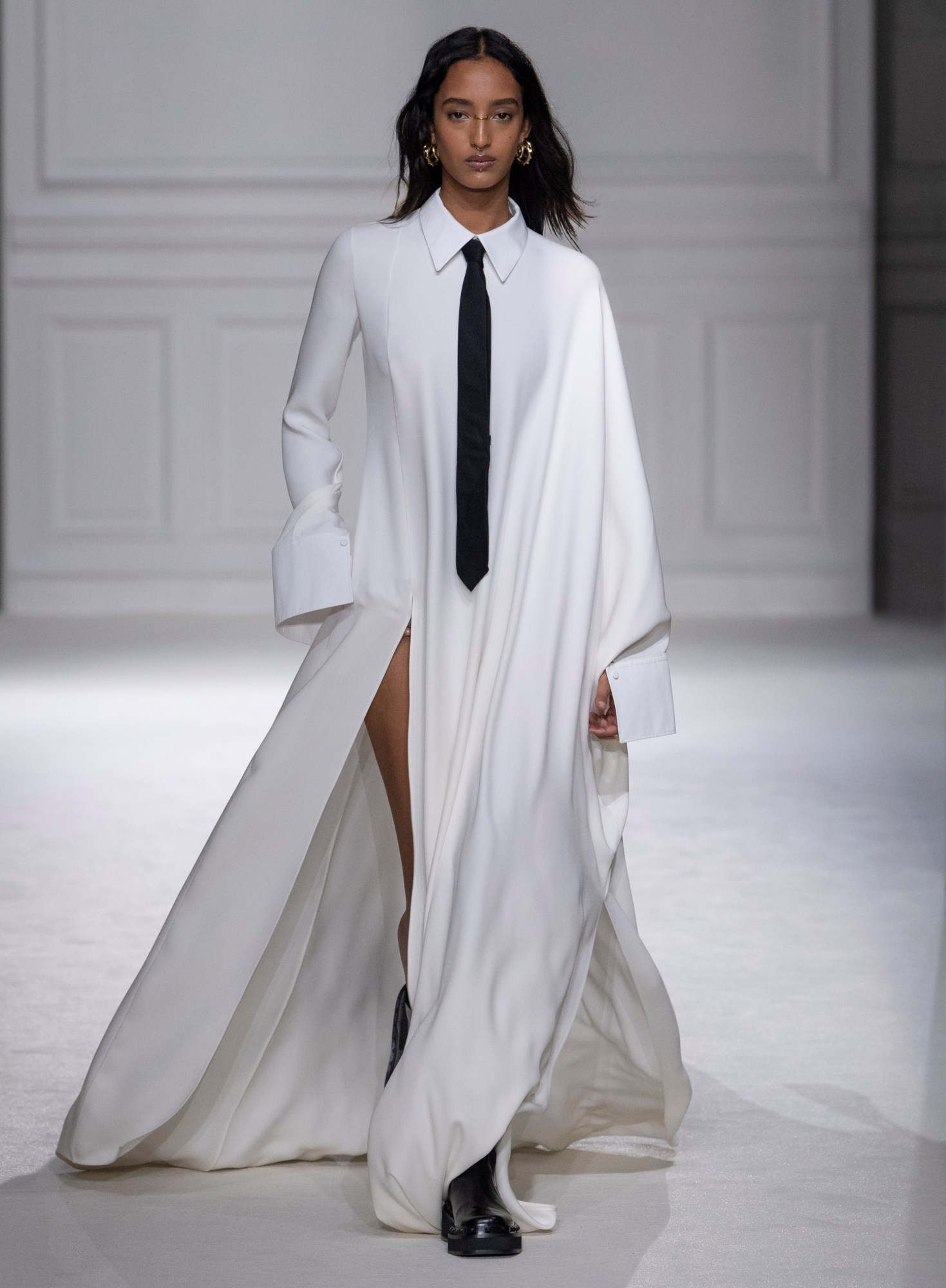
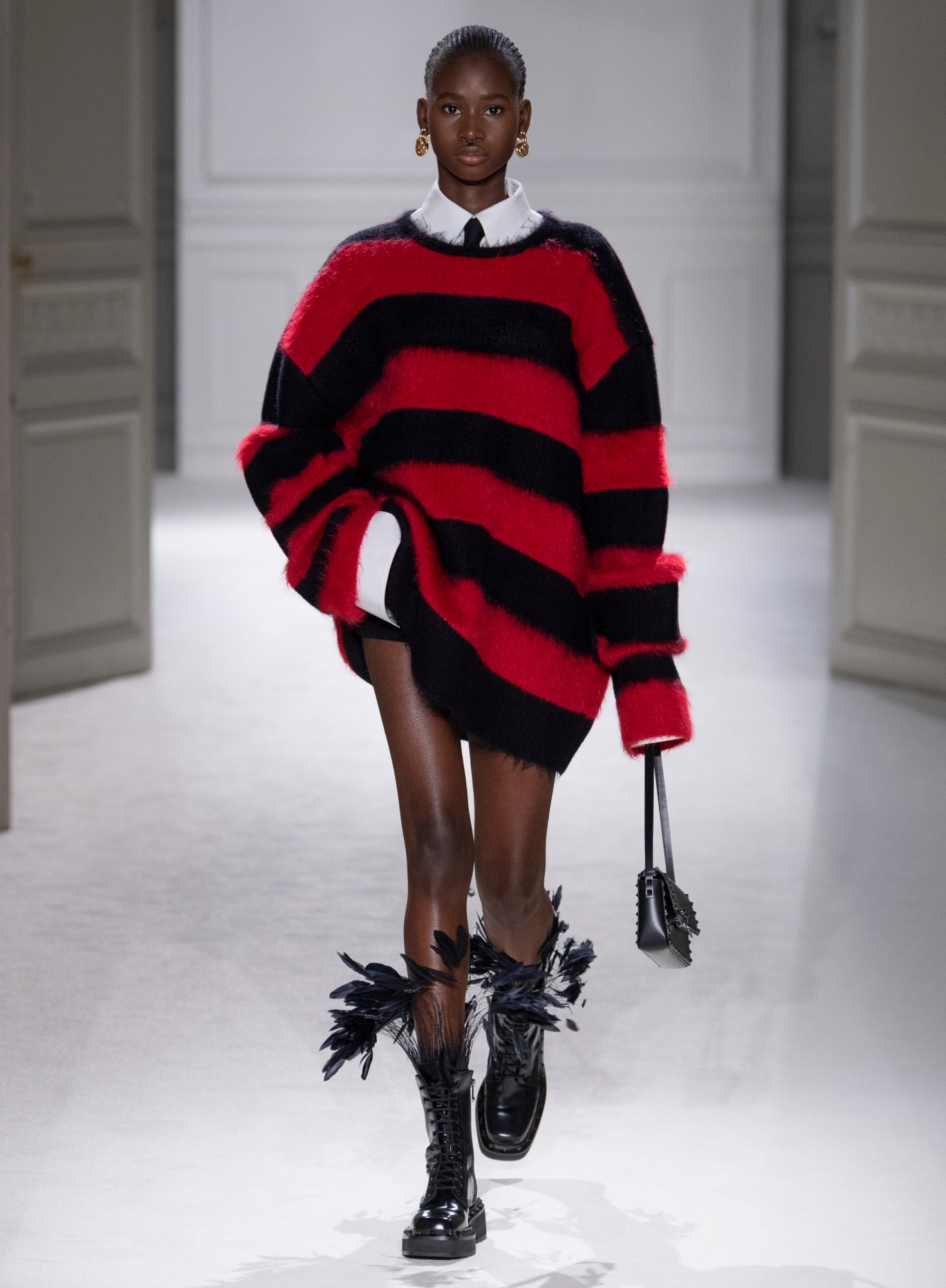
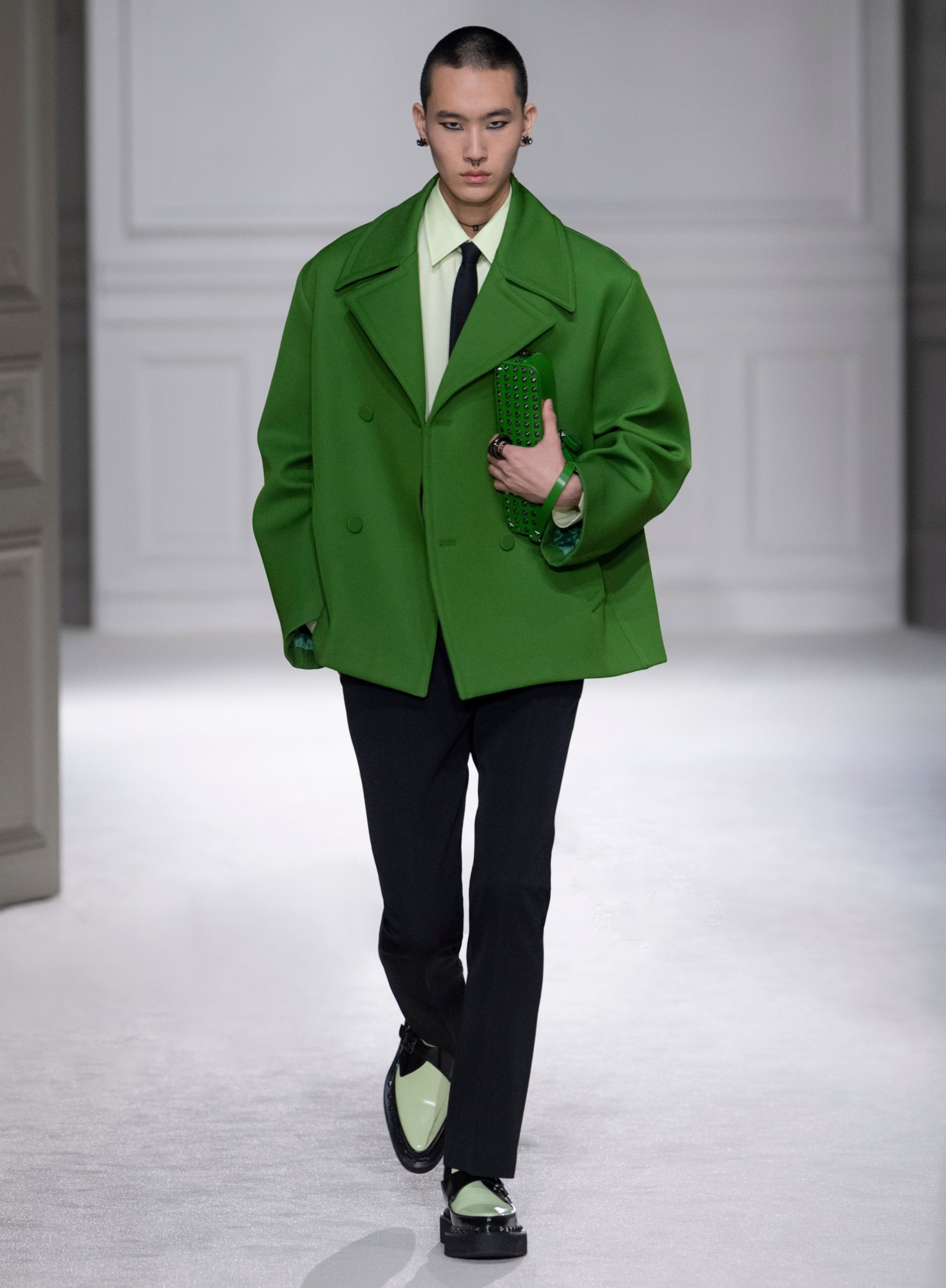

Valentino
Pierpaolo Piccioli titled his latest collection ‘Valentino Black Tie’ – an exploration, the Italian designer said, of the dress code that familiar to both schoolboys and corporate adults. His end goal was to liberate the tie from its uptight connotations, which it transpired was down to his teenage daughter raising his wardrobe for a suit and tie, for a night out with her girlfriends. The Italian designer found himself surprised by what his Gen-Z kid was interested in — aren’t young people supposed to be into hoodies and sneakers? Clearly not. The incident became the impetus for his mission to shake up the classicism of the shirt-and-tie, explaining that ‘an instruction can become an invitation… archetypes can be re-imagined, and a power in the familiar can come from its rediscovery in a new context.” Hence why every single look in this collection featured a tie and shirt collar, even though much of it could hardly be described as buttoned-up — the casting helped; models brought a punkish attitude to the gilded halls of the Hotel Salomon Rothschild with their face tattoos, buzzcuts, and multiple piercings. The result was somewhere between Battle Royale and the apex of haute androgyny: Yves Saint Laurent’s Le Smoking. White shirts and black ties were worn with very-Valentino ostrich feather capes, graphic monochrome polka dots (something of a trend this season), dusky pink sequin robes, micro-length skirts, and transformed into billowing gowns with incendiary slits — all of which were grounded by heavyweight military boots. “Signifiers are re-appropriated, transforming into different garments,” the show notes continued. “The tie is untied, unfettered, sliding between the form language of clothes, between day and evening.” OA
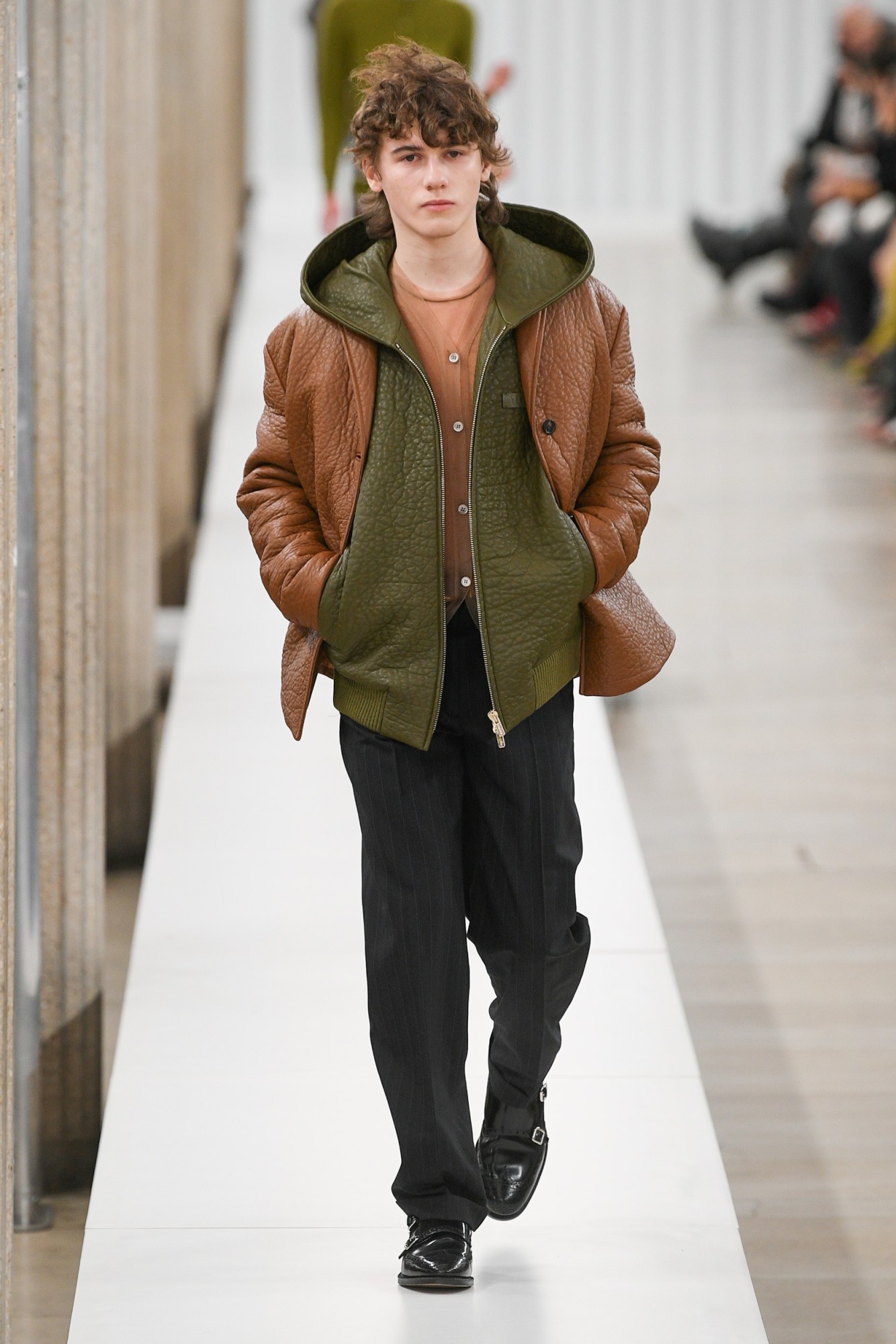
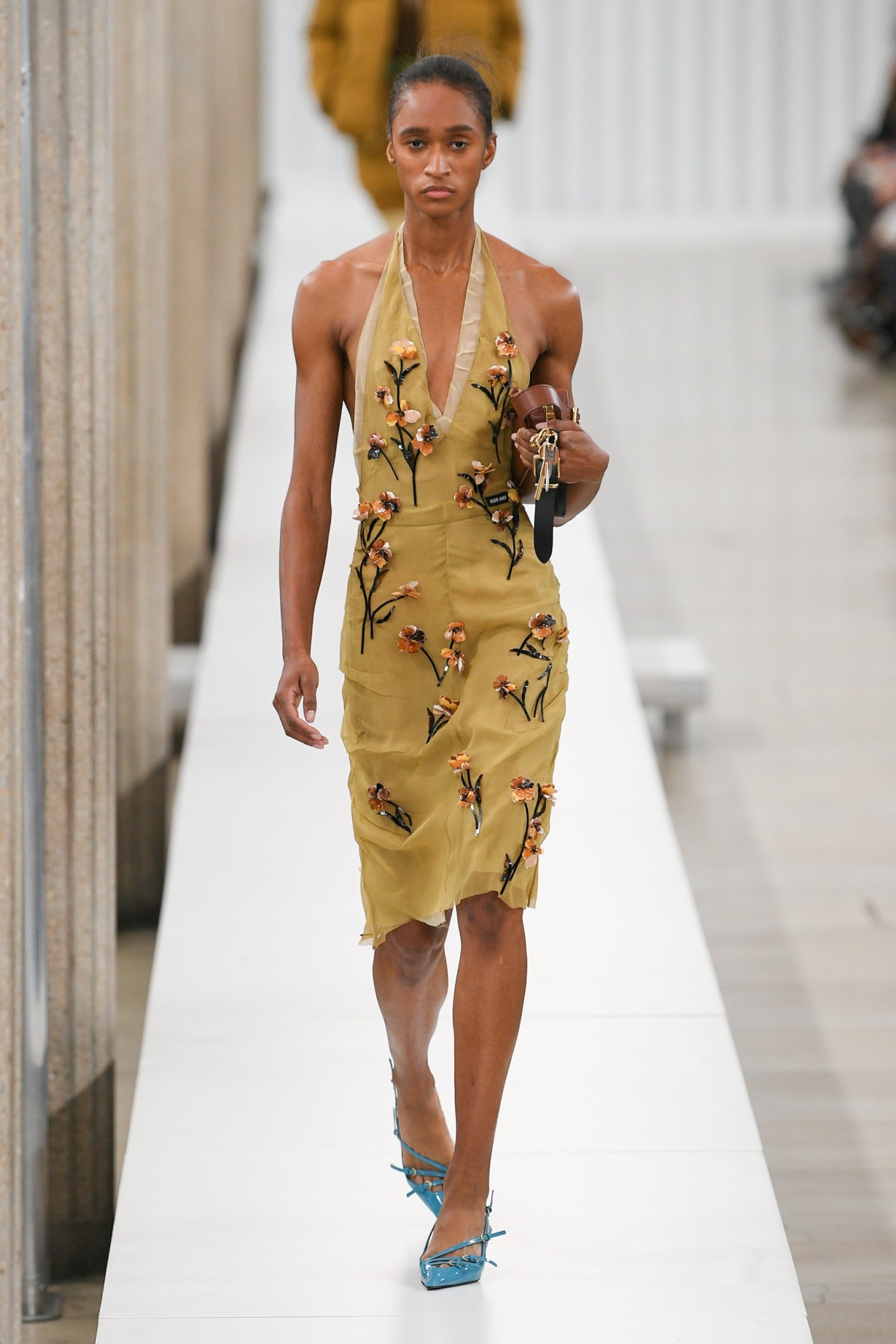
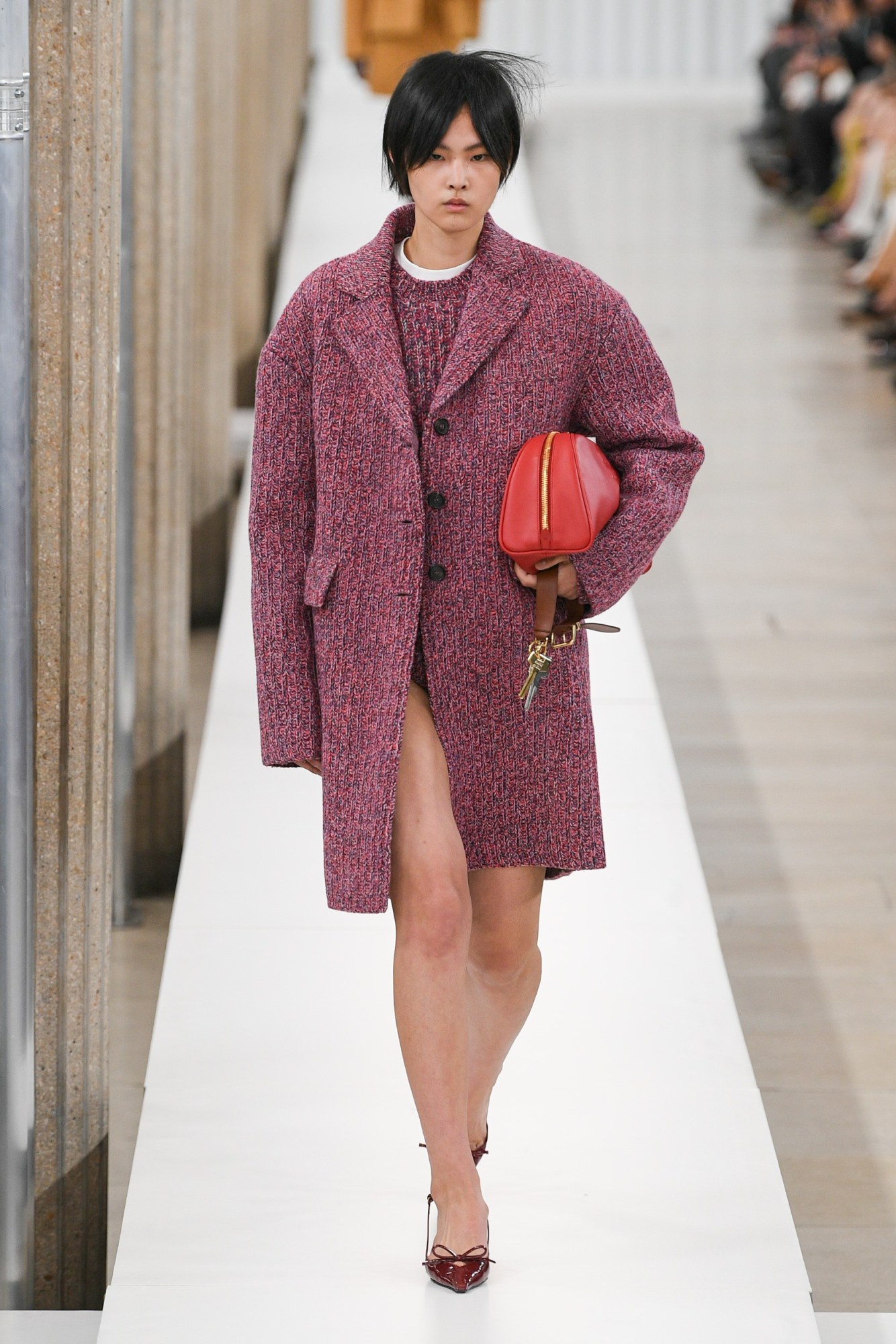

Miu Miu
Just when everyone was at the end of their tether, exhausted and slightly frazzled from a month of shows and perhaps slightly disillusioned by the contents of them, Miuccia Prada came along on the last day of Paris Fashion Week and put on a Miu Miu show that reflected the audience, just as much as it did the universal denominators of womanhood. You see, for some of us who had slightly given up on blowing out our hair on that last day, had spent the morning stuffing our suitcases and lining up our travel-essential cosies to board the Eurostar, keys on hand to get us back home — the show felt like vindication. Sometimes, the rigmarole act of dressing up can feel exhausting, especially under the glare of fashion week lighting and the phalanx of street style photographers. Sometimes, our hair is out of place, our clothes are slightly unbuttoned, and, yes, even people who get dressed for a living can sometimes look a mess. The Miu Miu show seemed to suggest that it’s OK, that not everything has to be influencer-perfect. Being a woman is hard — and whoever came up with that line about multitasking was a liar. Just when we needed to hear it, it seemed to say that there is an elegance to looking slightly askew and frazzled. Read our full review of Miuccia Prada’s standout show here.
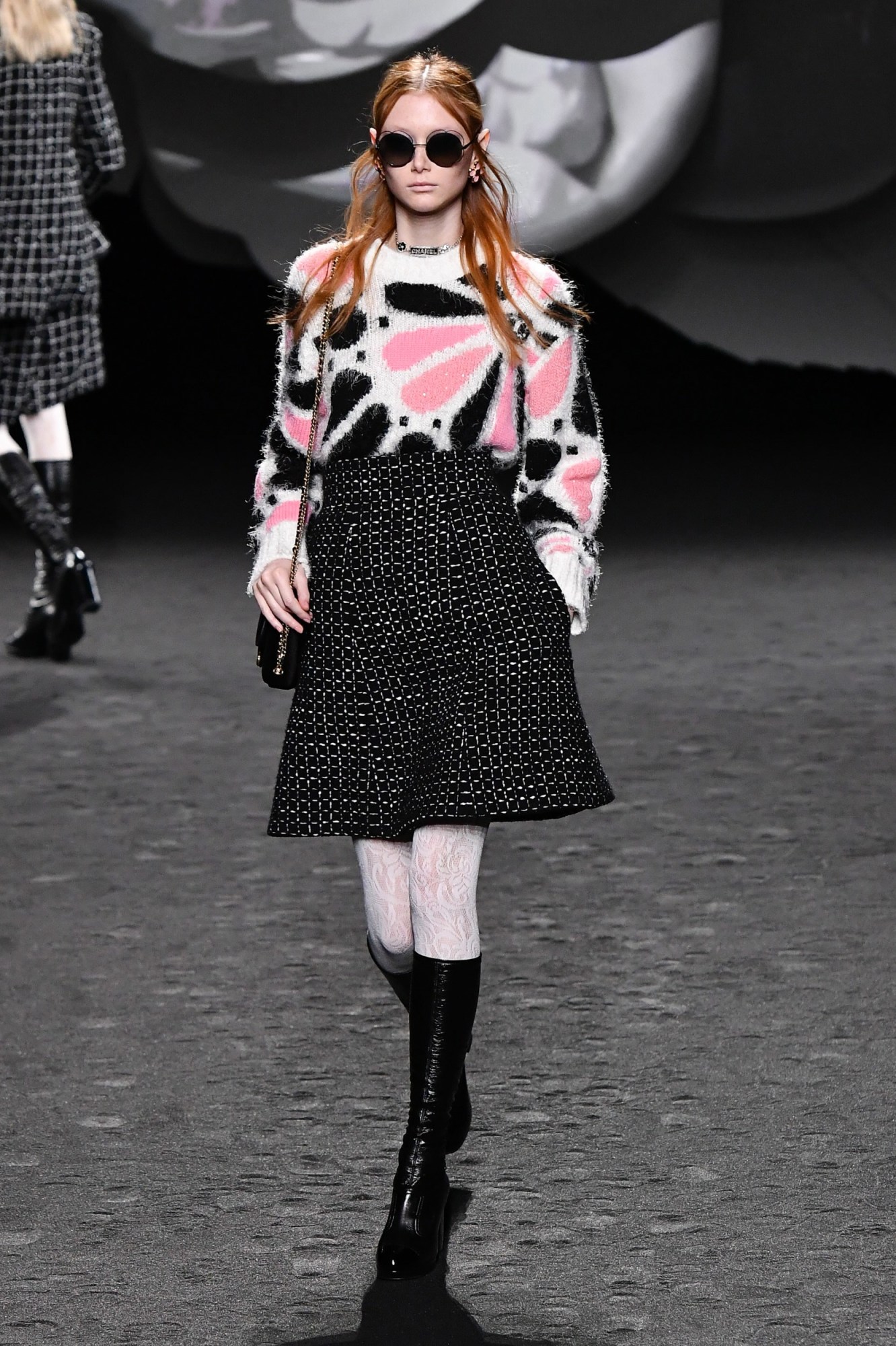
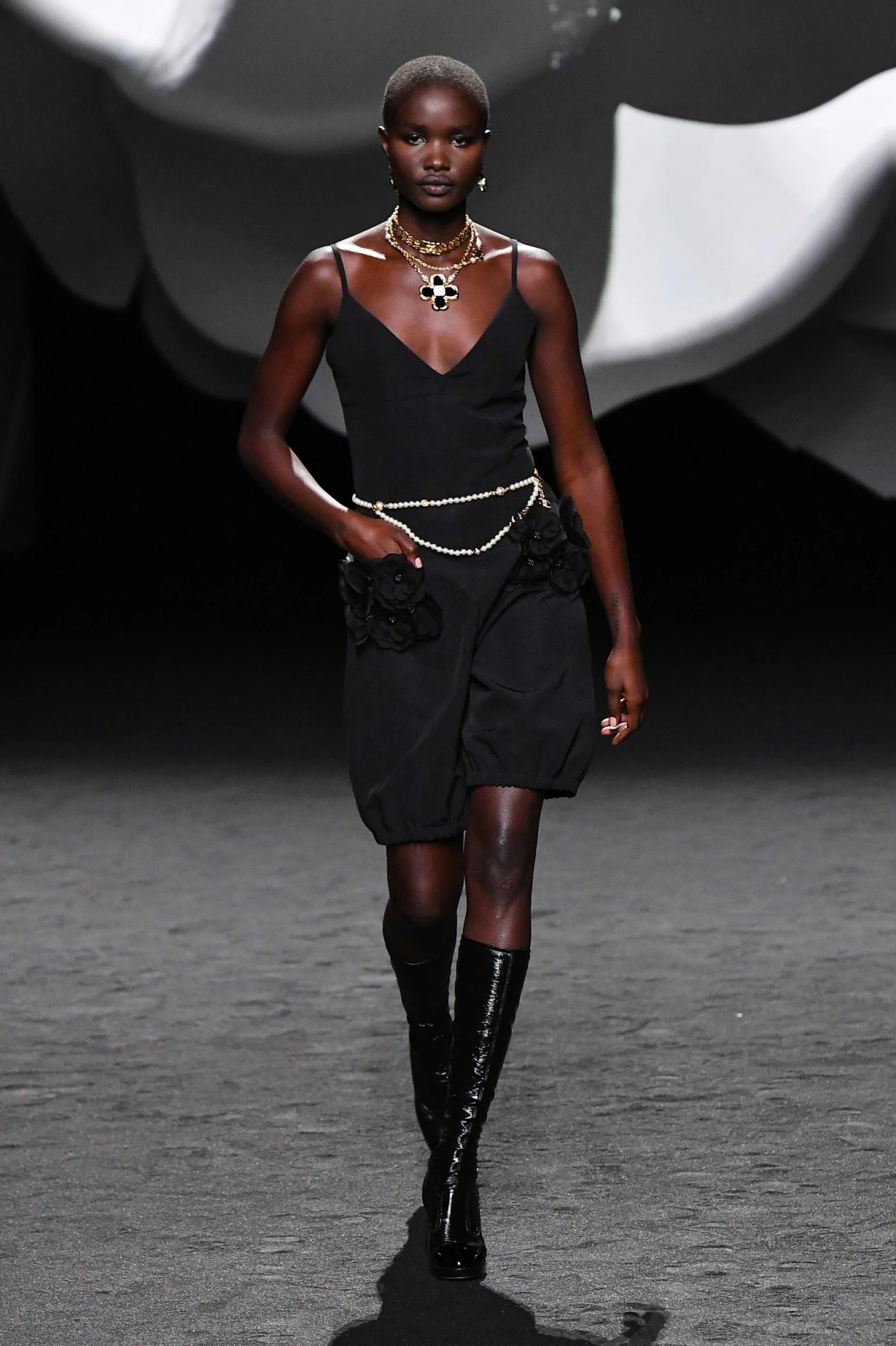
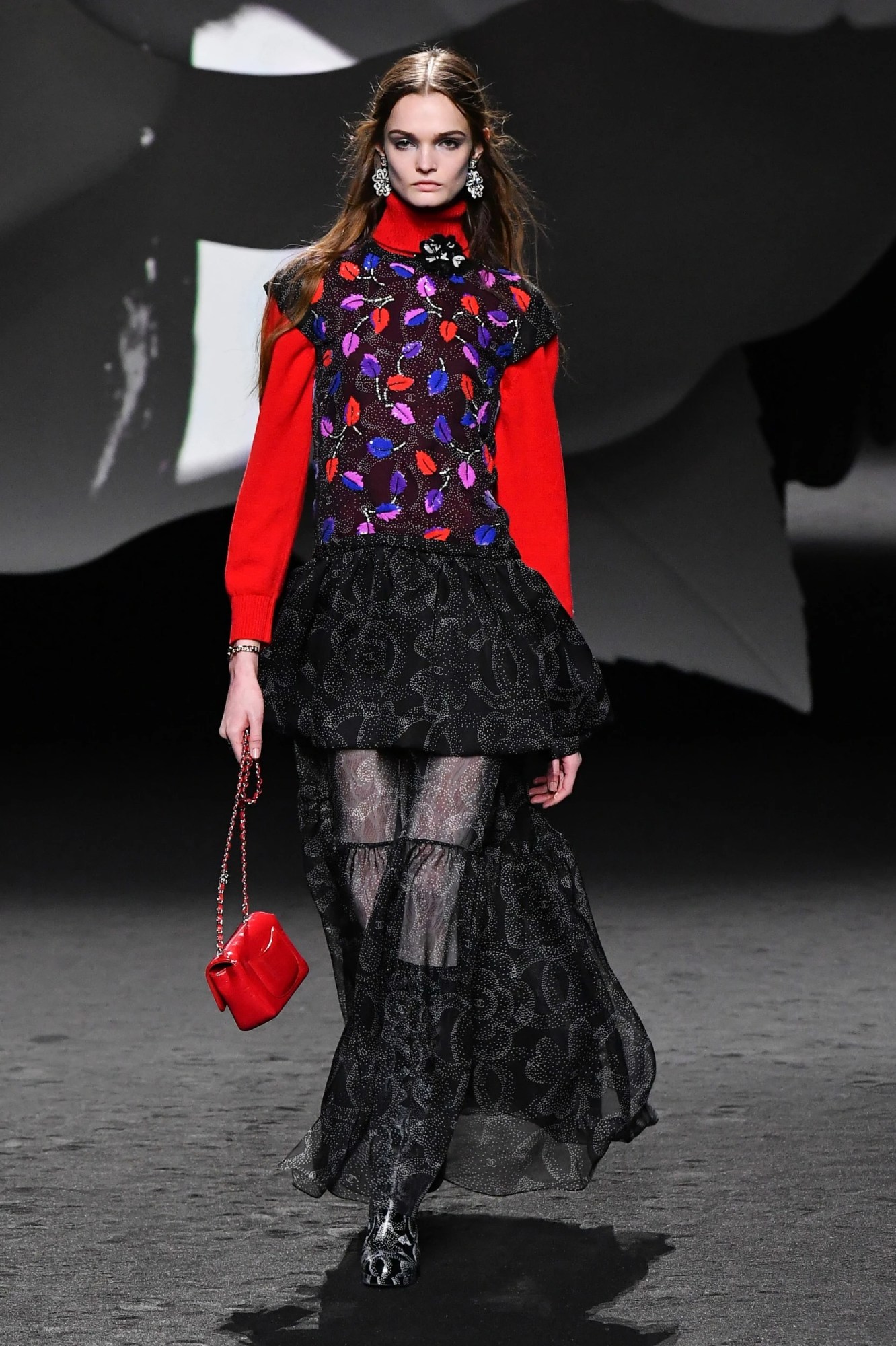
Chanel
In case it wasn’t evident from the giant sculptures that formed the centrepiece of the dim-lit venue, Chanel’s latest show was all about the camellia. It’s the flower that Gabrielle ‘Coco’ Chanel was first given in a bouquet by her polo-playing lover, Boy Capel, and made its way onto the lapels of her tailoring exactly a century ago, in 1923. You may recognise it from the packaging of Chanel’s black shopping bags and boxes, or upon closer inspection, from the silk linings and gold buttons of its tweed suits. It’s one of those mythological Cocoisms that the fashion house has built an alphabet from — bouclé tweeds, quilted leather bags, monochrome, ropes of costume jewellery, two-tone pumps, the number five — and it was the latest strain of that illustrious lexicon that Virginie Viard chose to focus on, blowing it up to towering heights and honing in on the delicacy of each of its 25 petals. “The camellia is more than a theme, it’s an eternal code of the House,” explained Virginie in a statement, apparently before confiding, with a smile: “I find it reassuring and familiar, I like its softness and its strength”. Read more about how the designer took Coco’s favourite flower to the dark side here.
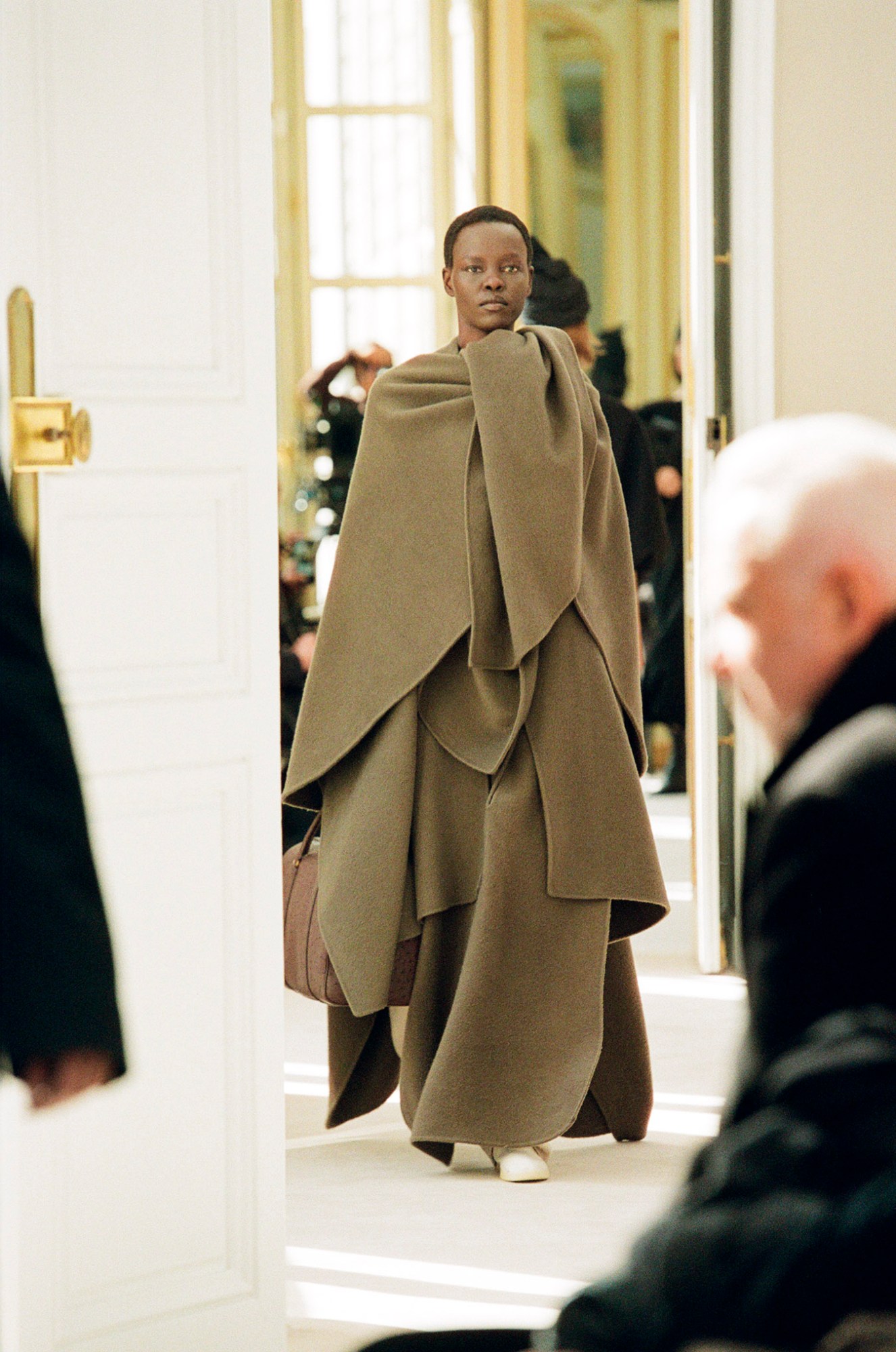
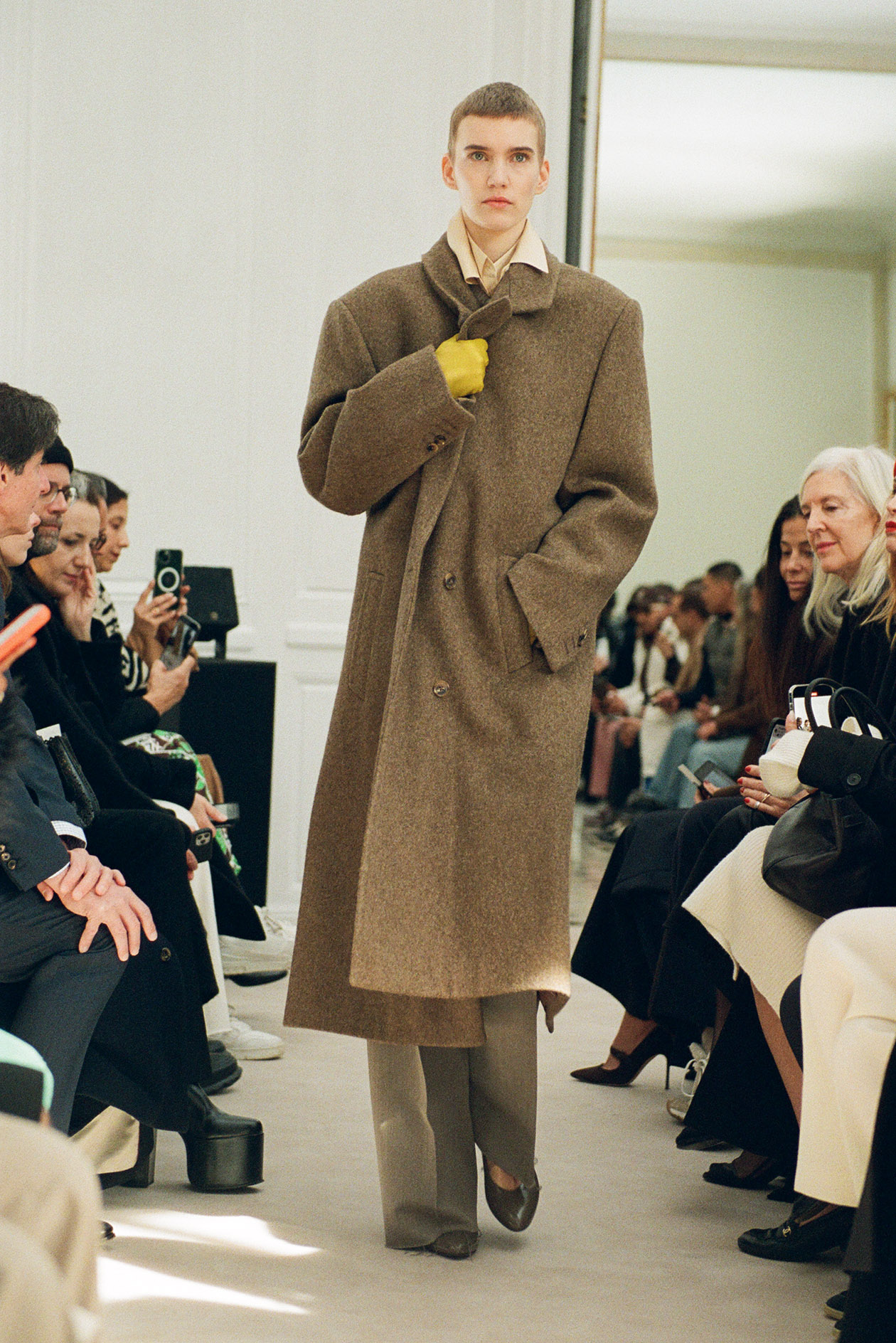
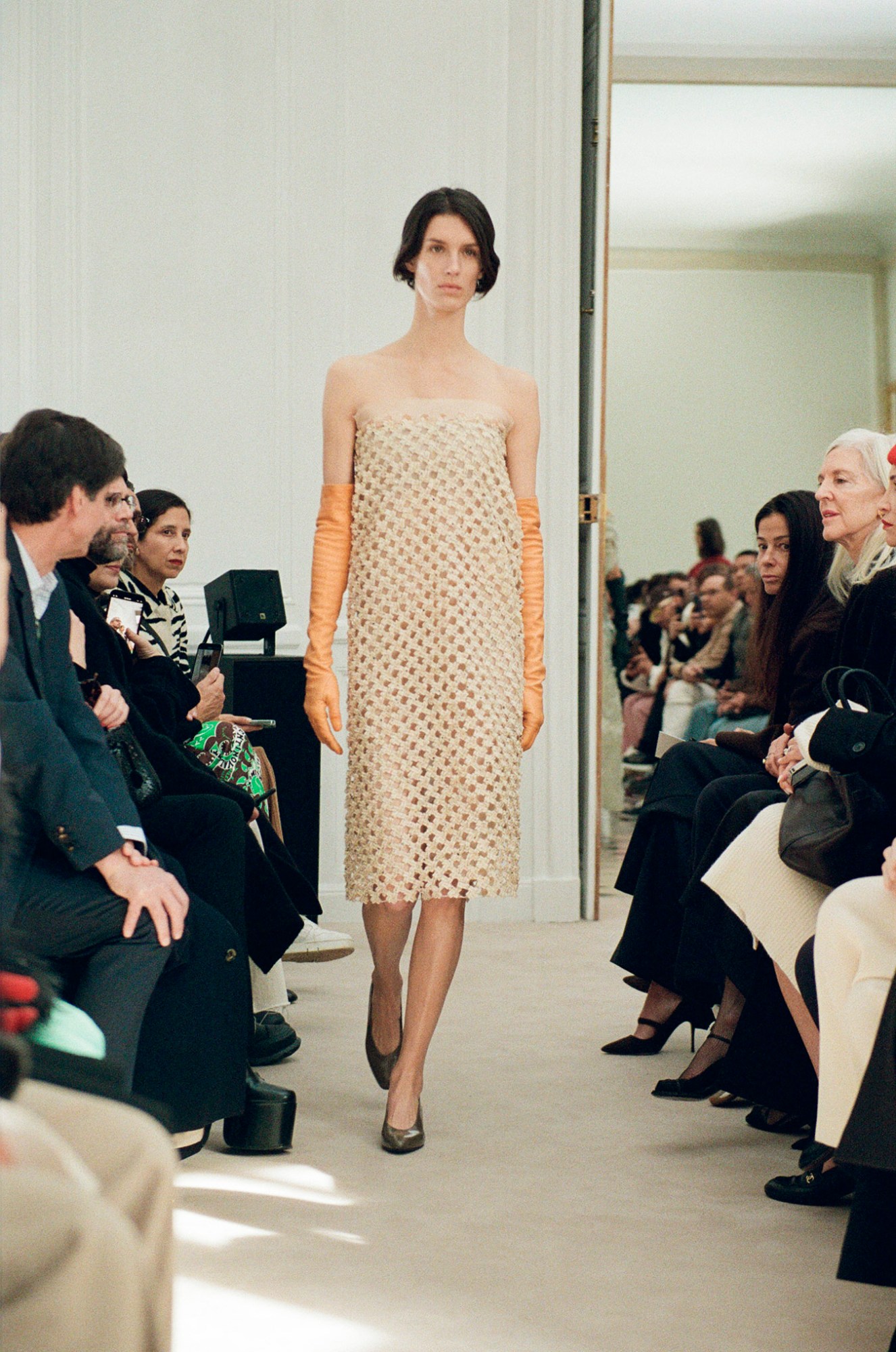
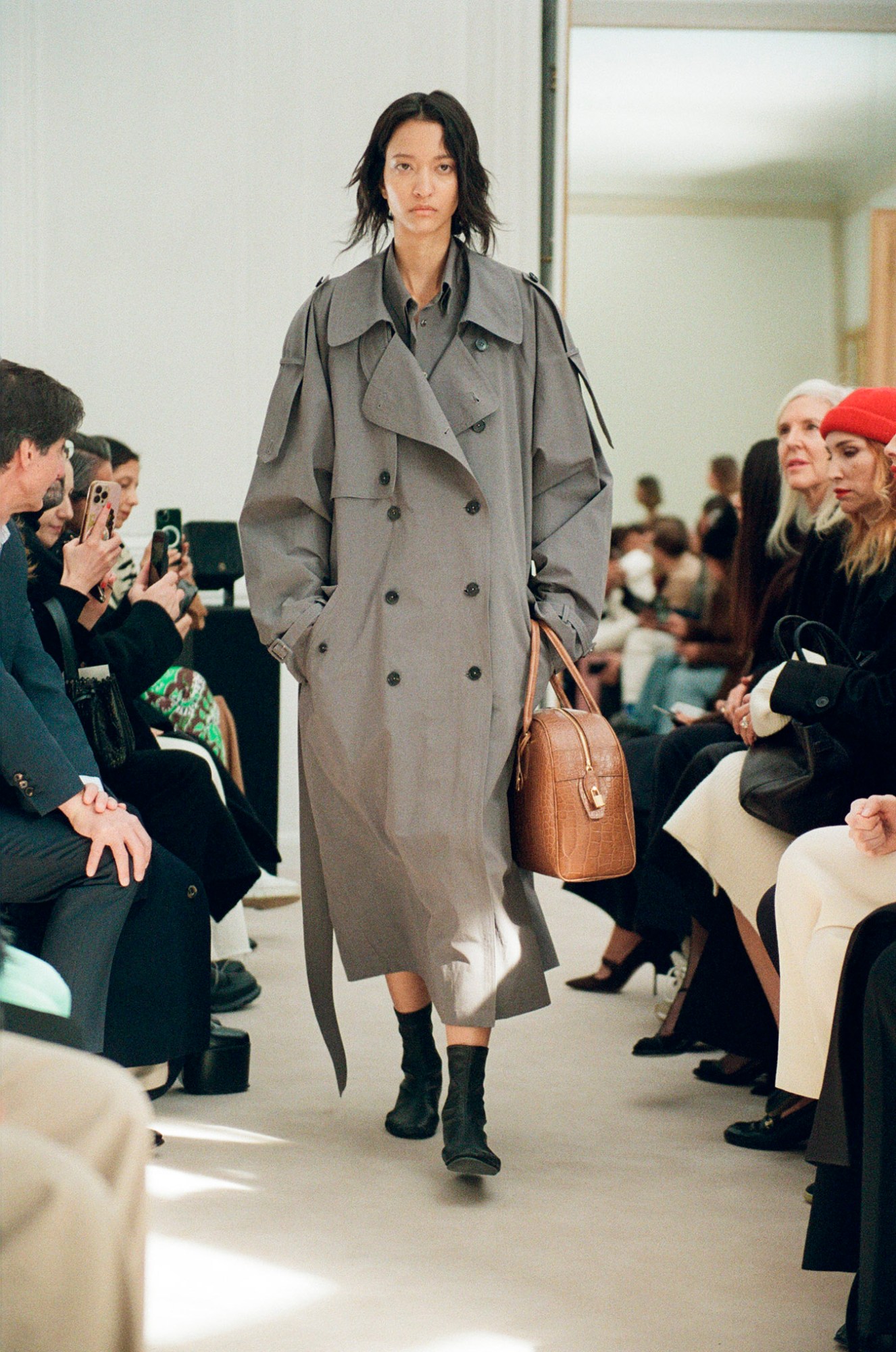
The Row
When the rest of the fashion week calendar is feeling the pressure to make shows bigger, brighter, more filled with stunts and big names to draw in headlines, The Row always resists the pressure to conform. Rather, the pared back label does what it does best: beautiful, well-made pieces, impeccably styled. This season was no exception. For AW23 The Row did what The Row does best: a muted colour palette of blacks, whites and beiges, a celebration of the drapery and tailoring The Olsens have become experts in. But to say this was simply more of the same would be a misunderstanding of the house, their vision and the power of their minimalism. Instead, this season they took the tenets of their design and elevated them: proportions were exaggerated, textures were layered in bows and florals and leathers, pops of colour appeared in evening gowns, yellow opera gloves and bright red wool. This was letting the clothes speak for themselves in its most distilled form – and it worked. RL

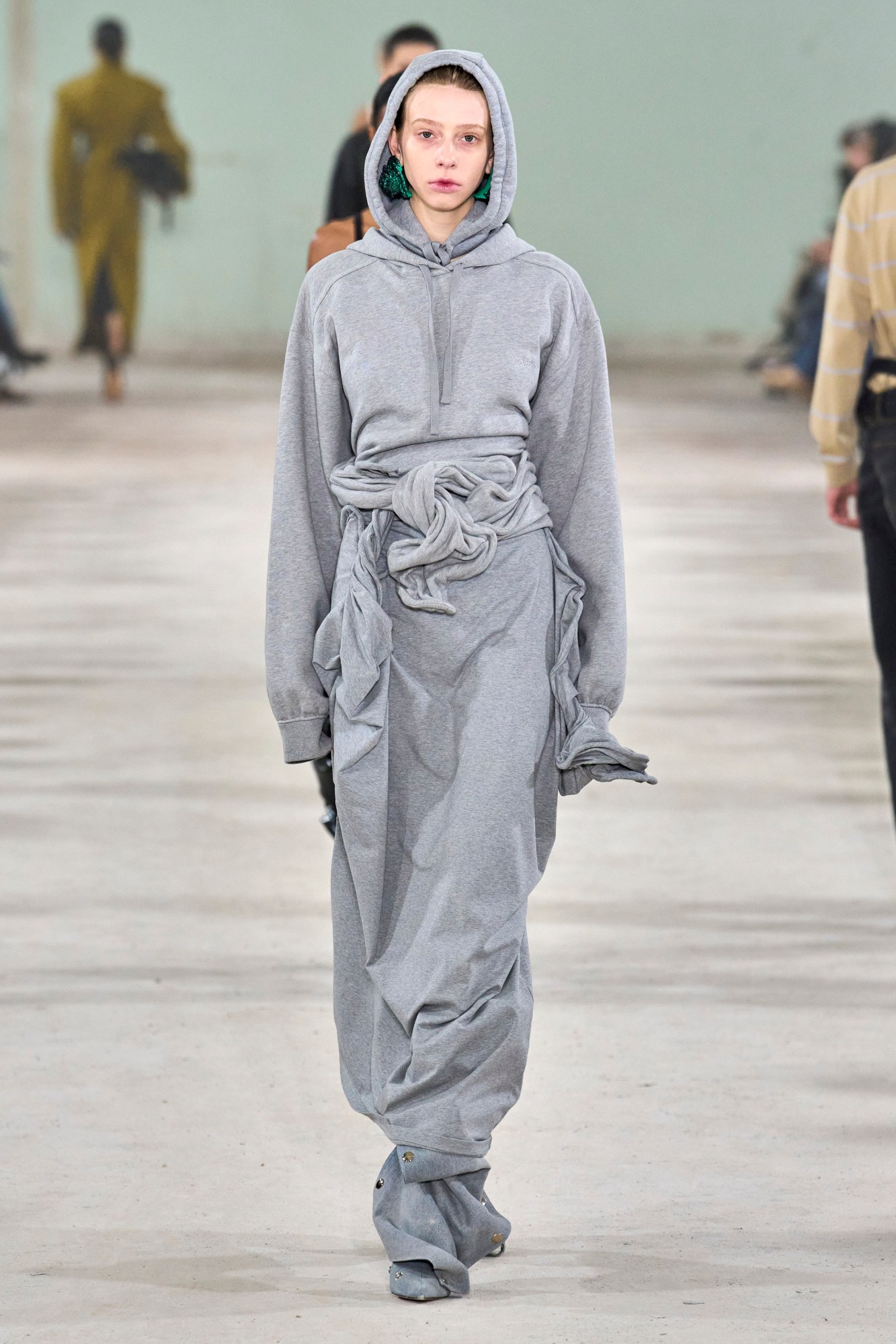
Y/Project
Returning to the womenswear calendar for the first time since before the pandemic, Glenn Martens’ AW23 offering for Y/Project showed the designer’s talent in melding an almost sleazy sexiness with genuine craftmanship, resulting in some seriously enviable pieces. His work at Diesel has clearly impressed upon the designer’s own brand, with denim taking the fore across the collection. Light blue 90s jeans were slashed at the upper thighs into chaps with built in briefs or featured ribbons of buttoned up panels that blended into a gradient with the baggy boots below. Elsewhere denim was ripped into shreds and distressed into fringed strips that grew across tweed coats, heatmap dresses and sharp suiting like the garments had been touched by Jack Frost. Other sexy signatures of Glenn’s were featured too. Fastenings on biker jackets, white shirts and round-collar denim jackets were done up only to be slashed elsewhere, revealing the lingerie like stringy undergarments below and grey marl joggers returned from the last collection, now ruched into belts around the waists of excessively longline grey marl hoodies. A standout moment from the collection though, was the reinvention of the naked dress. Glenn of course already did a doppler effect nude body printed onto maxi gowns for his guest-designed collection at Jean Paul Gaultier. Here, though, the horniness was amped up as contorted naked bodies, seemingly in a moment of lustful passion, were abstractedly printed onto floor-hitting gowns and long-sleeve tees. TG
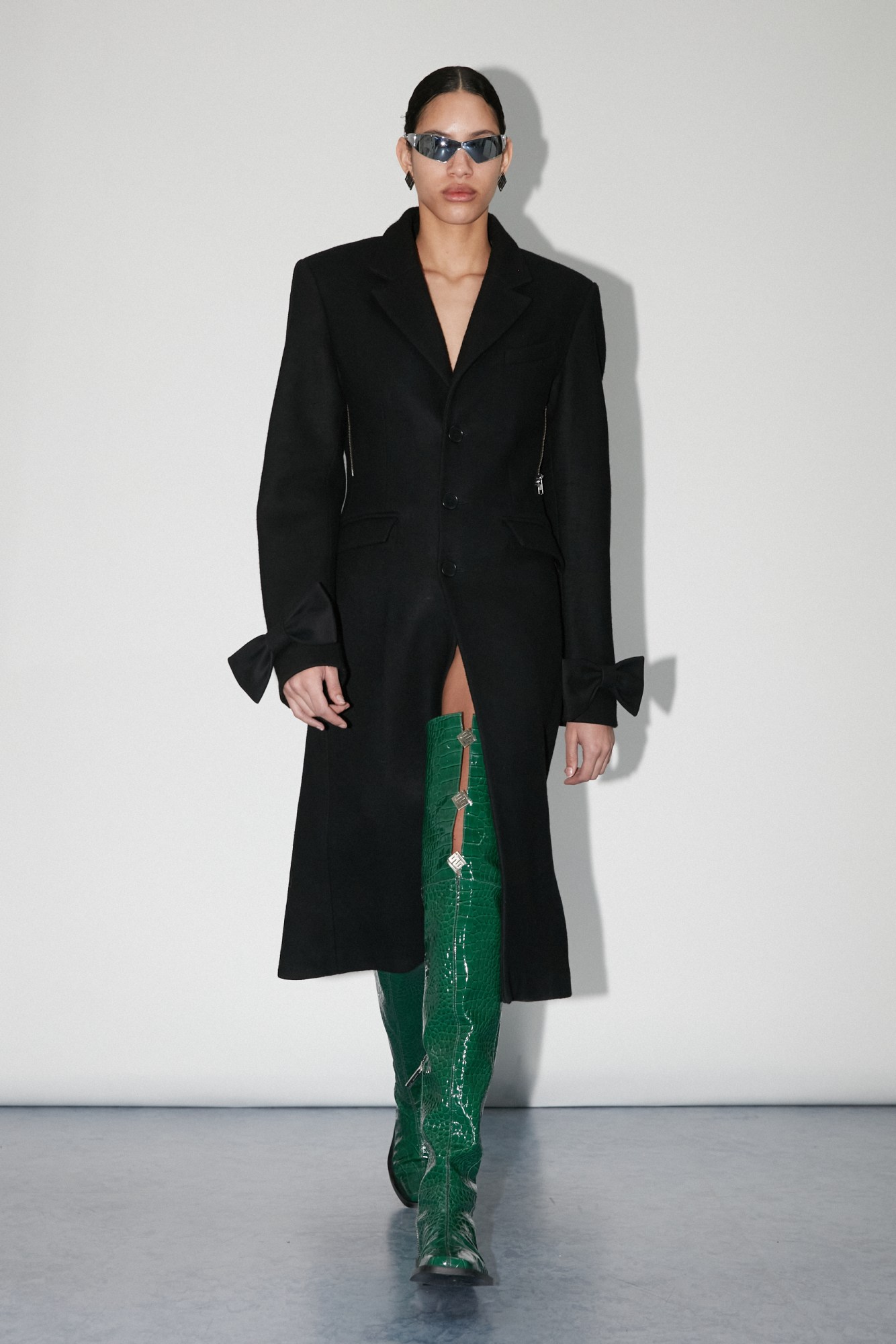
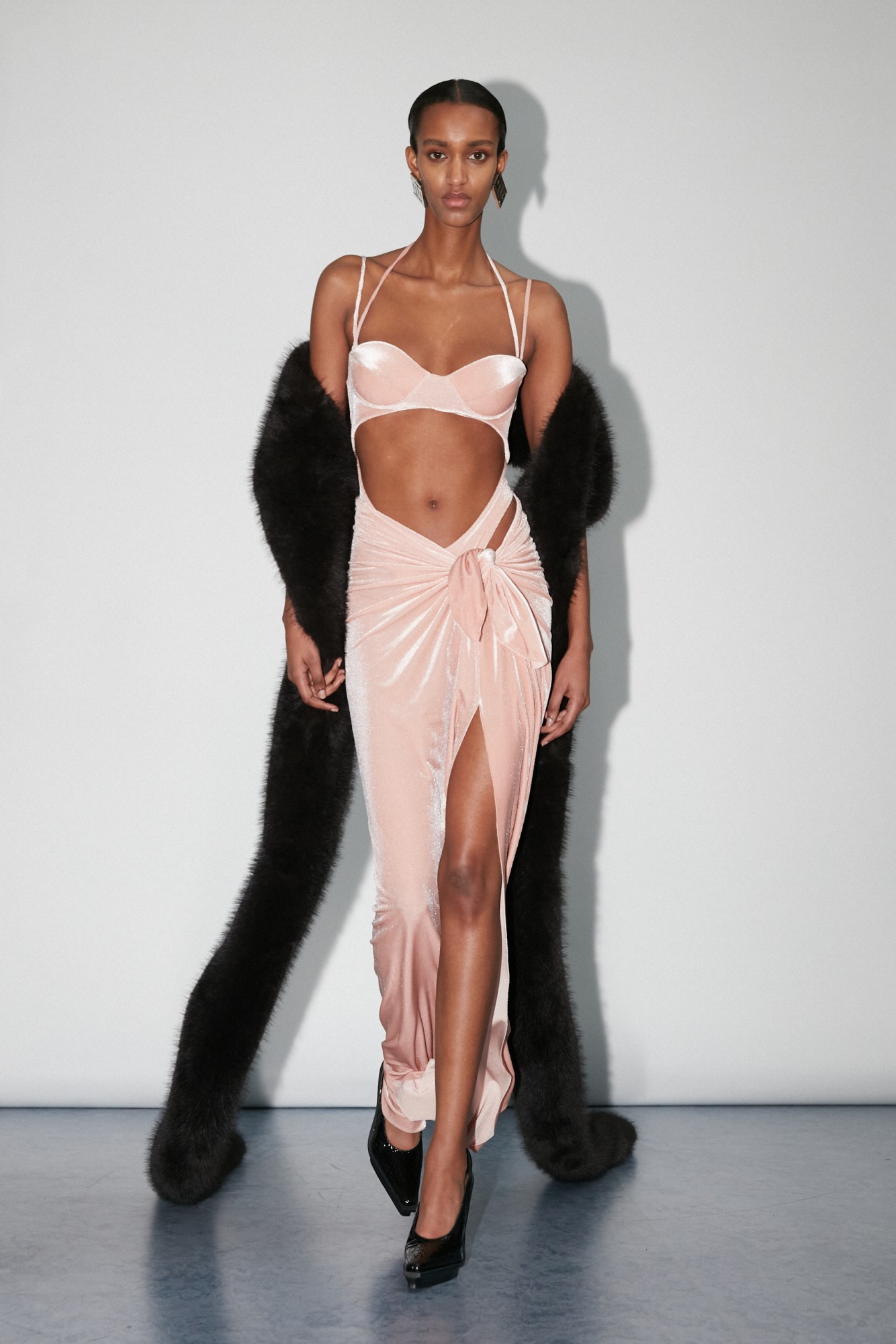
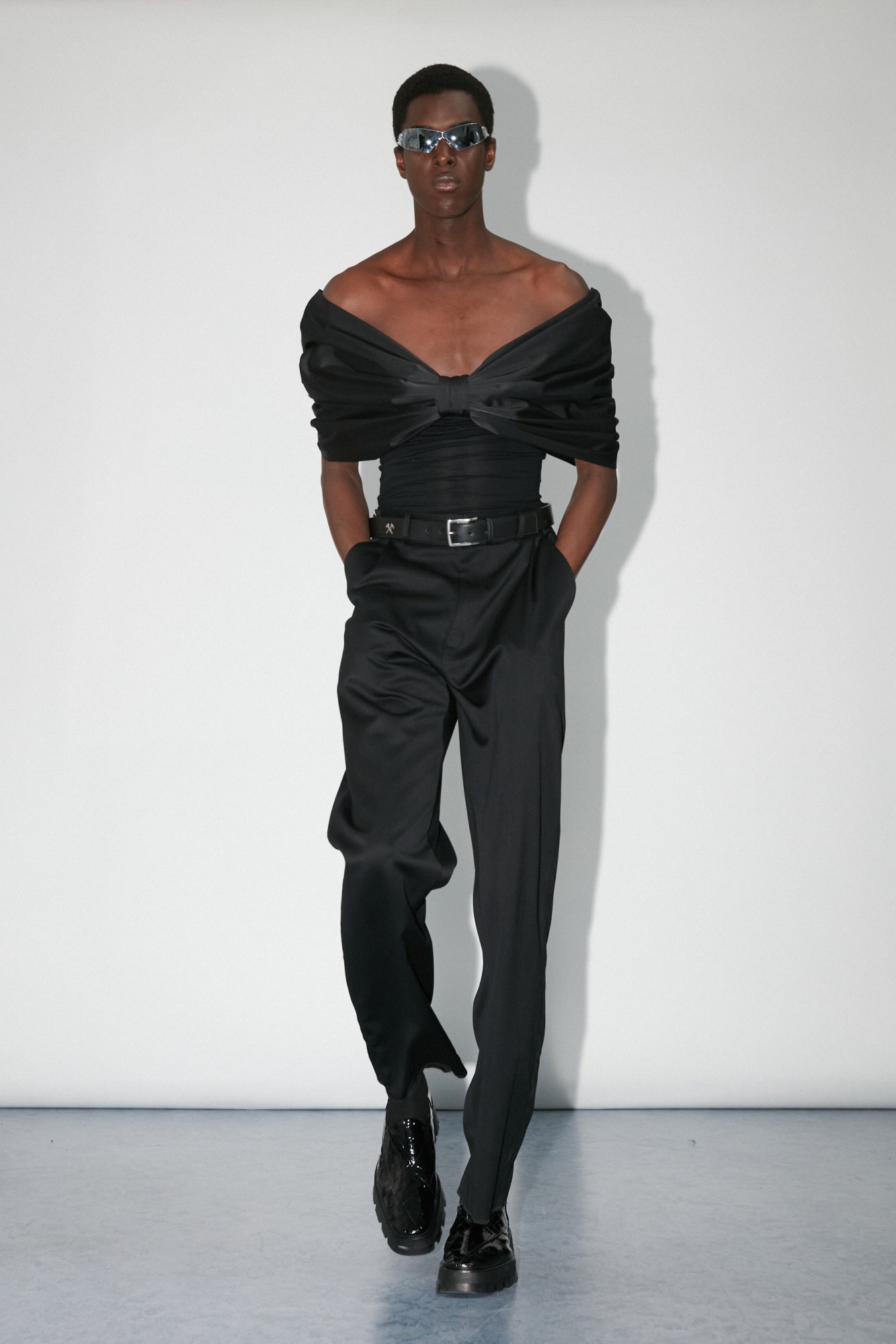
GmbH
Another set of designers joining the chorus yearning for a return to making clothes for their own sake are Benjamin Huseby and Serhat Işık of GmbH. Their motivations, however, are perhaps a little different to most other examples this season. Rather than a frustration with the fact that designers are near-on obligated to lure in audiences with visual gimmicks that overshadow the actual work on show, the fatigue they’ve responded to is the implicit expectations of them as POC designers to create work charged with narratives tied to their identities, rather than work that simply showcases their skills as fashion designers. “If everything is political, does everything become meaningless?” the pair question in an open letter accompanying Autumn 2023, their intentionally blank-titled AW23 collection. “Instead of the personal narratives, politics, and meanings we normally weave into GmbH collections and garments, we wanted to explore the freedom of pure aesthetics, pure form and silhouette,” they continued, shirking from the emotional labour they’ve been burdened with. “What happens if we allow ourselves the illusion of being designers who do not have to discuss their identities, or trauma as part of a collection, just like white designers can?”
The answer is a collection that indulges in a notion of fashion defined by poetic elegance. Dancers from City Ballet Corp wore louche, pearlescent nightshade suiting with trailing satin sashes and faux fur garlands draped about the arms. These trails were then echoed in blazers constructed with the brand’s signature off-shoulder wrap detail, with waist-cinching bands fastening into twee bow ties at the lower midriff. Elsewhere, the dainty motif recurred at the hems of sleeves of columnar wool coats or were blown up into gigantic droopy bows fixed to the tops of bateau-neck blouses. Their fawning campiness was counterposed by the vampish theatricality of tailed faux-fur bombers, the severe elegance of slashed, diaphanous evening dresses with Möbius draping at the bust, and the all-out sexiness of tie-fronted velvet dresses with yawning cut-outs at the abdomen and hip. Indeed, this season brought what was easily the pair’s most accomplished womenswear offering to date – along with an extremely robust menswear selection, too. What, perhaps, made that so immediately clear was that, in stripping away the narrative packaging that their work has previously been wrapped up in, you were compelled to look at the clothes as, well, clothes – no more, no less – rather than as ciphers for broader ideas. After all, often the most convincing fashion doesn’t need broader contextualisation to prove its point – it speaks for itself, as it is. MS
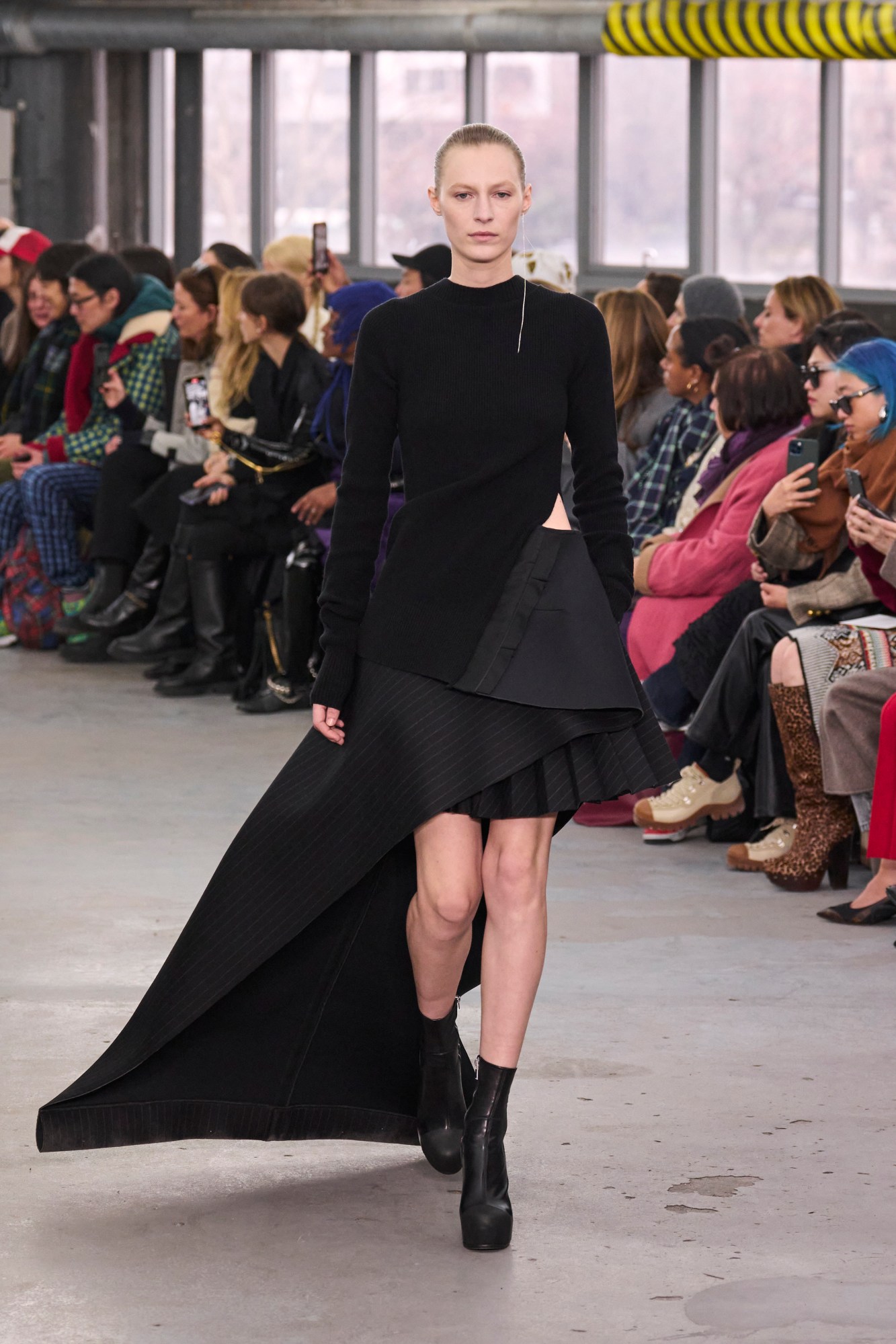
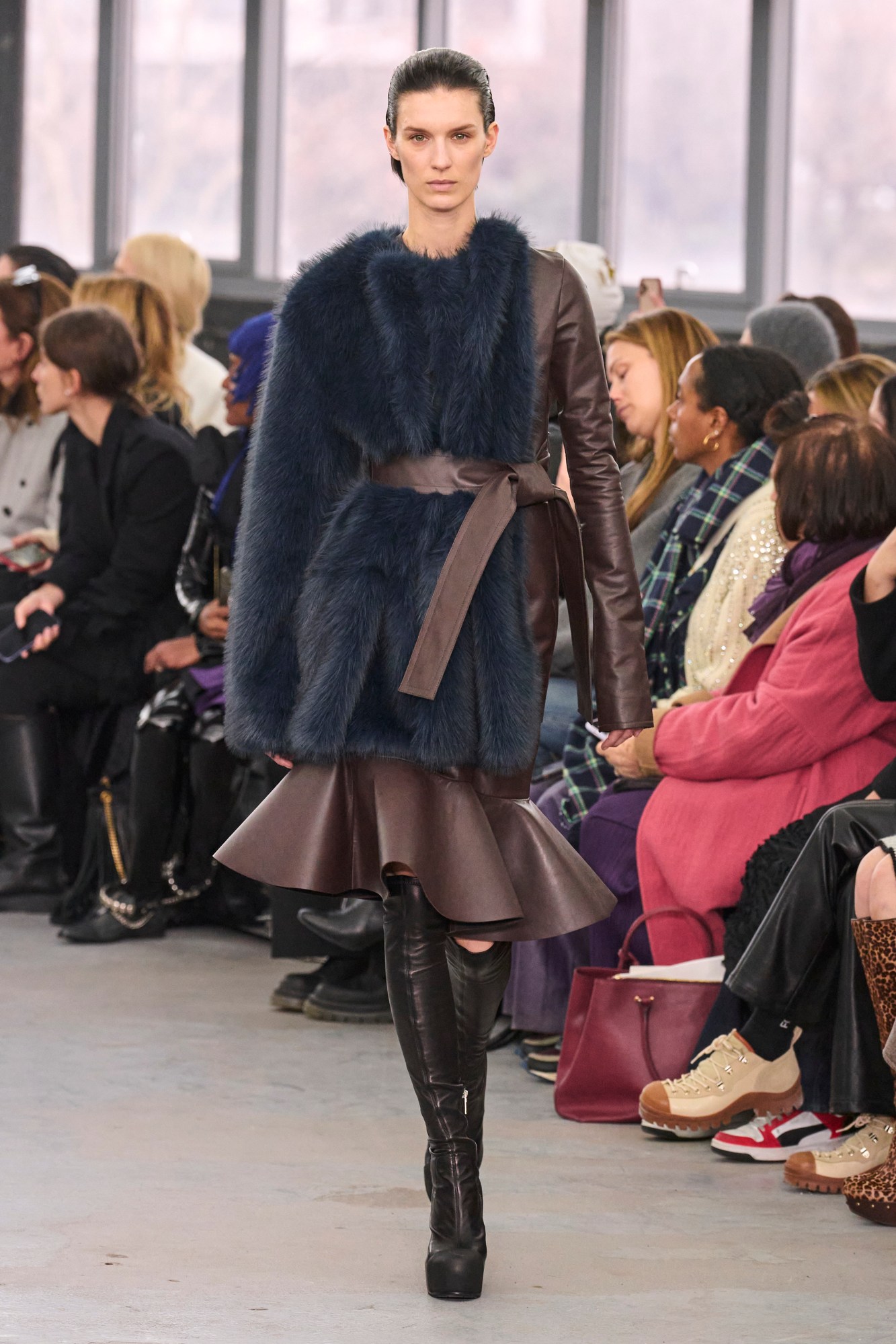

Sacai
With so many designers this season seemingly responding to a collective existential crisis around the purpose of their craft, and choosing to once again ’focus on the clothes’, one designer who hasn’t at all is Chitose Abe, the founder and creative director of Japanese label Sacai. Indeed, for her, her focus has always been squarely on the clothes she creates – which, often, are spliced together from archetypal garments in ways you’d seldom expect – think button-down dresses cut from black wool felt and pinstripe grey wool, and dusty rose jersey gowns with hems hoiked up by built-in shoulder straps, both of which appeared on the runway at her latest show. Indeed, rather than make an about-turn in her creative direction, Chitose’s latest collection was a vindication of an approach that she’s something of a pioneer of. The handbag strap construction detail was echoed in subtle grey and black pinstripe wool, while jackets in similar fabrics were slashed at the waist, creating curious mini-peplums. Tiered white crepe tops tumbled down into stiff, swishy black skirts, and asymmetrical chubby coats were crafted in about two-thirds faux-fur, then with a contrasting left side panel and sleeve in buttery leather. It’s the sort of fashion that sounds pretty mind boggling when described, but makes instinctual sense on first sight – a true testament to Chitose’s time-honed ability to take dramatically clashing aspects and create the sort of unique, directional, desirable clothes we need to see more of right now. MS
Balenciaga
Balenciaga is back. For reasons that need no explanation, the fashion house’s latest show was a reset, with the anticipation leading up to it more commonly experienced when a designer is about to make a debut. It was a bit like a do-over; a chance to set the record straight. The simple paper invitation was a dressmaking pattern, the setting itself a warmly-lit white space in the subterranean bowels of the Carrousel du Louvre shopping centre. And, though the location may have been underground, the collection felt like coming up for air. Demna – a man who needs no introduction – is a designer who has the hard task of restoring his employer’s reputation, and he is done with fashion-as-entertainment. He is going back to making clothes. Read the full review here.
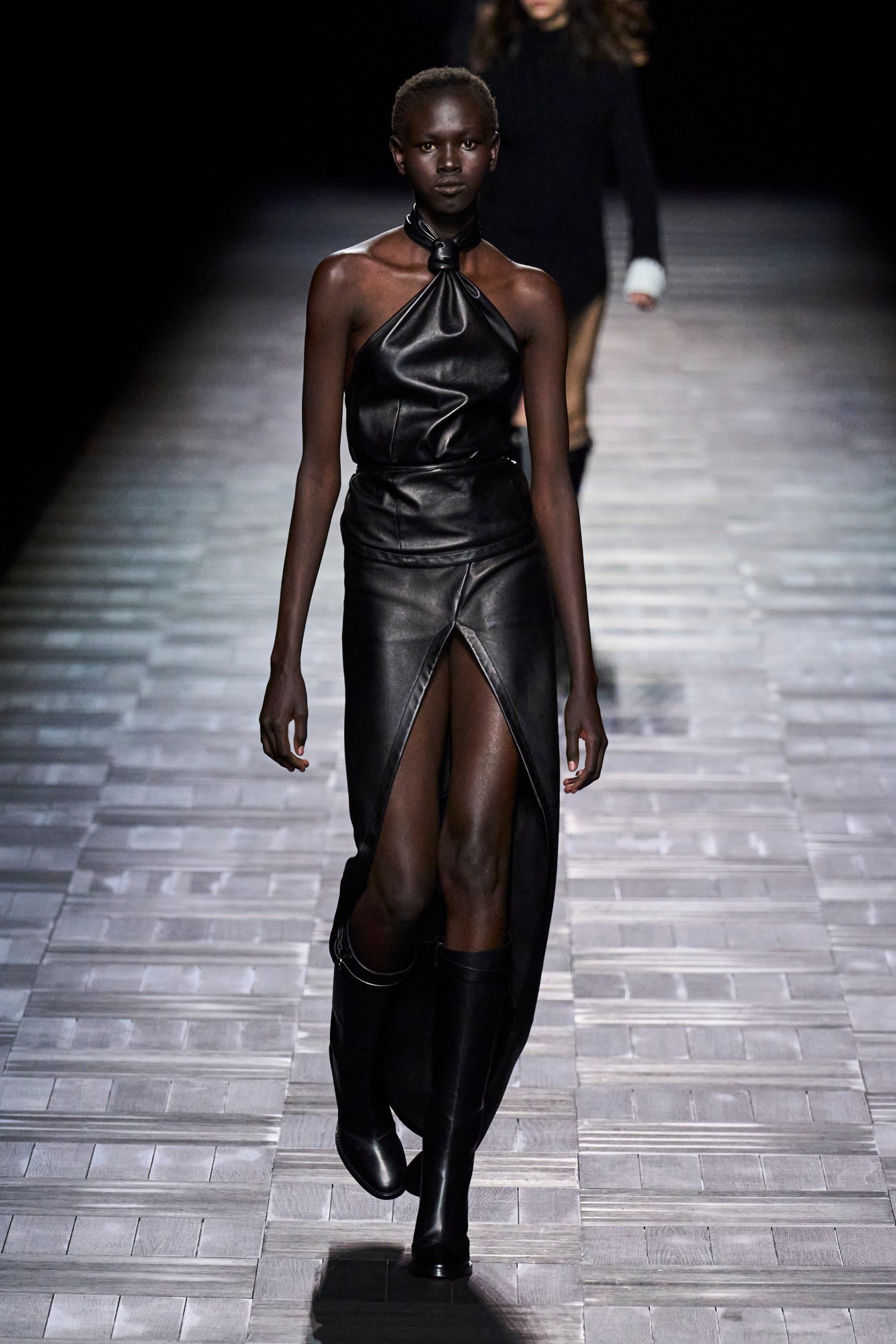
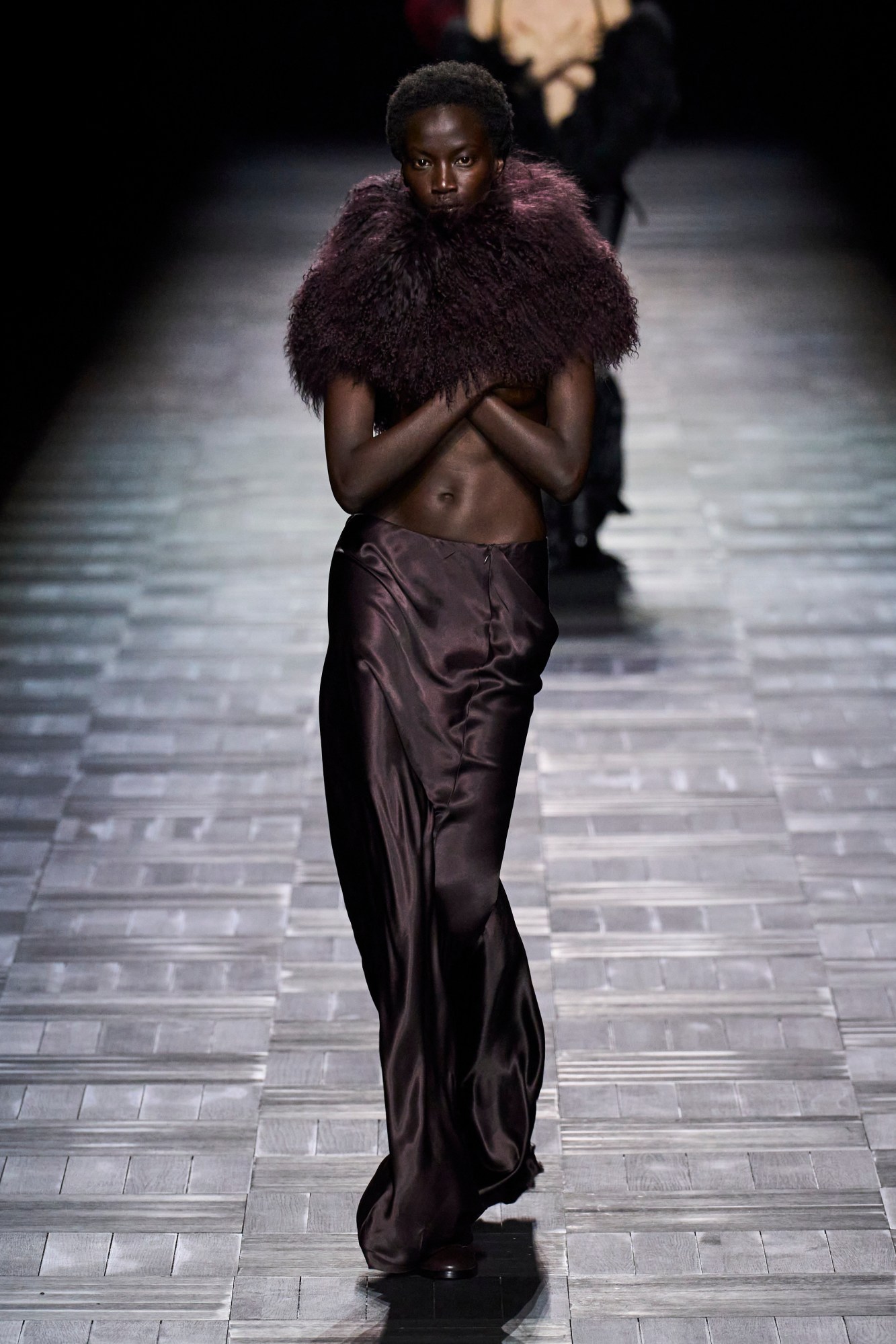
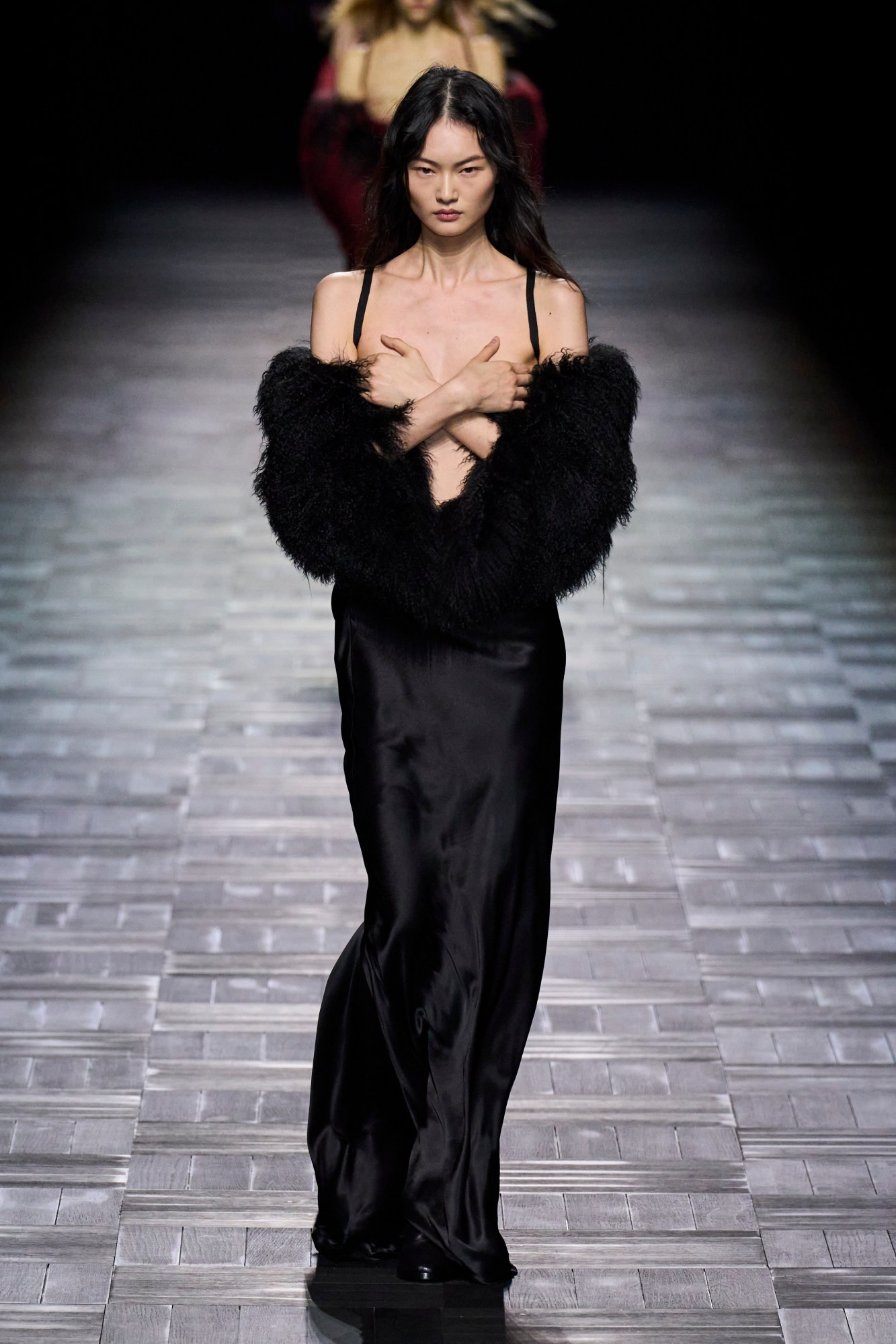
Ann Demeulemeester
Ludovic de Saint Sernin’s debut Ann Demeulemeester collection was both a love letter to the brand’s archive and a super-sexy step into the spotlight to stretch his own creative prowess. His AW23 pieces were littered with plenty of Demeulemeester staples; bias cut silk slips, the classic undone, dishevelled yet sculpted oversized suits, leather precisely slashed open to reveal flashes of skin, touselled bed head hair, sheer everywhere, fur everywhere, stomp and sex appeal. But Ludovic put his own spin on the classics, ushering in a new era. Instead of shirts, models walked the runway covering their chests, free the nip style, or revealed swathes of skin hidden behind sheer billowing material or under huge fur cropped jackets. The show was also totally gendy-neutsch, of course, featuring nude playsuits for men and women, and matching men and women’s alternates of the same streamlined leather knee-high boots, the same massive shearling handbags. The result was a celebration of doubling; the past and the present, masculine and feminine, revealing and covering, alluring and sensual whilst also powerful and refined. “It’s my way of saying that after this first step I’ll be spreading my wings and then be able to express myself,” Ludovic said of his first show. If this is step one, we can’t wait to see what comes next. Hopefully more nipples. RL
Alexander McQueen
Review to follow.

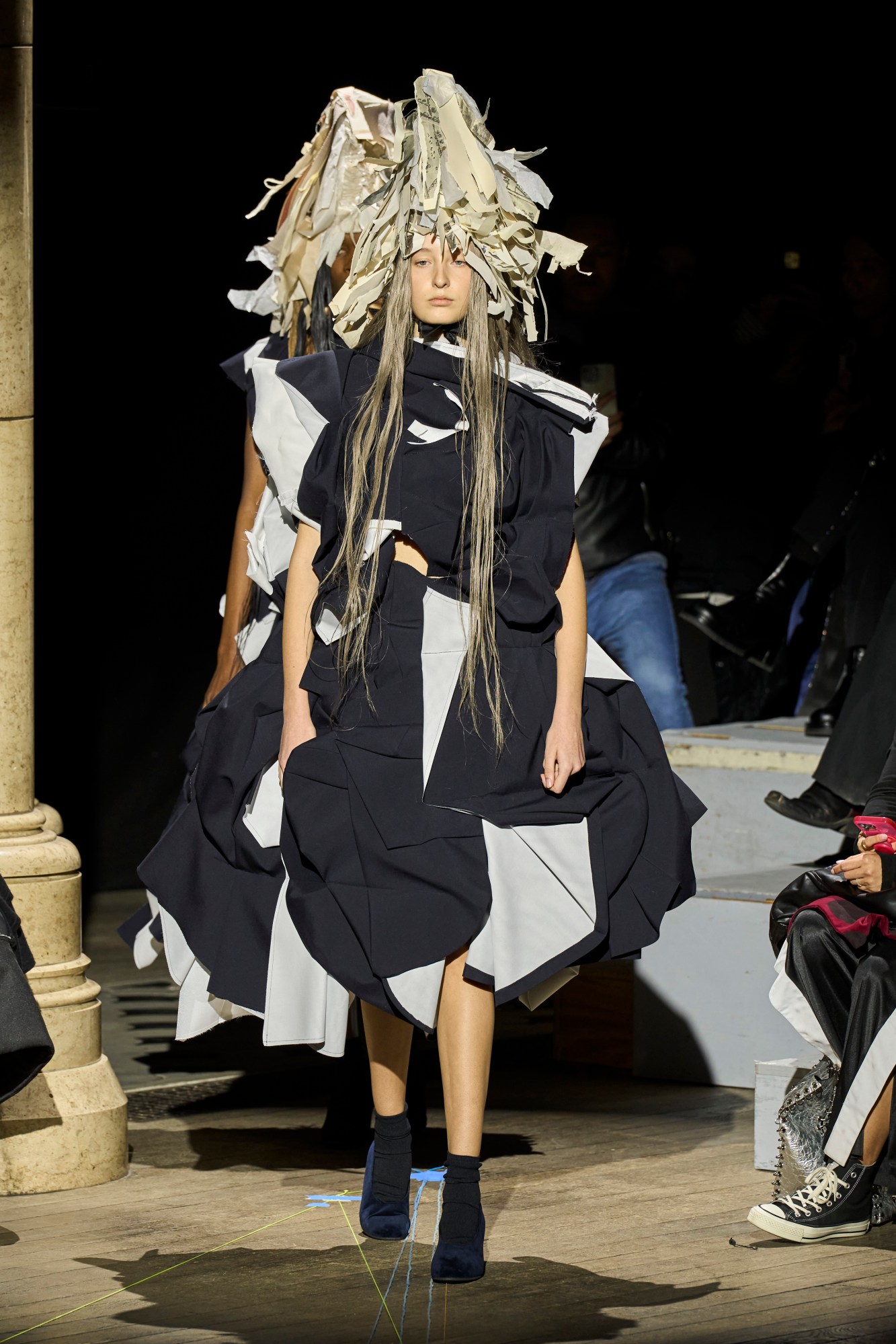

Comme des Garçons
At a time when so much conversation is being had around the need for designers to pare back on all the accoutrements around collections and focus instead on the actual clothes themselves, there are few better books to take a leaf from than Rei Kawakubo’s. Since the early 80s, the designer’s collections for Comme des Garçons have refused to pander to audience expectations of understandability and, increasingly, entertainment value. Rather, she is a designer who, each season, articulates the ideas she has through cloth alone – no set gimmicks, no popstar media mobs, just world-building, fantasy-fuelling clothes. This season was, as expected, no different. The designer chose to “return to the source”, as the collection’s show notes read, channelling “a feeling of wanting to go back to the starting point” – a widely-felt desire to turn back time. What exactly she was hoping to return to is, again expectedly, an intentionally guarded mystery, but there was indeed an elemental (though by no means minimal) sensibility to the looks shown. Overblown square-shouldered felt and faux fur dresses with spherical hems had a geometric starkness to them, while sleeveless columns of black nylon sprouted fringes of white tulle, resulting in the visual effect of stuffing tumbling out of a pillow. Floral embroidered satin cocoons came in plush pink satin, and were worn with polychrome pipe-cleaner hats, and a complementing pair of black cuboidal silhouettes came with jaunty bicornes twisted from locks of blonde hair. Trying to code Rei Kawakubo’s intentions here will probably result in as many results as there are people trying to unpack them, but that is, in and of itself, a testament to the power of her vision – rather than rely on the contextualising trappings of wordy press statements and bombastic set design, the clothes she creates do a strong enough job of conveying what she wants to say. Whether we all get it or not is beside the point given that, over 40 years after she first started, it’s now abundantly clear that plenty of people do. MS
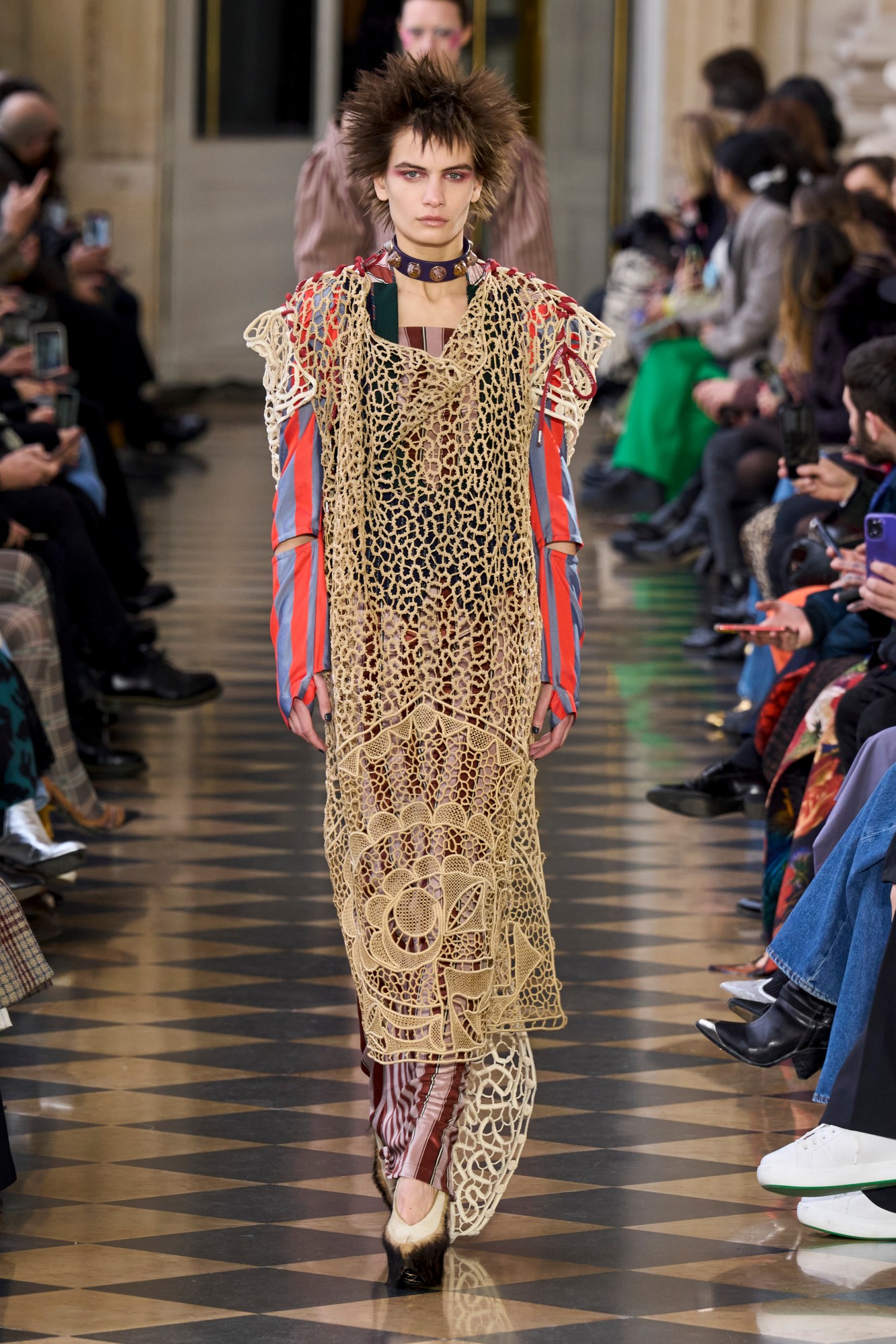

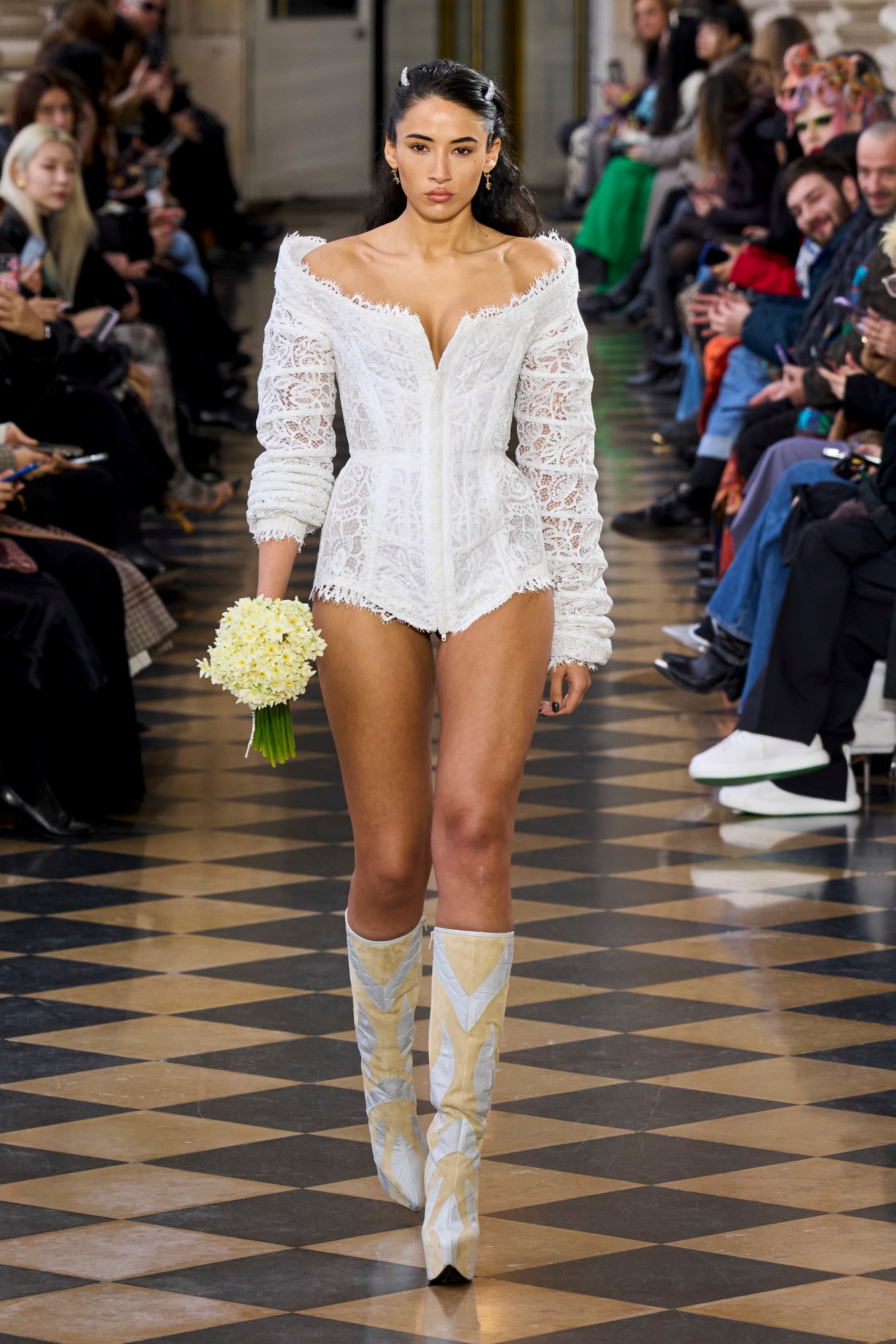
Andreas Kronthaler for Vivienne Westwood
Review to follow.
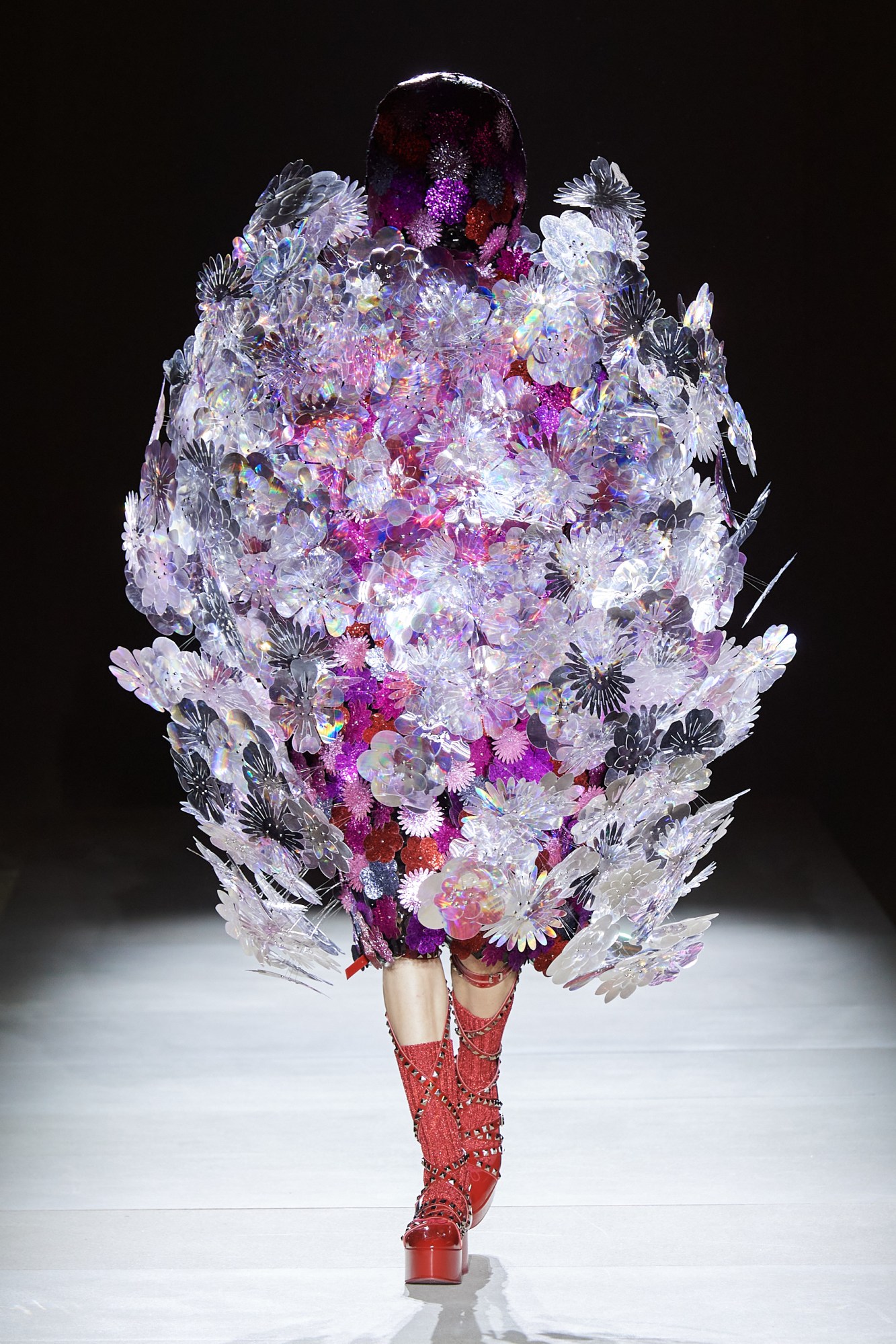
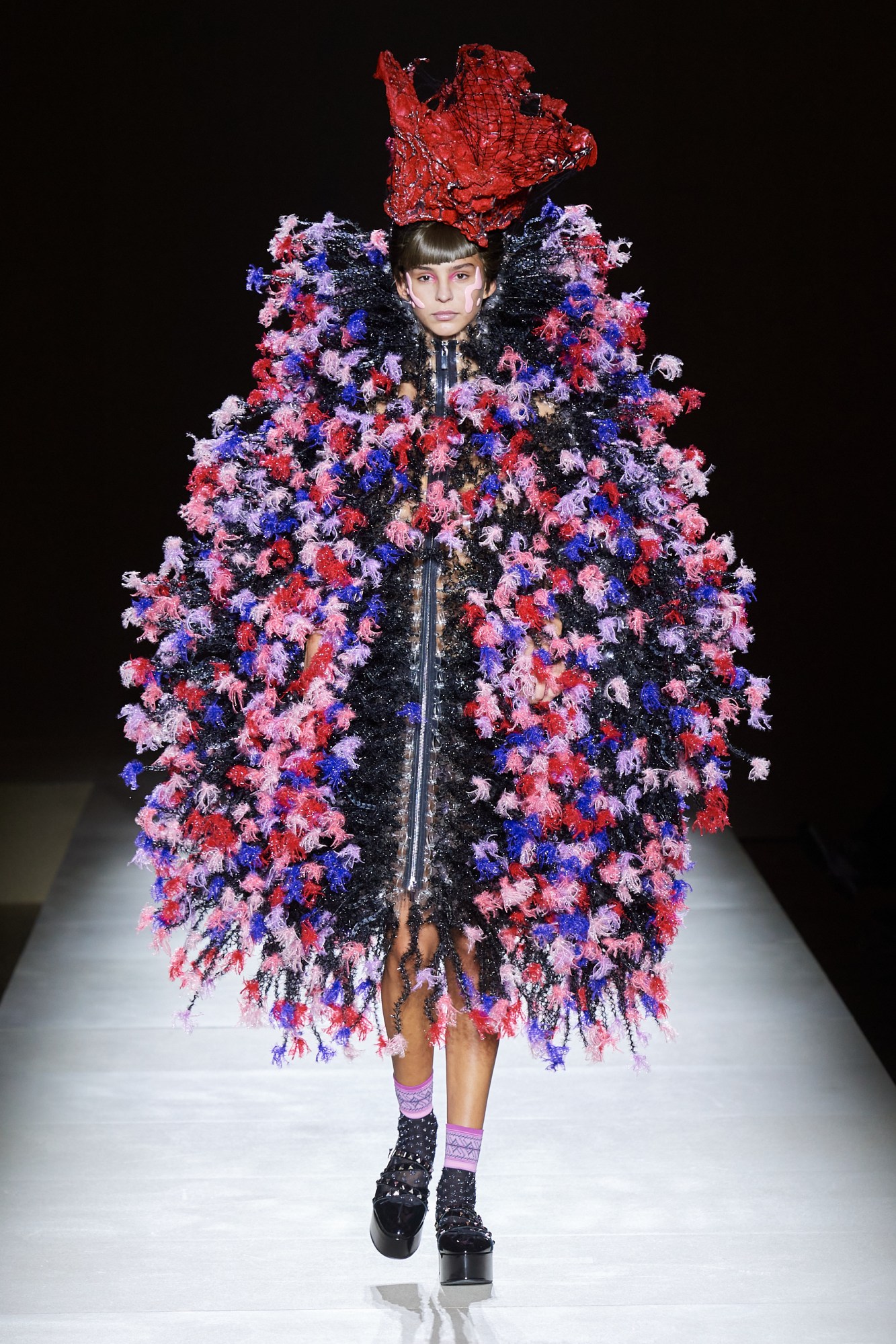

Noir Kei Ninomiya
Noir Kei Ninomiya’s AW23 show was a transportative affair, taking us to a realm far away from our own. To do so, he transformed our own dimension (in this case, Le Marais) into a celestial plane and littered it with otherworldly beings (models) glittering and shimmering like UFOs. The show, a celebration of the brand’s new collaboration with iconic French company, Repetto, was defined by architectural marvel hairpieces – created by Takuro Kuwata – which adorned looks that were equal parts alien and fantastical. Swirled and tasselled wool skirts draped themselves around the models’ bodies, secured in place with enough bows and buckles and belts to make you believe they’re preparing to fly off into space at the end of the runway. The show played with our dimension’s definitions of style, and what we’ve come to expect from the Comme des Garçons adjacent brand in this dimension, before elevating and subverting them to transport us into the next one. Alongside the expected black were flashes of pinks, purples and silvers, almost celestially bright. Footwear was held in place (sensibly) with loads of straps but was also platformed, patented and studded, with thigh-high dayglo bejewelled stockings. Loose, dangling chains hung off chest pieces layered over expertly pleated wool coats. The detailing behind the fantastical — both the opening and final looks were complementary glowing balls, all beams of light and the kind of shiny flowers you’d imagine astronauts discovering on a far-flung planet — revealed more of the same extra-terrestrial themes. Masks shielded the models from the presumably punishing other-dimensional atmosphere, while clever make-up, created by Amazing Jiro, drew rivulets of shimmering space sweat across their faces. Well, it’s a workout, presumably, this Noir jaunt from our ordinary, drab universe to another, prettier one. RL


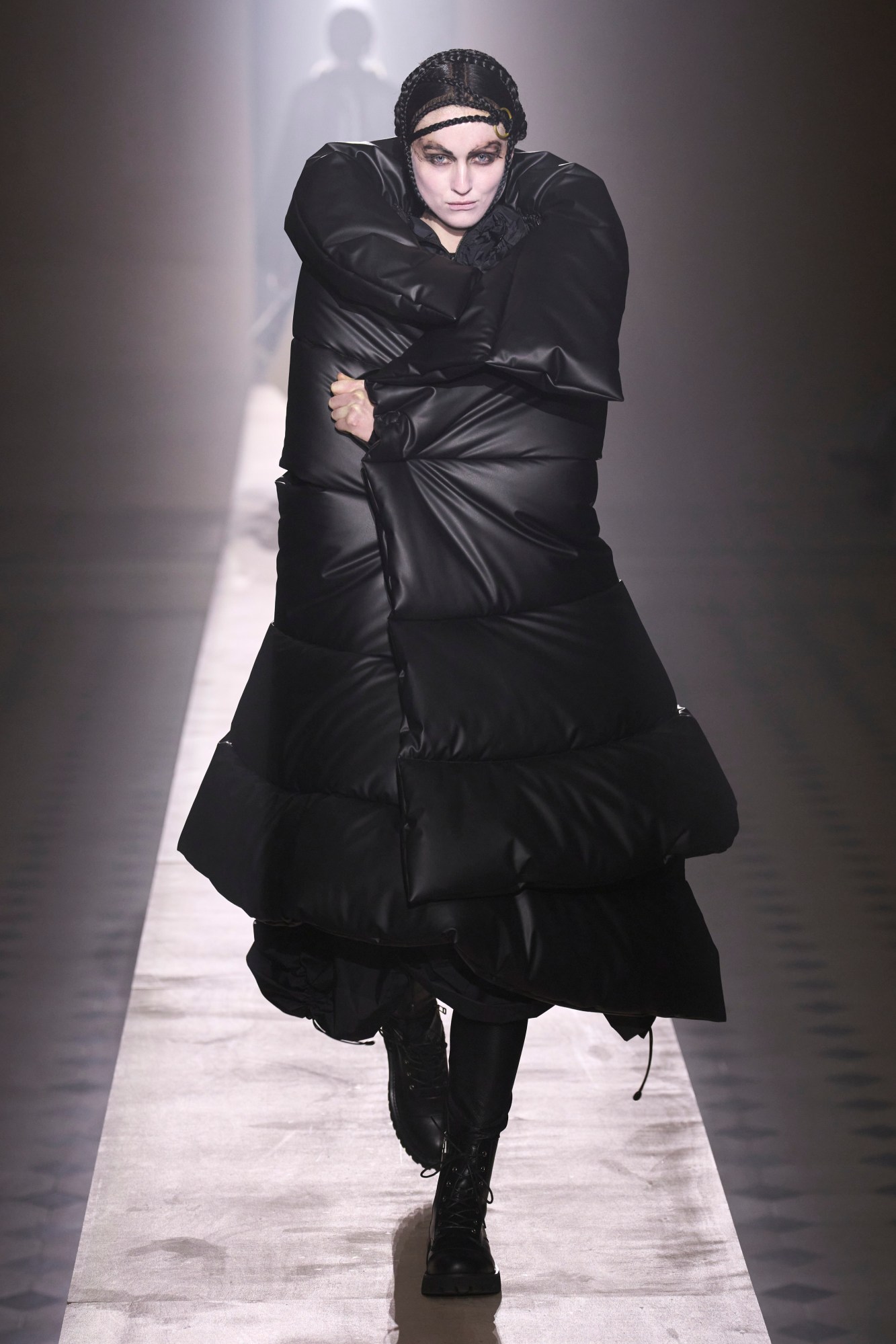
Junya Watanabe
This season, many designers have sought to divert our attention away from the bleakness that colours our current times, offering collections that either offer a sense of levity or clean, palate-cleanser calm. Junya Watanabe is not, however, one of them. For his AW23 collection, the Japanese designer offered a collection seemingly fit for whichever dystopian hellscape we’re currently careening toward, a sense conjured in particular through the neo-noir, Dune-y mesh and neoprene masks sported by a number of models towards the show’s start, the product of a collaboration with Berlin-based accessories brand Innerraum. That carried over into the collection itself, too, which (in what felt like a follow-on from Junya’s recent menswear offering) comprised a swathe of intelligently crafted, boxy all-black clothes. An opening suit of looks in tech-y nylons – coats and long-sleeved dresses with harness details and dangling drawstrings – conveyed a dark weather-hardy sportiness, and studded leather jackets were constructed with the rigour and sculpturality of samurai armour. A wipe-clean leather dress with a flounced, scarlet-lined hem brought a moody, fetish-y timbre into the mix, while a closing series of duvet coats swaddled their wearers, conjuring notions of comfort and protection in the face of adversity – which, things being the way they are, we could all do with! MS
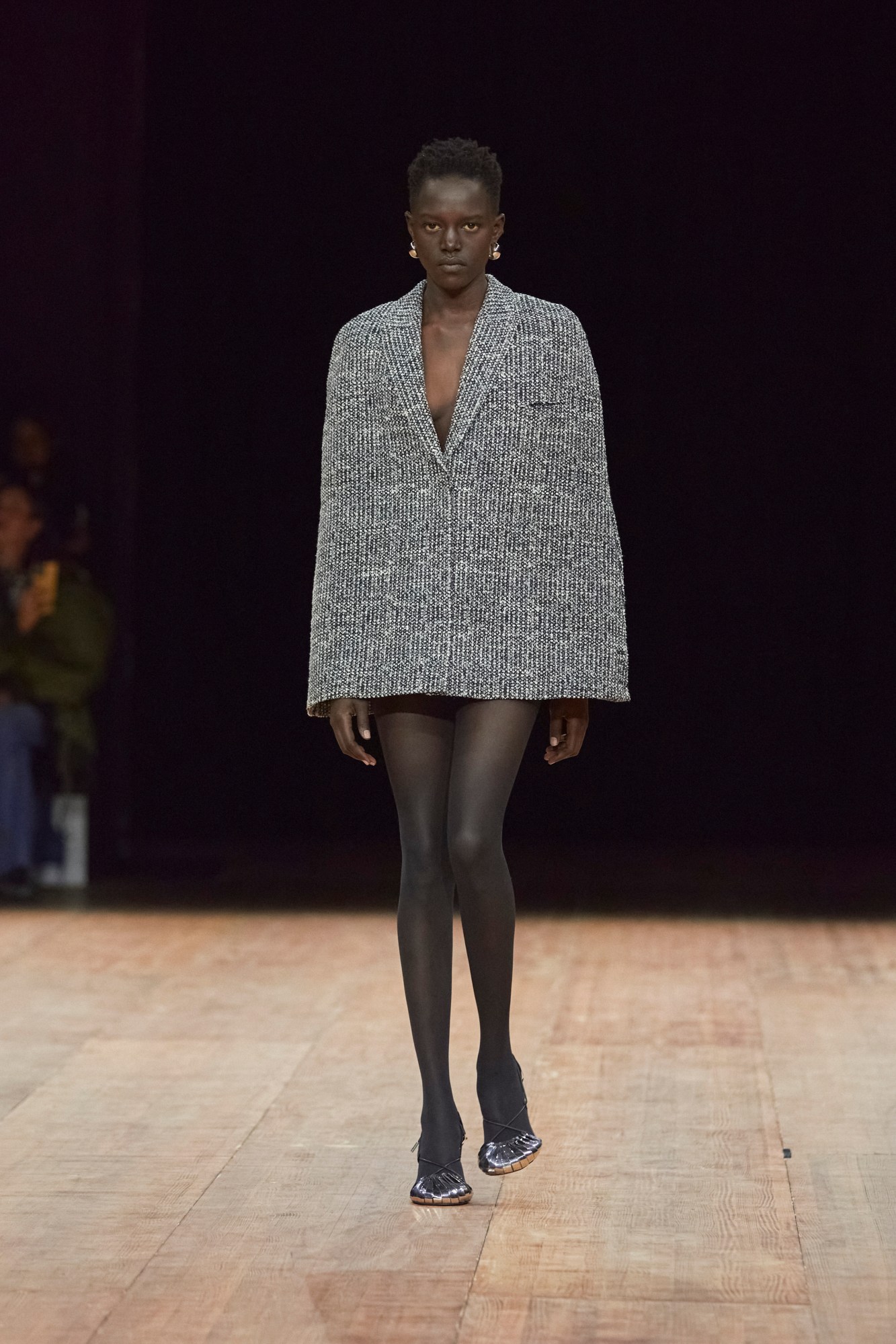


Coperni
Coperni was always going to have to pull out all the stops to top the viral moment from their SS23, when Bella Hadid broke the internet while being spray painted into a dress live on the runway. Luckily, the Parisian brand managed to outdo itself again, with another presentation that leaned into the relationship between technology and fashion. This time models shared the runway with eerie robot dogs, who moved frenetically around the Théâtre National de la Danse and, in another already internet-breaking moment, even removed one of their coats before handing it back to them. Another helpfully carried a handbag in their metal claw. Spooky! For their AW23 collection, designers Sébastien Meyer and Arnaud Vaillant may have wanted to explore the symbiotic relationship between humans and technology, but their inspiration was a little more archaic. The presentation was inspired by the Aesop fable “The Wolf and The Lamb”, from 17th Century poet Jean de La Fontaine. The human models here represented the lambs, while Coperni’s controversial yellow robots represented the wolves. The juxtaposition between modernity and the natural world extended down into the clothes; a blending of wool, fur and laser-cut leather with flowing shirts and even some Little Red Riding Hood-inspired hoods. Of course, as with Bella and her aerosol, it was the Black Mirror-esque robot dog wolves that stole the show though. Unlike the previous season, in which the presentation and the clothes worked together seamlessly, here the stunt was more obviously separate, more noticeably created for virality. In a way, it’s unfortunate that these creepy yellow machines, created by Boston Dynamics, became the takeaway from last night’s show, rather than the clothes themselves – especially when, on rediverting your attention, the high calibre of the fashion on show was evident. Still, you know what they say about robots coming for our jobs, eh! RL
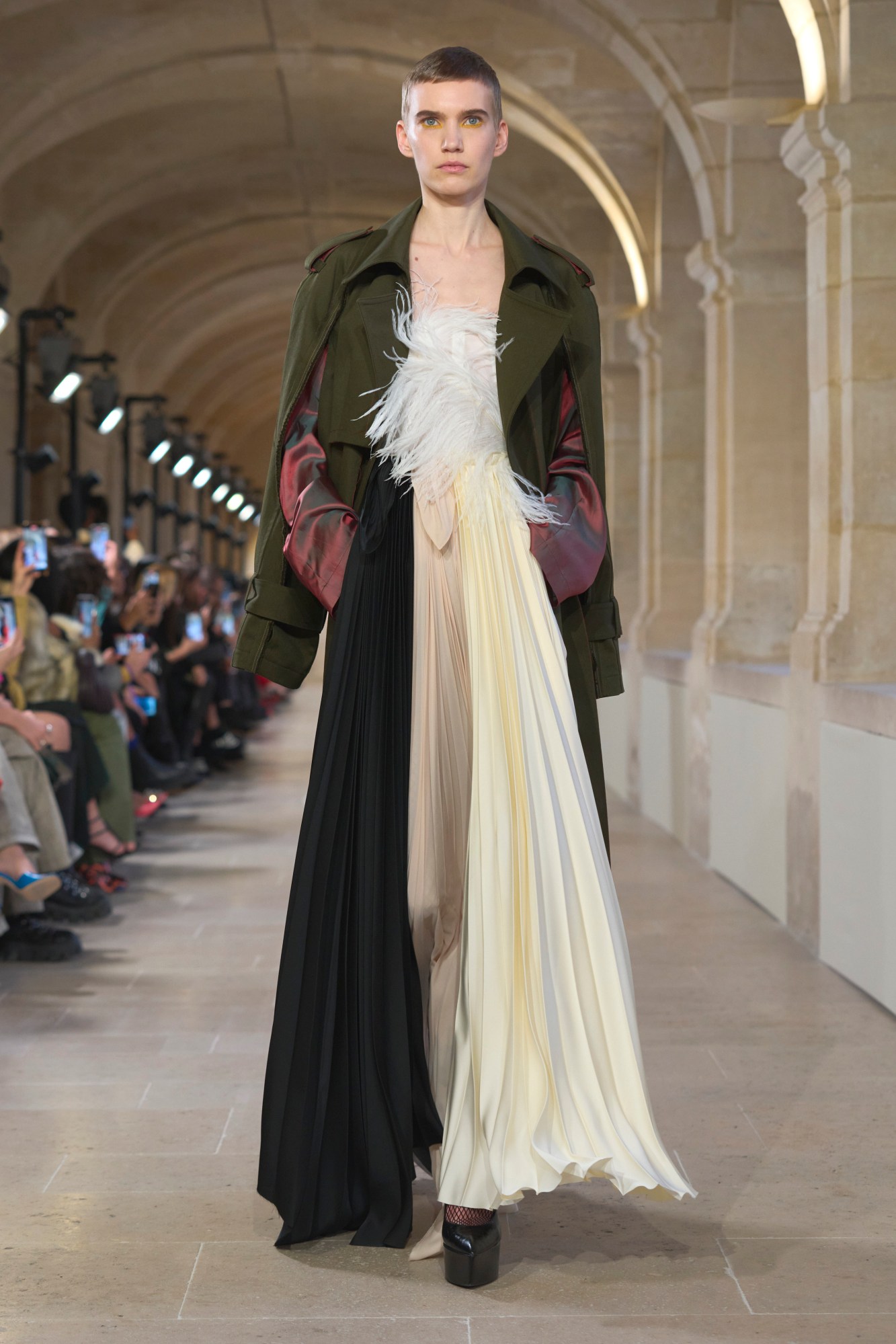
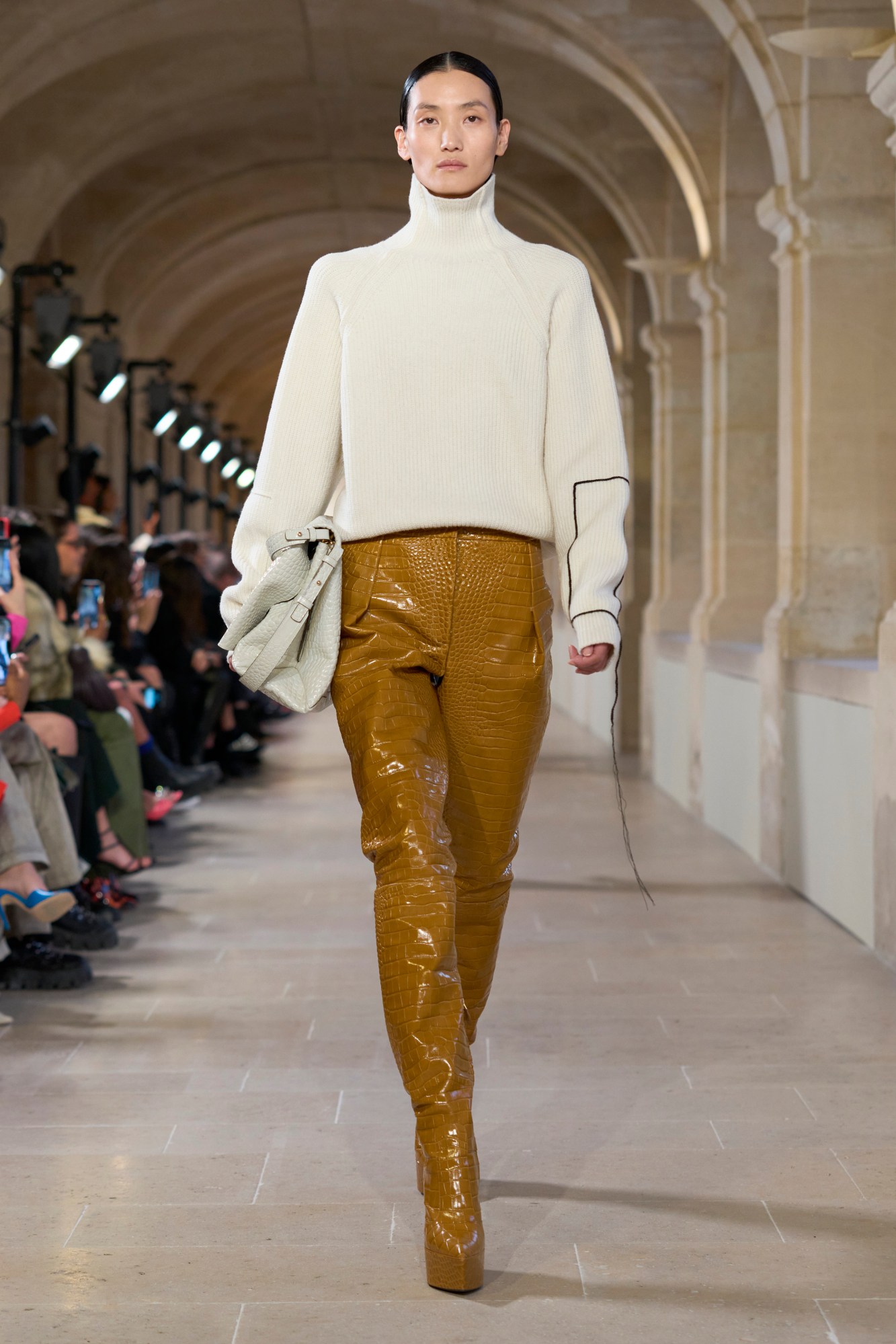

Victoria Beckham
What is the point of dressing up if not using clothes to express ourselves, to create a character that we want to embody as we walk through the world, a different character to the one we might play next month or next week or even tomorrow? The endless creativity that comes from playing dress up is at the heart of Victoria Beckham’s AW23 collection. For her second show in Paris, the designer used clothes to investigate the construction of character through style, through the joy of playing dress up. Suitably, it was inspired by one of the greatest, and certainly most glamorous and eccentric characters of recent cinematic history: Grey Gardens’ Little Edie (but in the 2009 movie version, played by Drew Barrymore, not the 1975 documentary, duh). Little Edie knew how to dress — however the hell she wanted — and the women of Victoria Beckham are, we presume, cut from the same cloth. There were certainly Edie-inspired silk flowing gowns here, but using the character as a starting point VB was able to explore the power of deconstruction and customisation and mixing and matching just because. Oversized shouldered blazers with inverted lapels met with raw, hacked denim, deconstructed skirts and resin-coated trousers with exaggerated pleats, eccentric swirling hems, trippy, trompe l’oeil plumes. The collection was as much a celebration of textile than of character: informed by the work of Brazilian artist Solange Pessoa, who spent decades gathering human hair for her formidable installations, hair extensions slither out from hems and necklines, an eccentric take on knitwear. After all, what’s playing dress up if not essentially an excuse to go big and go weird or go home? RL
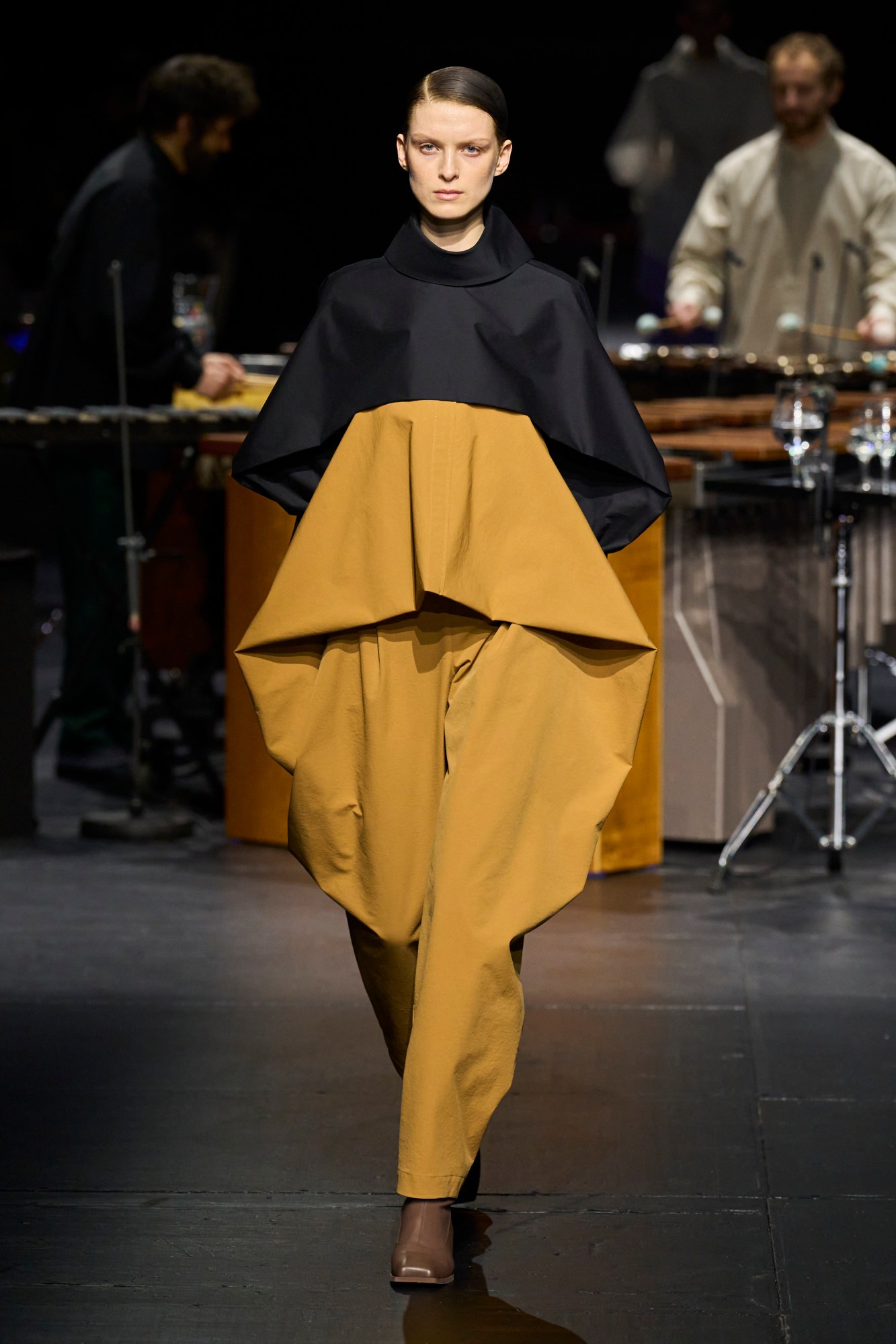
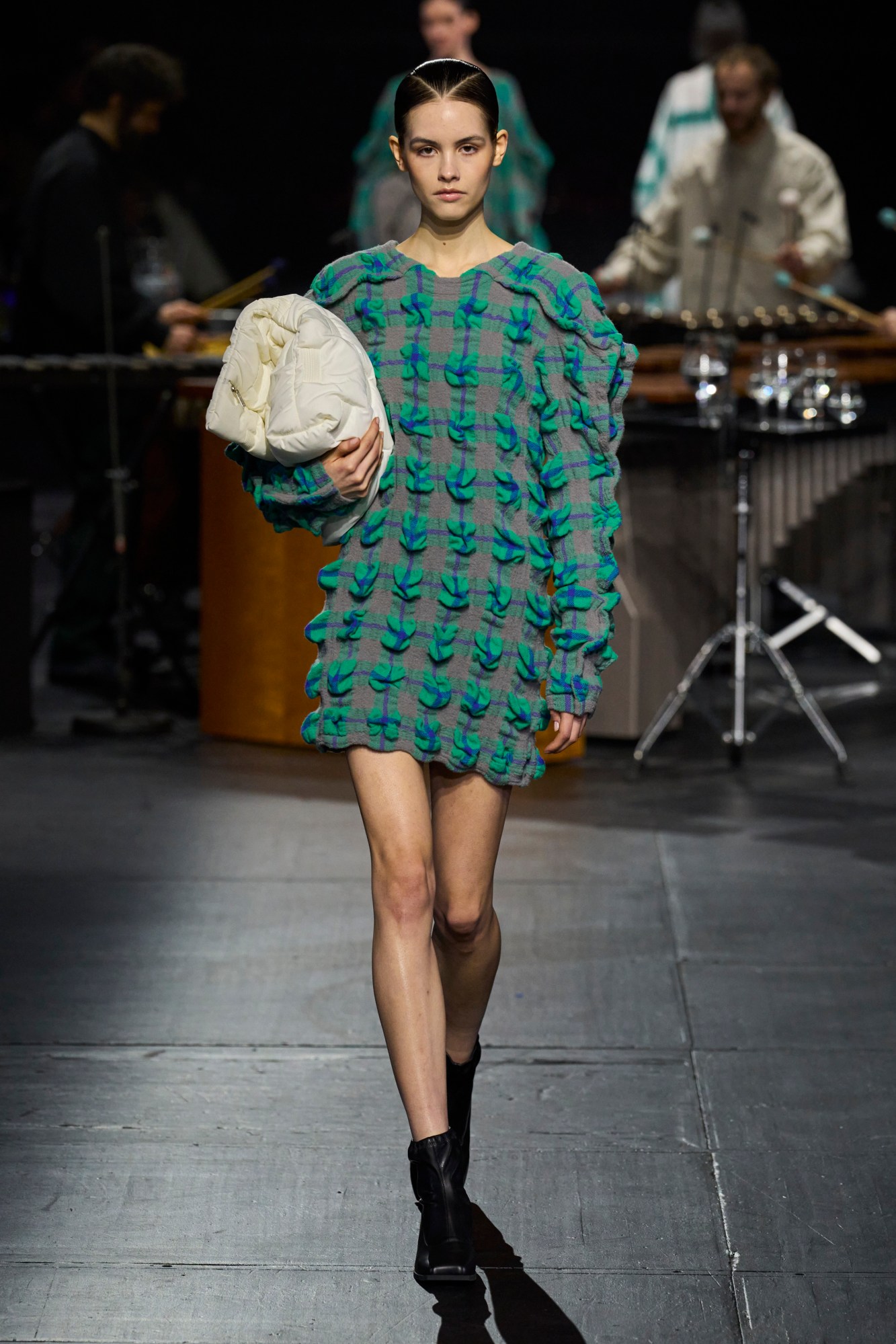
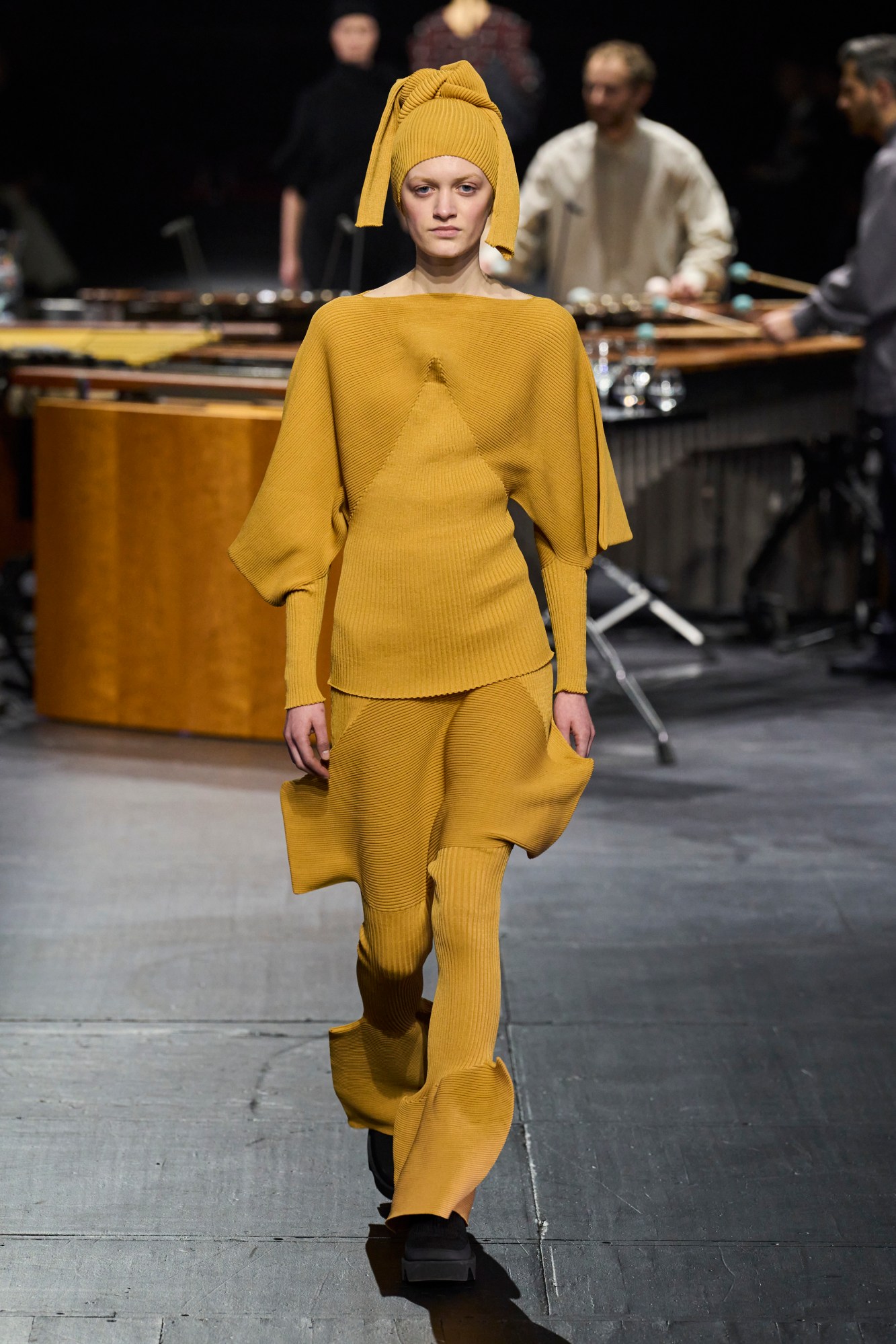
Issey Miyake
Fashion week might operate at a punishingly breakneck speed most of the time, but Issey Miyake’s Satoshi Kondo wanted us all to slow down. The brand’s AW23 collection was very much a meditation on rhythm and form, how time and slowness can help us to progress, be more intentional, creative, and see ourselves more clearly. To do so, Satoshi presented clothes which ruminated on the Japanese concept of ma (the unfilled space) between the clothes we wear and the person that wears them. All the looks here were inspired by both that concept but also by the concept of the square as a shape that, in many creative practices, is the beginning of the process (a canvas, a musical score, a piece of fabric). Knitted squares were found in ‘Square Scheme’ knit structured dresses, playing with the shape woven into each gown. Elsewhere yarn deliberately shrunken in high-temperature water became ‘Rhythm Check’, inspired by the way a chequered pattern alternates in a rhythm. Squares and checks appeared on reversible, angular coats with counterpointed, alternating lengths in the front and back, twisting up the body. Bags were square but cleverly draped, moving in tandem with the models as they glided around an empty opera house, the show accompanied by a syncopated live marimba performance by percussion ensemble Trio SR9. Issey Miyake went back to Square One (no pun intended) for AW23, and that source of inspiration brought them to new dimensions. RL



Nina Ricci
All eyes were on Harris Reed yesterday as the British designer prepared to unveil his hotly anticipated first Nina Ricci collection, and the result didn’t disappoint. A celebration of stripes, sequins, colour and volume, subtle it was not – a smorgasbord for the eyes it was. Precious Lee opened the energetic collection, walking the Tim Burton-esque striped catwalk in a polka-dot covered, present-wrapped body suit and bow dress. The models felt the fabrics they were wearing and felt themselves in the process, wriggling and shimmying towards the gathered crowds and managing to do it all in impressively vertiginous (and of course, striped) platform heels. Models ran their fingers around My Fair Lady style wide-brimmed hats and sashayed away in head-to-toe ensembles emblazoned with baby lambs. Jessica Stam was wearing gold hoops that reached her shoulders. Subtlety was out, optical illusions were in; so think bell-bottomed suits in primary colours, blooming fur and feathered coats in candy hues and hoop skirts reminiscent of (striped) circus tents. Elements of the designer’s eponymous line were here but reworked, amped up, made bigger and, crucially, brighter. If the fantastical, candyland elements of the collection leaned towards the freedom and nostalgia of childhood, that was intentional. In an Instagram post Harris dedicated the collection to all of the world’s dreamers and bullied kids, writing: “A nine-year-old queer kids dream came true today.” RL
Loewe
Review here.
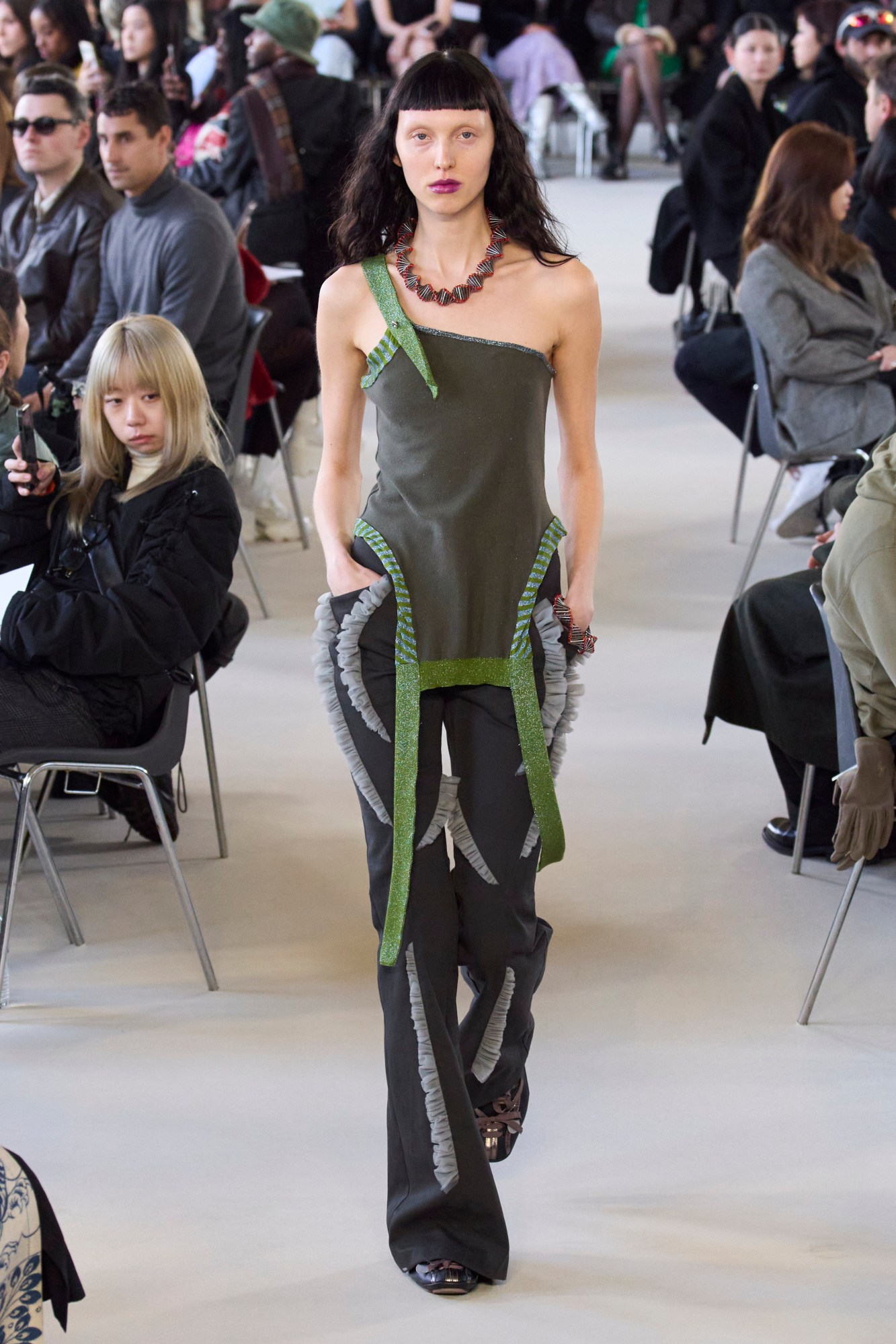

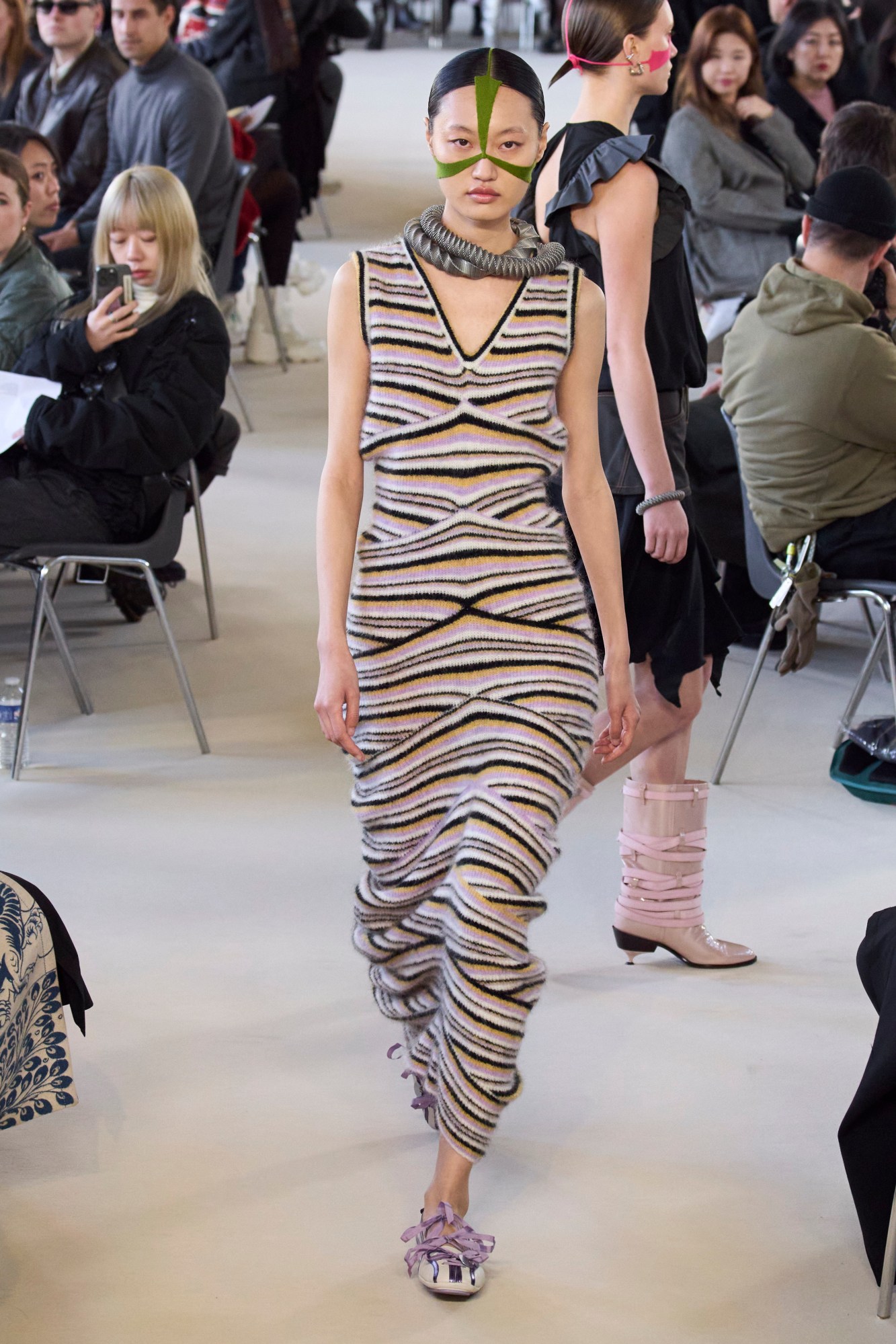
Kiko Kostadinov
This collection from Laura and Deanna Fanning – the Australian twins who helm the womenswear side of things at Kiko Kostadinov – was only the second they’ve presented in Paris. So accomplished was it, though, that it felt like they were mainstays here on fashion’s greatest stage. The fact that it was shown in the sports hall of a chi-chi high school was fitting, given the undercurrents of sportiness and teen spirit that ran through it – just look at this season’s F1-inspired shoe silhouette and the subtle pink bubble hems seen throughout. Despite what the setting may imply, though, this was easily their most focussed, grown-up work to date.
The girls’ honed draping skills were on full display in pieces like a gossamer white crepe halter top with a ruche-edged circular cut-out, and a grey satin-y dress with a swooning front fold that framed an ab-baring gap, descending into an elegant tumble of fabric for the skirt. Cropped aviator jackets in dry drill cloth had overblown lapels that folded down into shoulder flaps, with a similar silhouette appearing in pinstripe wool, and elegant knitted dresses came with fully slashed sleeves, resulting in a wrapped, cape-like construction at the shoulder. For all the sober elegance that the collection demonstrated, zings of the off-kilter spirit that Laura and Deanna have made a name for naturally came through; lengths of shimmering green lurex tape trailed from single-shouldered jersey vest tops, while fins of tulle sprouted from the seams of the brand’s signature flared trousers, delineating the intricate patternmaking involved in their design. Elsewhere, the frou-frou fabric puffed about the layered hems of sporty shift dresses, with a similar effect echoed at the bottoms of workwear-y trousers and in layered thick-gauge knit socks – motifs that proved that, even though their work has become exponentially more sophisticated over the past few seasons, Laura and Deanna haven’t lost the exquisite weird-girl touch that stands them apart from the crowd. MS
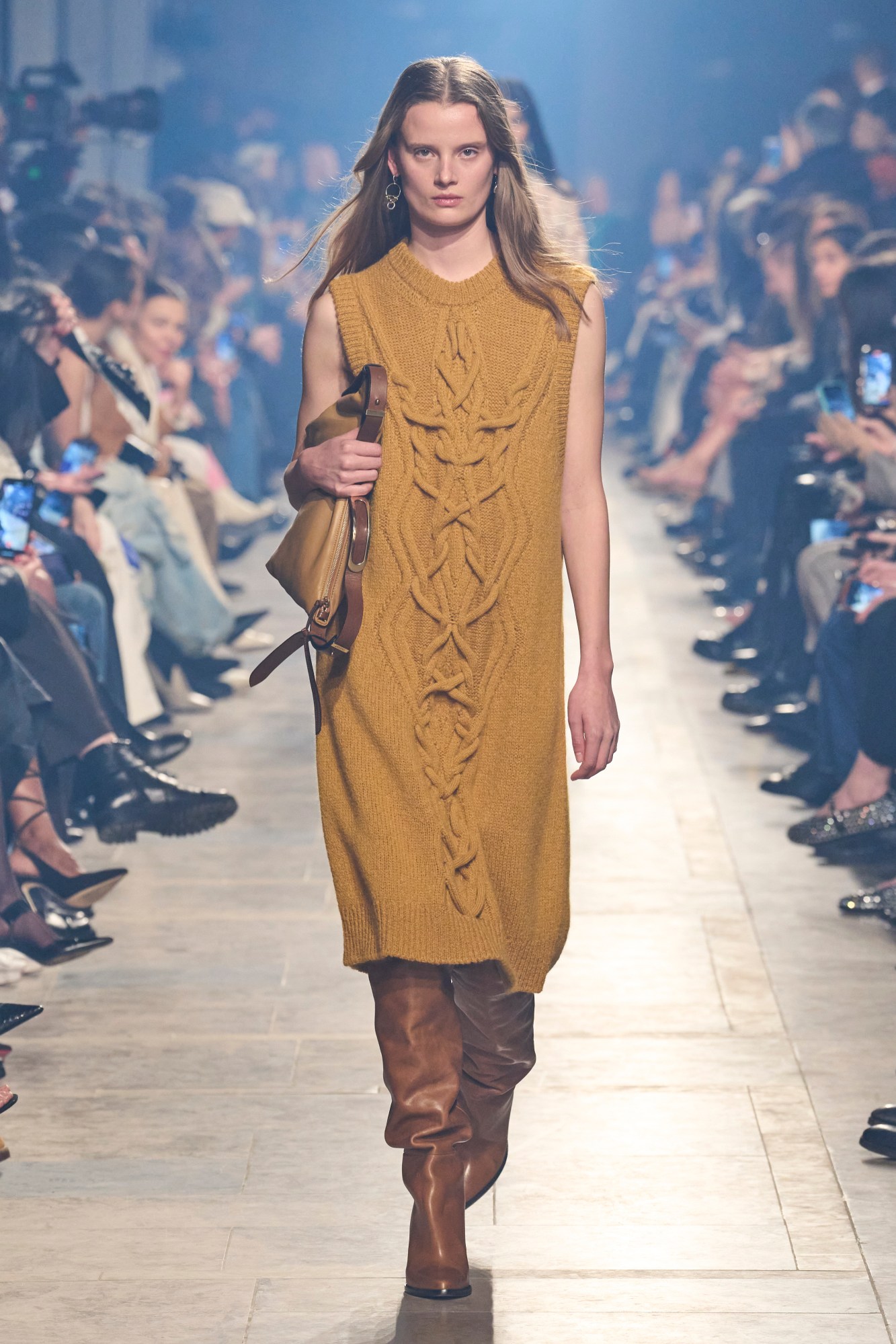
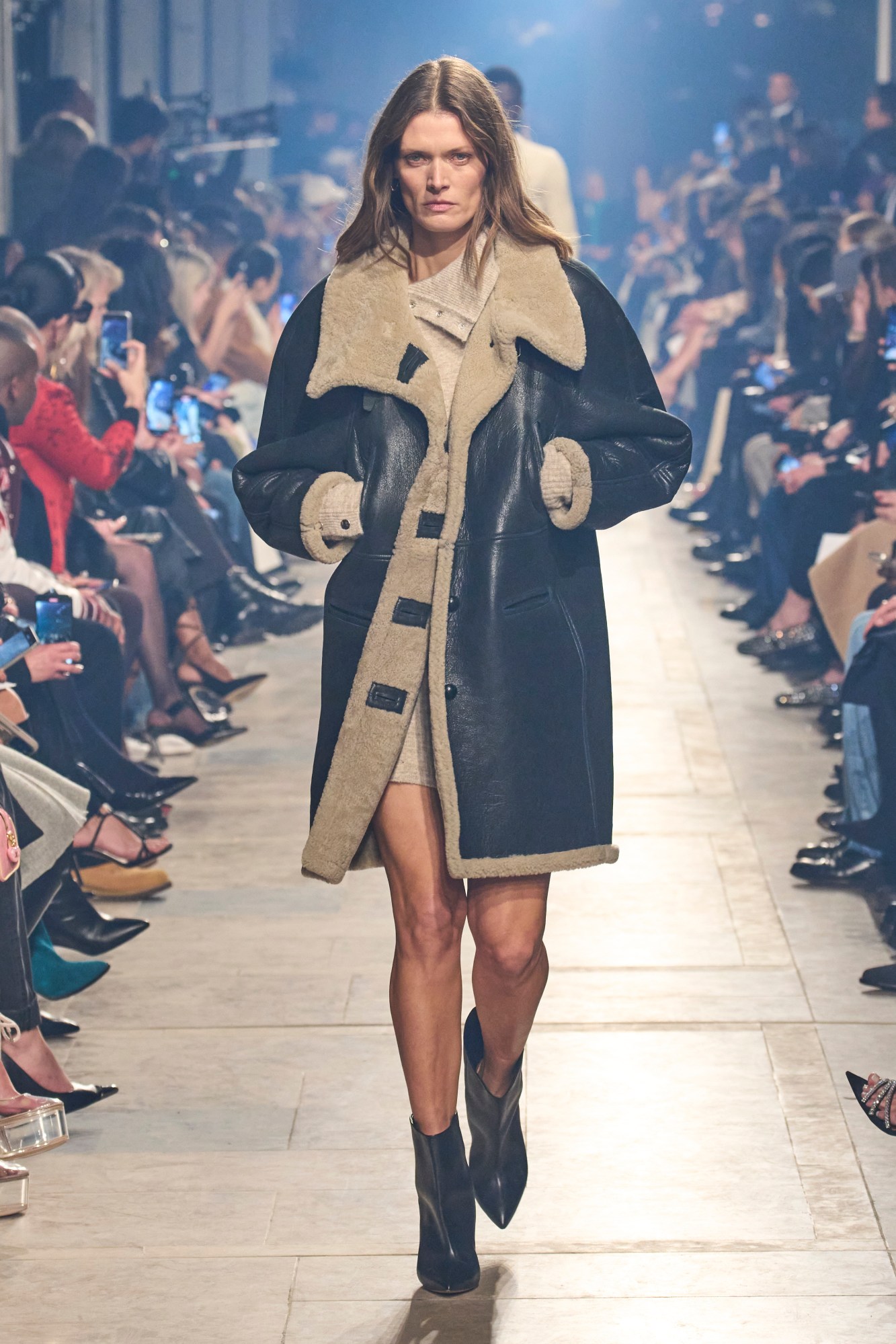
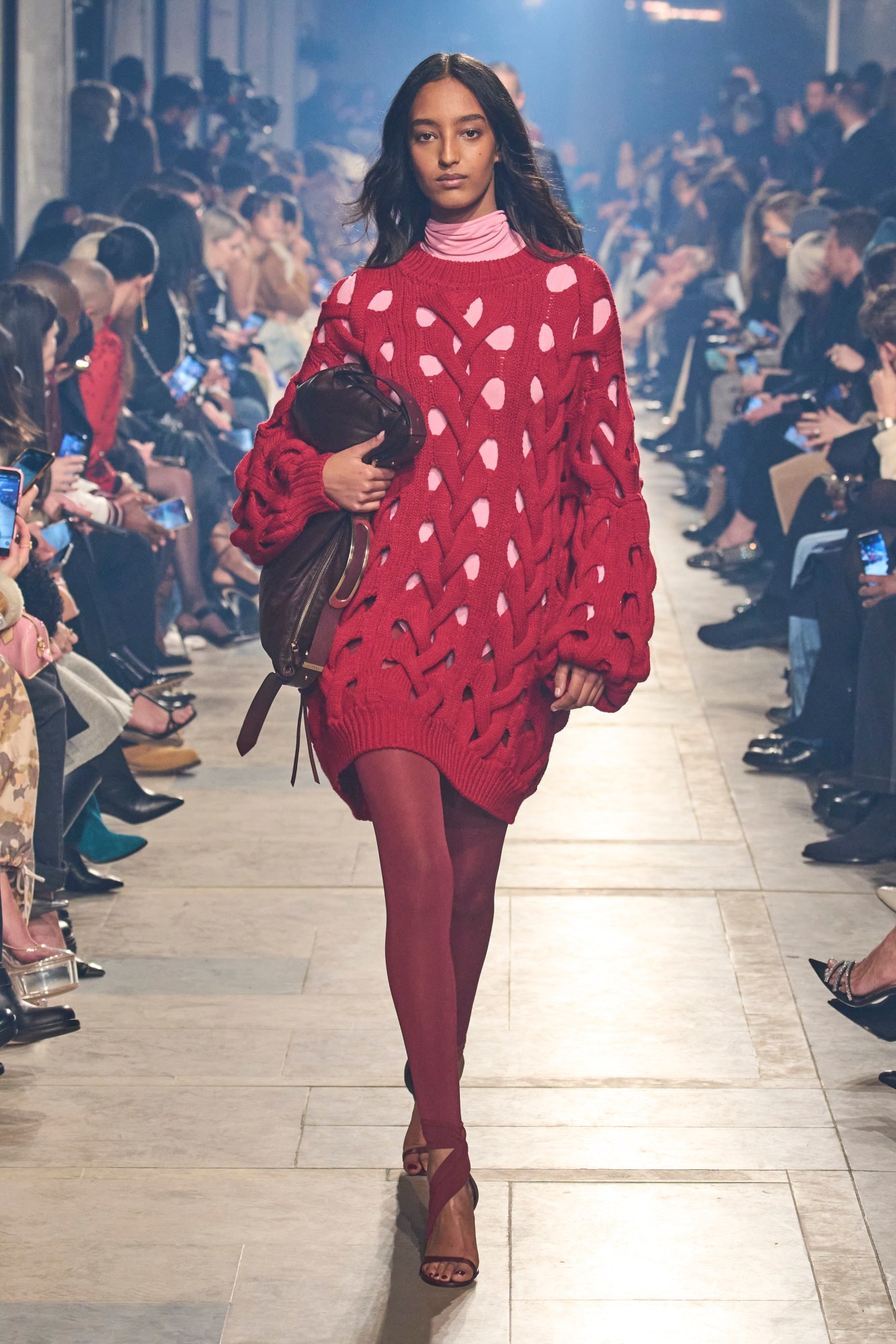
Isabel Marant
By the time the crowds descended on Isabel Marant‘s AW23 collection, most of Paris was blue-fingered, sniffly nosed and shivering. It’s really, really cold. Luckily this collection celebrates the desire to cuddle in shearling, swaddling coats and comfy knitwear, so it all felt very well-timed and on the nose. But of course, this is Isabel Marant, so if we’re going to be celebrating coats and cosyness, it’s going to be in a sexy way, duh! Unconventionality, disorder and irreverence were at the heart of the French designer’s showcase; and leather, obviously. Leather ruled this collection, as did metallic zips, daring necklines and split dresses.
Elsewhere, graphic cutouts shaped new takes on Isabel Marant-chic and played with ideas of transparency, subtly revealing parts of the body not covered up by dyed denim and warm wool. Isabel’s colour palette played with disorder and irreverence too; descending over the course of the show from natural and minimal hues to yellow and magentas before diving into a sparkling and glittering black. The textures were over the top (embroidery everywhere, volume everywhere, velvet lurex everywhere) because the show was over the top. A cast that casually delivered us everyone from Jessica Stam, Imaan Hammam and Sasha Pivovarova to Natasha Poly, Liu Wen and Julia Stegner paraded by as the venue turned into an impromptu Thursday night rager. DJ Gabber Eleganza and Lulu Van Trapp played live in the centre, spurring a little chaos amongst the cool, crowd-surfing off at the end. It might be cold but, Isabel Marant says at least, that’s no excuse not to have a party. RL
Schiaparelli
Schiaparelli
Until now, Schiaparelli has only staged couture shows — the last of which ended in the furore surrounding some looks which featured lifelike animal heads. That’s all in the past now (even if it was only last month). For his first ready-to-wear outing, creative director Daniel Roseberry set the scene for an intimate salon show complete with standing ashtrays (although smoking was, sadly, forbidden) and the smooth, melodic tones of Sade playing in the Louis XV salons above the Place Vendome. Given the rooms were just next door to Schiaparelli’s ateliers, the message was clear: sure, this is technically ready-to-wear, but — like that good old-fashioned pyramid with its trickle-down effect — it is all informed by the zenith of one-of-a-kind haute couture. Abbey Lee Kershaw opened the show in a sculpted navy coat, rounded sleeves and mismatched buttons, and a white turban that hinted at both Elsa Schiaparelli herself, and Sade. Out came portrait-collared shearling coats with house-motif intarsias, faux monkey fur-trimmed sweaters, a puffer with gilt embroidery, long jersey dresses with actual keyhole cutouts, and, of course, plenty of sombre black and brown tailoring and outerwear with gilt buttons. It was all worn with either simple Sade-esque headbands or higher-the-hair-closer-to-god bouffants that served as a reminder of Daniel’s Texan roots. This was a strong outing; and although the ghost of couture, and indeed Elsa, was very much in the room, Daniel managed to make it clear that his bombastic vision of red-carpet couture can also lend it itself to everyday life. Well, sort of. You know what we mean. OA
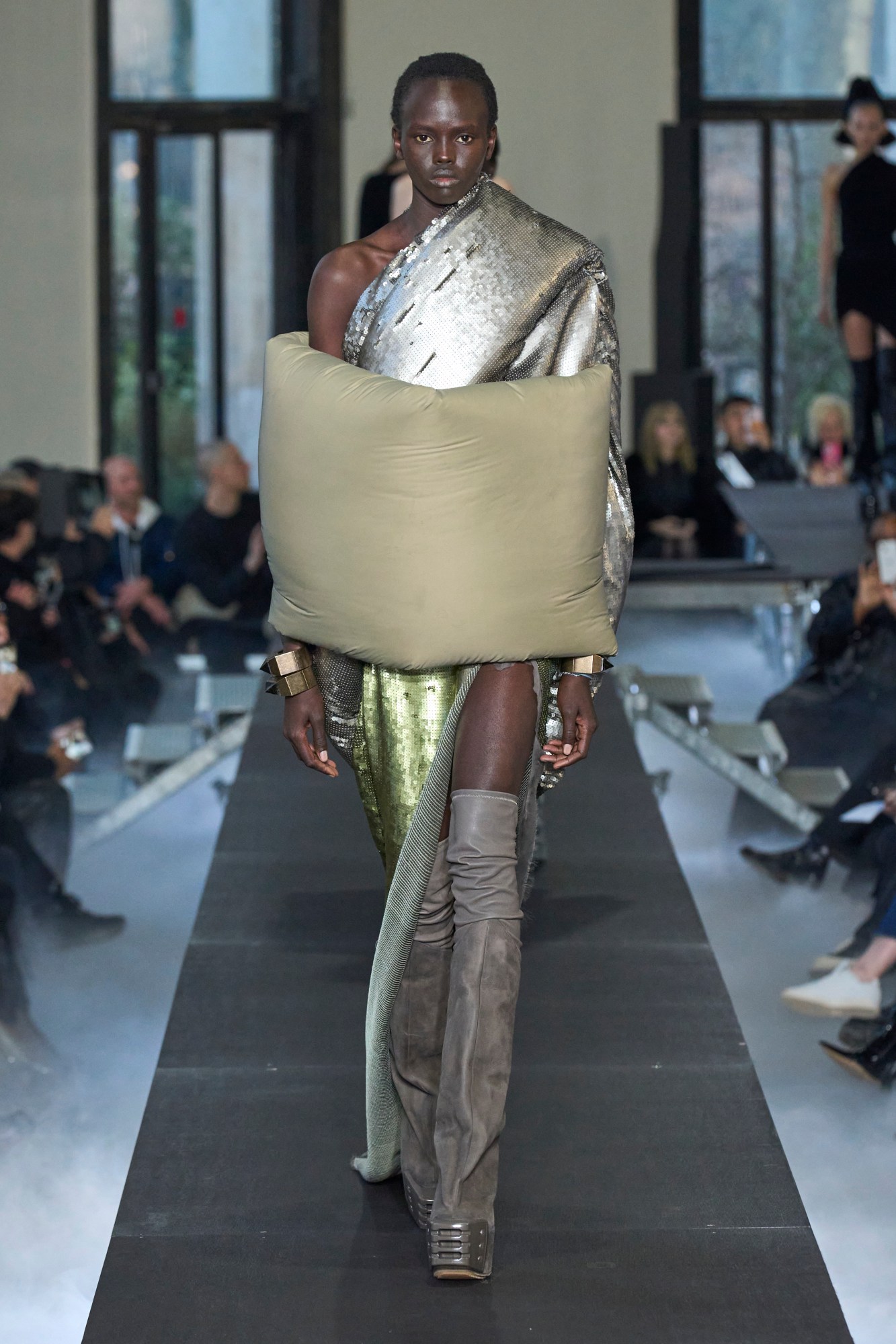

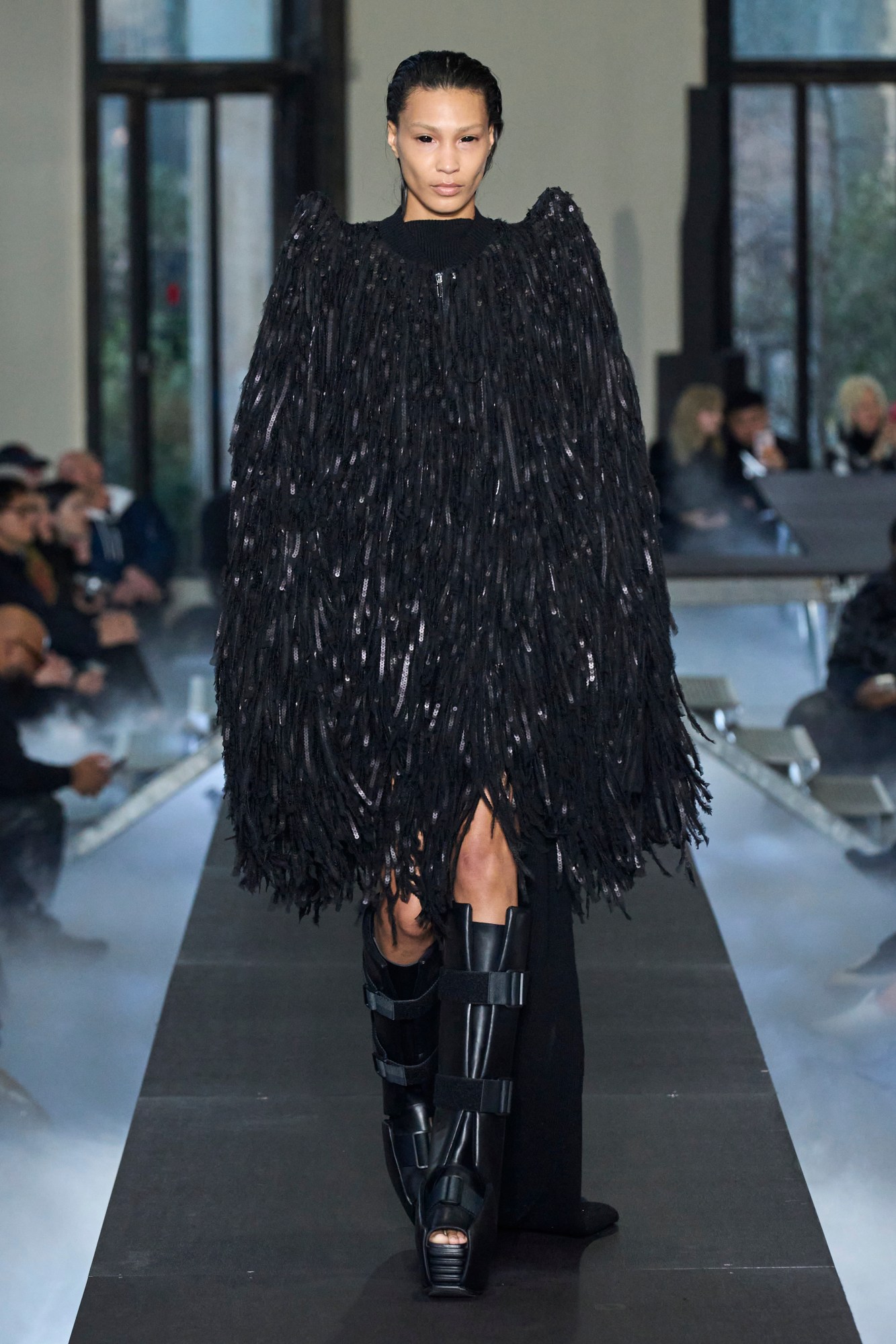
Rick Owens
Rather than take solace in escapism, the recent collections that Rick Owens has presented in Paris have directly broached some of the pressing existential themes that mar those of us unlucky enough to call planet earth home right now. Rather than figurative interpretations of themes of war, climate disaster and financial collapse, though, the clothes he has presented have been more like necessary antidotes – pieces that convey armoured empowerment, tender fragility, or stoic permanence.
This season, the sentiment that emanated from his latest collection. One of dignity and quiet poise, it was informed, as Rick wrote in his native all-caps, by an understanding that “TIMES LIKE THESE MIGHT CALL FOR A RESPECTFUL FORMALITY AND SOBRIETY WITH MOMENTS OF DELICACY AS REMINDERS OF WHAT IS AT RISK AND AT STAKE.” What that translated to on a practical level was a collection that felt pared back, debrided of the lurid flecks of campy sparkle and theatricality that have figured in previous recent seasons. Tube dresses and knit tunics with hip-bone cutouts and thigh-high slashes offered a base to a number of looks, figuring in sober black cashmere and matte sequin-embroidered wool. The latter fabric was also used for Little Red Riding Hood-style capes that had a distinctly chainmail feel to them, which was only compounded by the armour-like, grill-fronted thigh-high KISS boots they were styled with. Rick’s sculptural nous was flexed in a series of gigantic chubby garlands – or donuts, as he calls them – in heavy nylon, Japanese denim, dusty sequins and silk charmeuse which snaked about and swaddled the models’ bodies, simultaneously conveying a sense of cosy protection and druidic poise. These final pieces seemed to get to the heart of the collection, presenting a resolute elegance imbued with an ancient – timeless, even – sensibility. In times when it feels like the world as we know it could end at any given moment, that sense of permanence couldn’t be more needed. MS
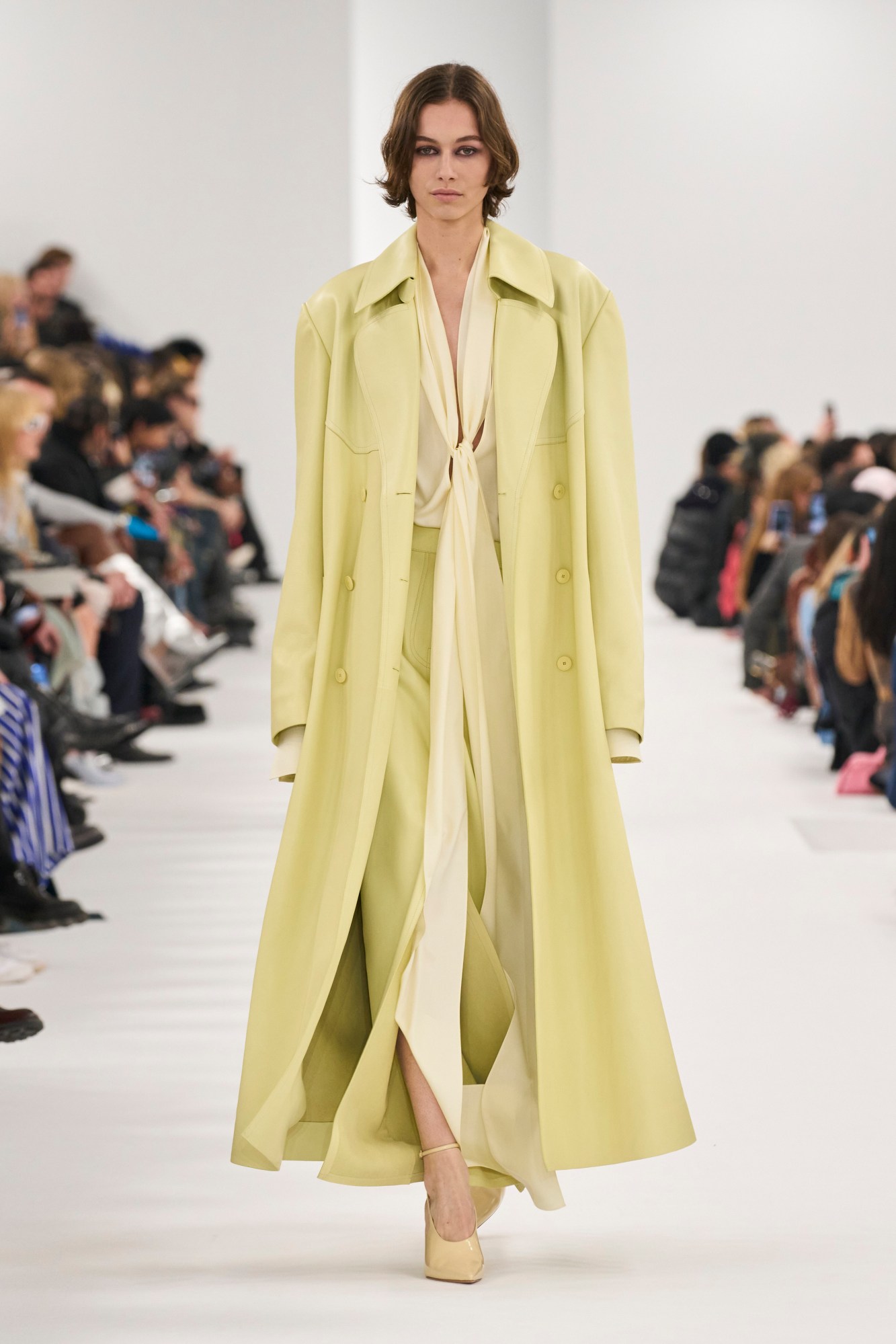
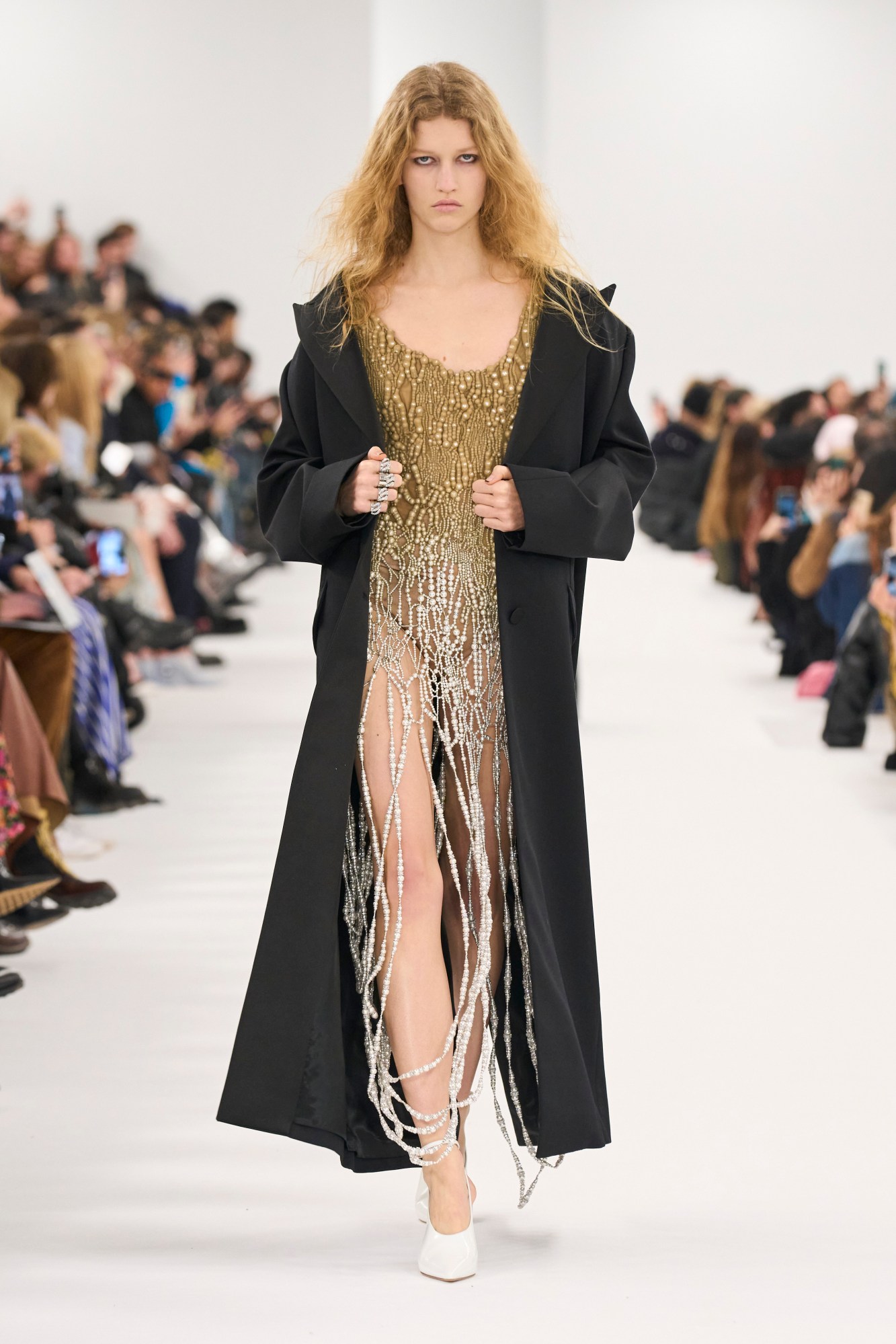
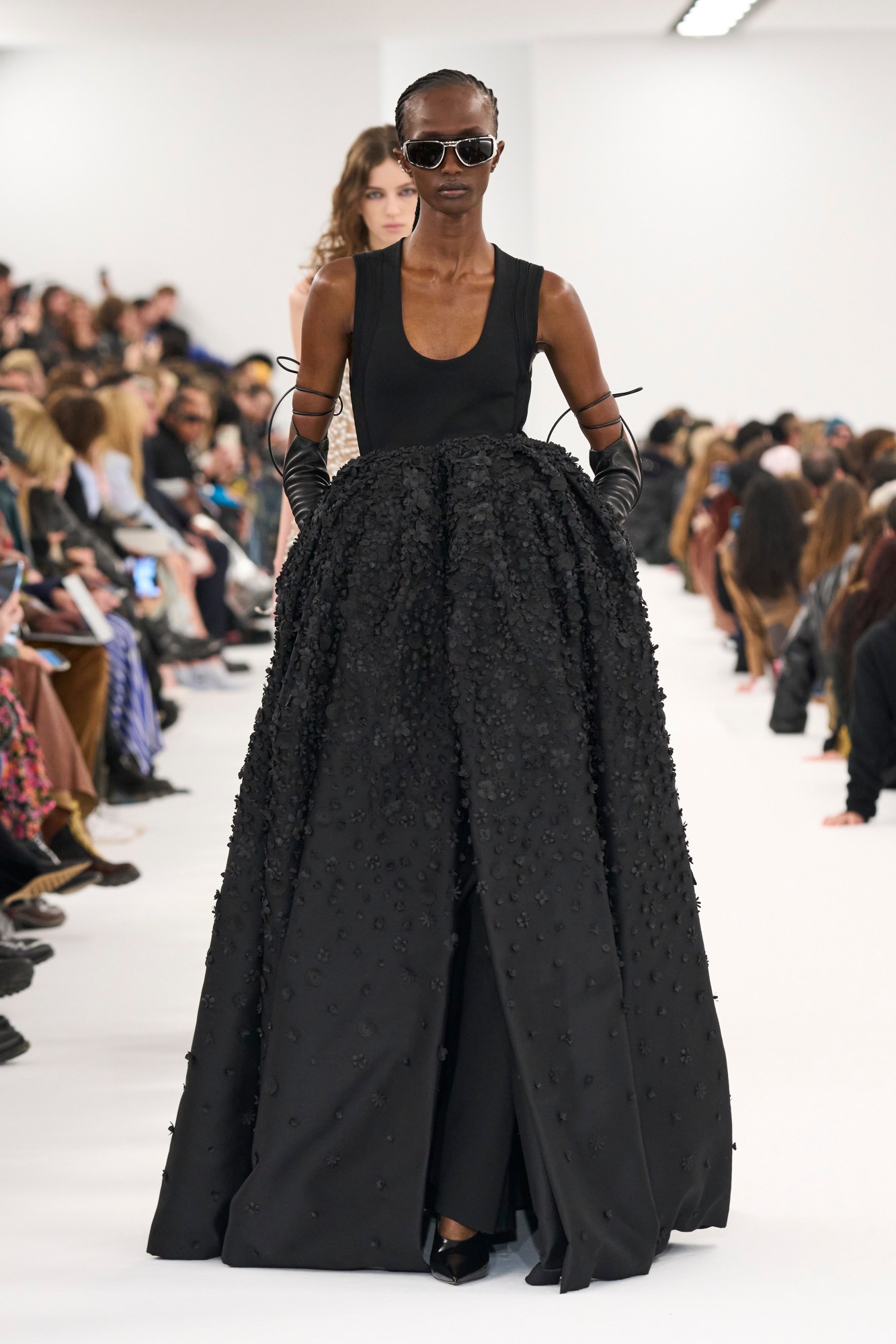
Givenchy
Matthew M. Williams says he’s inspired by the women around him. Judging by the looks in his AW23 collection, the women around him are all deeply chic. Under his stewardship, Givenchy has become a house of women (and men) that represent a kind of elegance at once both new and classic. After last season’s presentation was marred by a rainstorm, this time at the Matthew was taking no chances. The models were at least, dressed for that eventuality, even in the gleaming white box setting of École Militaire. Tailored black full–length wool overcoats with clever pleating at the waist were enough to guard against the Parisian cold. For better climates there were short blazers with exaggerated shoulders and long-line leather jackets. Yet for all the sleek sensibilities on show here, there were flashes of playfulness too. Amidst the classic colour palette of blacks and whites were frilly gowns in emerald green, sheer baby pink chiffon and pastel lemon, and more luxe dresses created with gold tassels. Again the Givenchy archives were used as reference points for these evening gowns — dropped waists, off-kilter hems — but revamped for a new era. A game of two halves! And a collection, crucially, that remained all the more beautiful for being delightfully unrained on. RL
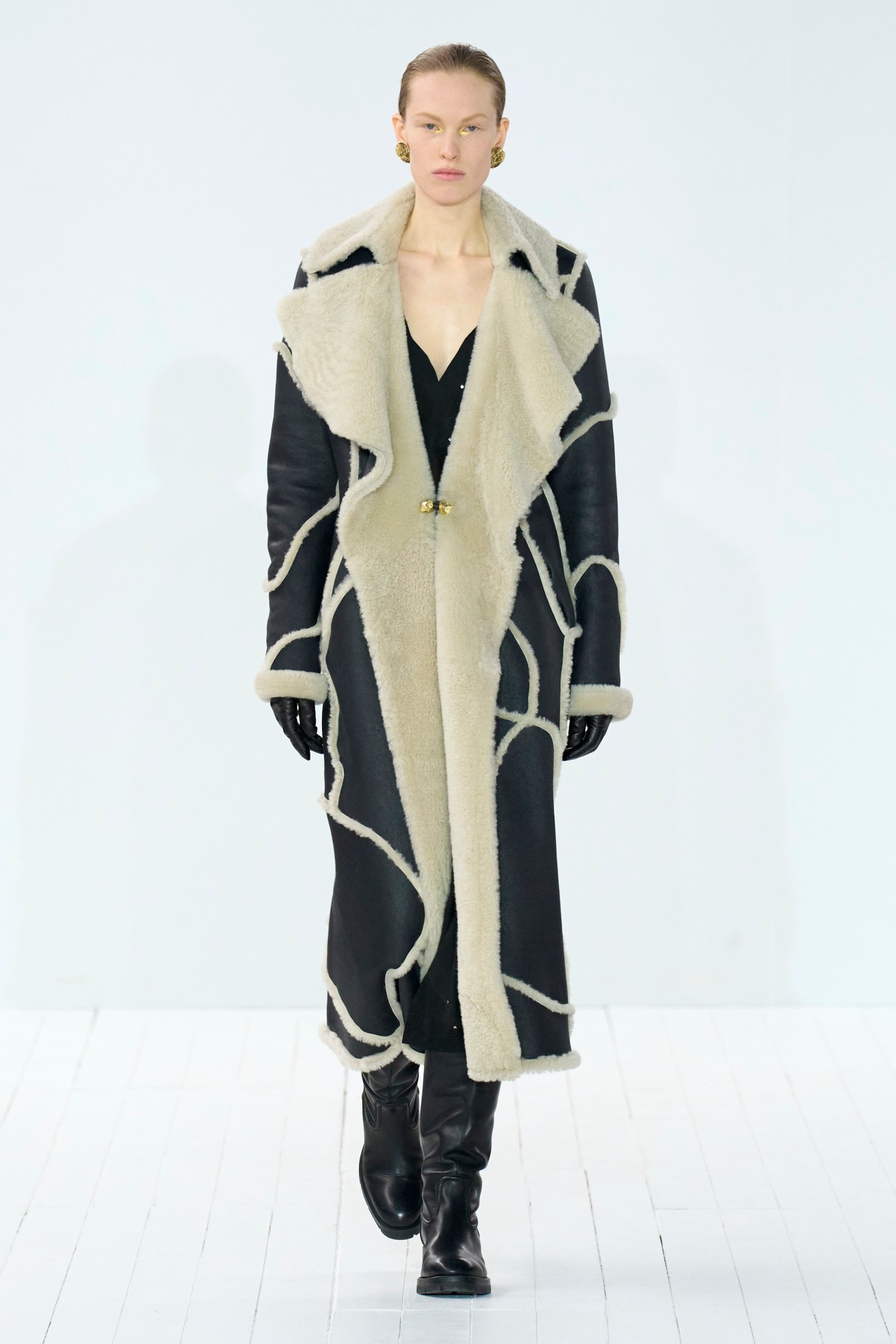
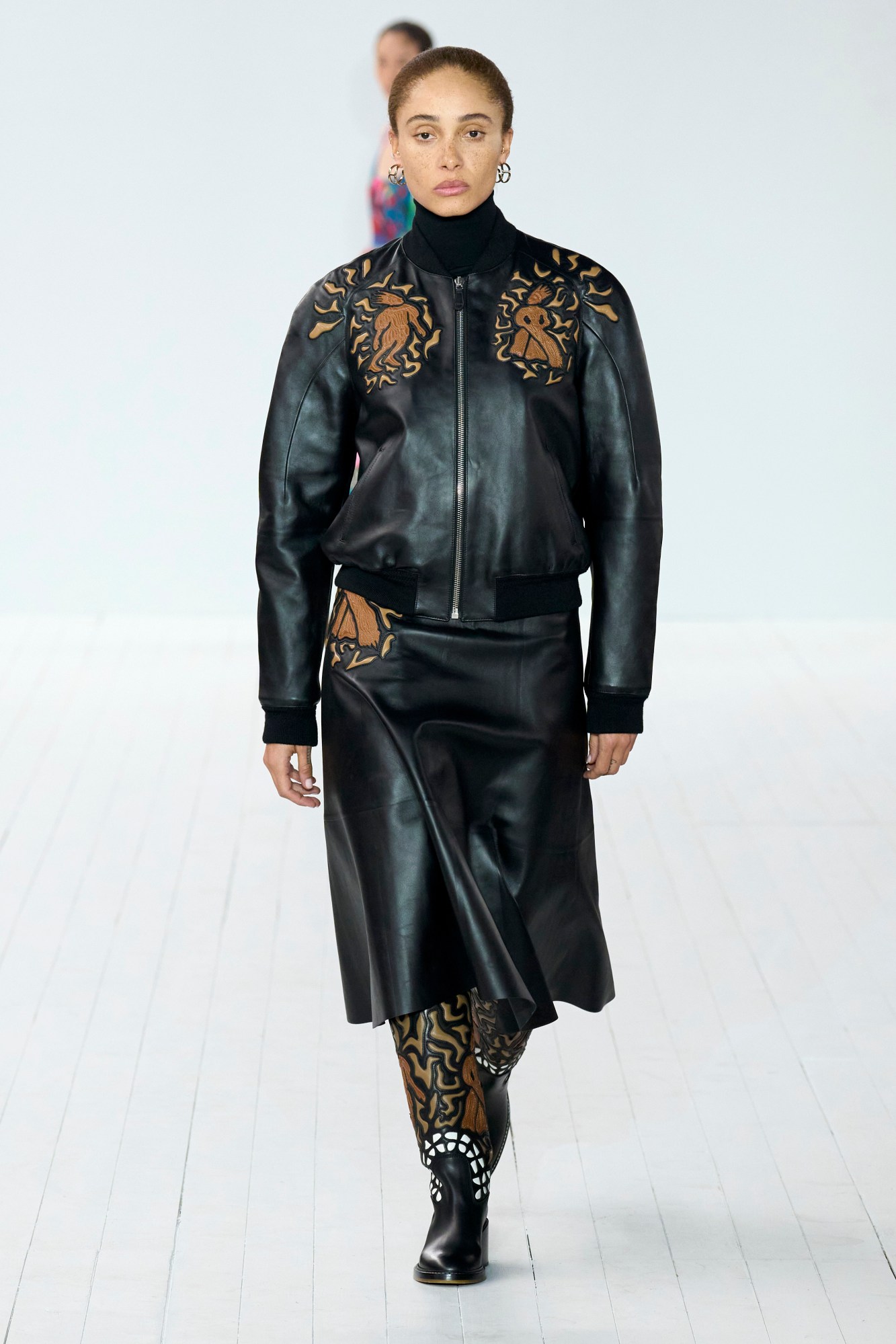
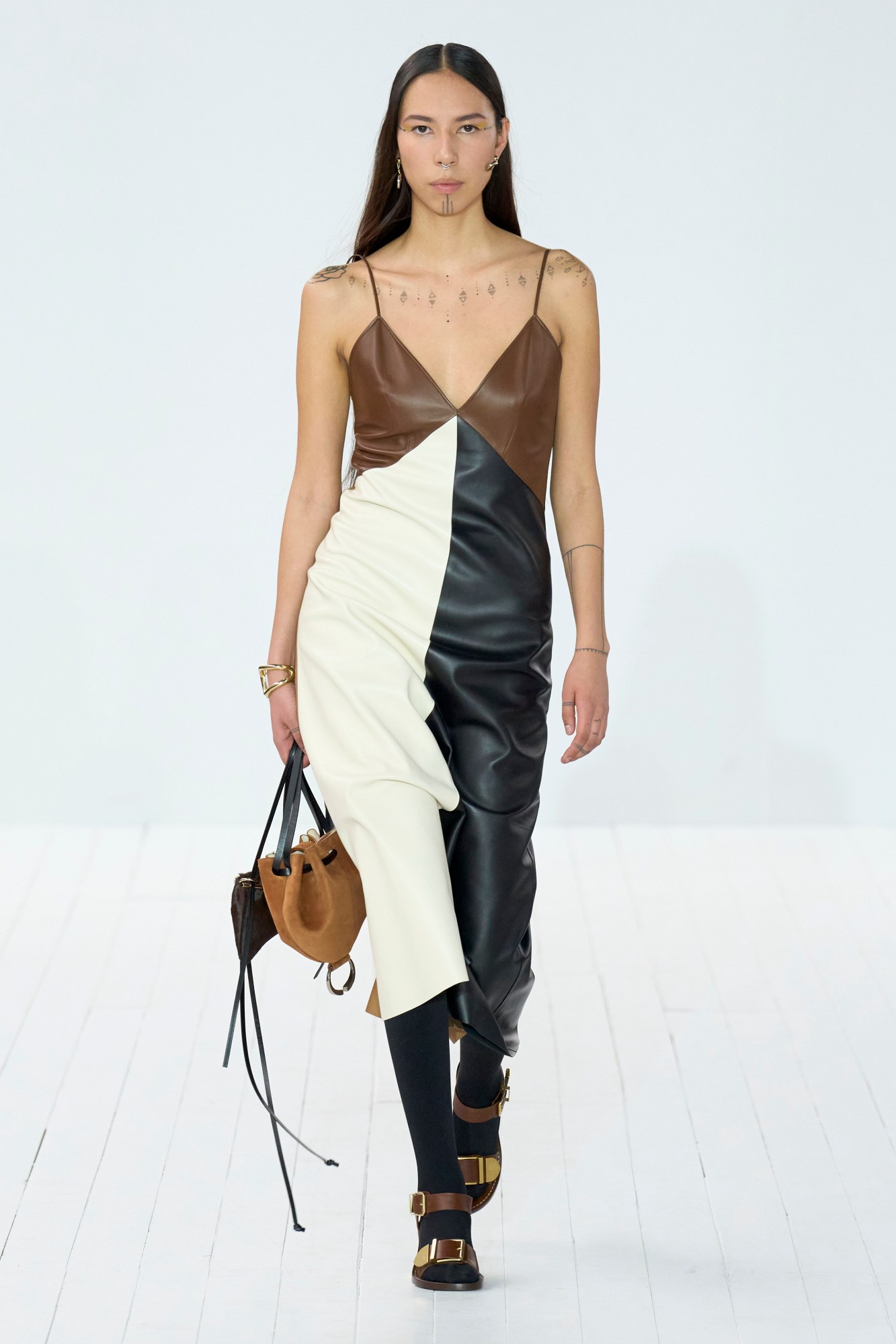
Chloé
“I will show your lordship what a woman can do”, said Artemisia Gentileschi, one of the most celebrated – albeit oft overlooked – painters of the 17th Century. It might be hundreds of years later, but just as Artemisia remained overlooked in her lifetime, women’s stories, narratives, work and talent are often unheard and unseen today. Chloé’s AW23 was a clarion call for the need for women’s stories to be brought out of the shadows, for a specific reason, to help find a solution to our impending climate doom. This collection was the third chapter in creative director Gabriela Hearst’s exploration of the disproportionate impact of climate change on women. It’s an impressive take on the traditional seasonal format; using the fashion show as a vehicle not just for showcasing clothes but also for disseminating important messages to a wider audience.
But it goes without saying that there’s as much care and attention and dedication in the clothes here as in the political message behind them. A suitably Renaissance-like approach to a collection that takes inspiration from Gentileschi’s most important works (all of which feature women in positions of power), the era can be seen across Gabriela’s collection, from the black, white and brown contrasting colour scheme to traditional embroidery techniques, puffer cape coats, cameo inspired jewellery, high necklines and bishop sleeves (in an ultra-modern twist, cut from nappa leather). Renaissance architecture is reflected in dégradé patterns of black satin diamonds sewn into wool. The Biblical figure of Esther, from another of the Baroque artist’s works, is transposed onto bags and dresses in the form of multicoloured, decidedly historical tapestries. Chloé dives into its own historical archive for inspiration too; the Marcie, which turns 13 this year, is deconstructed to become not an iconic bag but leather biker jacket, matching trousers and loafers. For a show that’s so tightly wound up in the climate catastrophe, there are of course plenty of sustainable innovations here to balance out the more traditional historical influence; lower-impact wool gauze is used for dresses, seams created with recycled nylon, Gayia eyewear made with 100% recycled acetate. The result is a beautiful reminder of the works of women in the past, a celebration of their achievements in the present, and a cautiously optimistic look towards the future, to what women might do to alleviate an ecological crisis that disproportionately affects us. RL


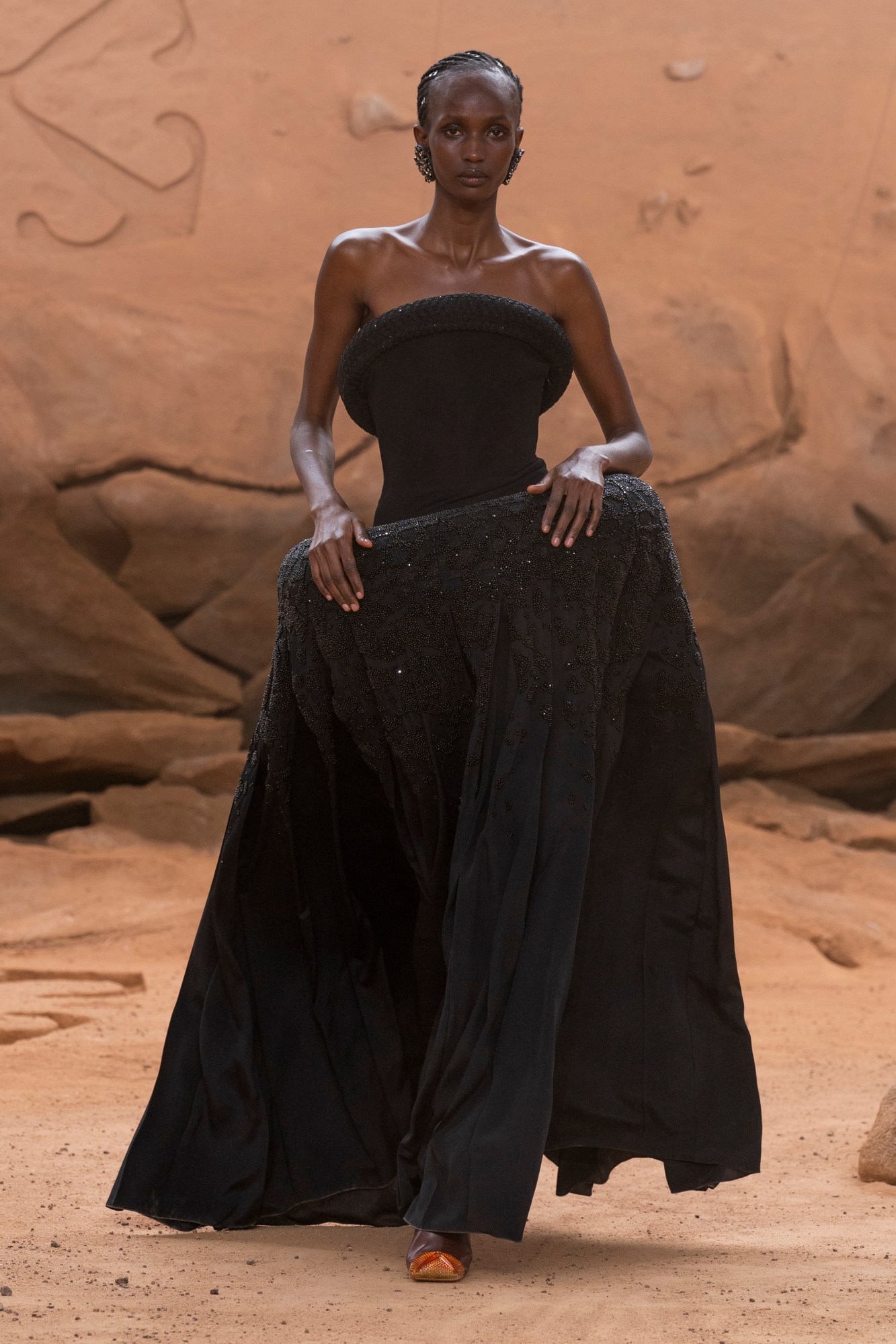
Off-White
The only certainty for Ib Kamara’s debut collection for Off-White was that it was going to be – and had to be – out of this world. Of course, his AW23 show delivered on that, with both the set and the clothes taking us to another planet. The projection of inspiration into another realm was intentional; after a previous season that celebrated the incredible accomplishments Virgil Abloh had achieved in his tenure at the brand, this was a time of change, of uncertainty and upheaval, of space in all its iterations. Ib’s resulting collection was then about using that space and leaning into world-building at a new, but not new, Off-White. Some of the pieces felt appropriately space-aged; there was a bright red hooded, astronaut-style suit covered with intricate straps and belts, decidedly sci-fi wrap sunglasses and crafted metal head decorations on impressively sculpted suits and leather in the exact same shade of orange that coats both the runway and the surface of Mars (we presume).
Other looks lifted their inspiration from closer to home, both the Off-White industrial archives and Ib’s West African roots; one of the final ensembles was an intricately crafted, totally beaded suit in a swirl of oranges, reds and browns which caught the light of the 360 degree mirror in the middle of the runway. Indeed, this was a collection that exemplified a 360 way of thinking, with a rounded imagination. “There could only ever be one Virgil,” Ib explained after the finale, in which he looped around the centre of his new planet accompanied by Naomi Campbell. “He was constantly innovating and thinking ahead and he left us a brand that can reinvent itself, grow and stand the test of time. I feel the responsibility for him and for everyone who has worked, loved, worn and believed in Off-White™. This collection marks the beginning of a new path, inspired by world-building. It envisions something yet to exist. Moon-surfing daydreams and star-gazing thoughts are at the heart of our evolution.Working on this collection, I found myself and my point of view in a universe that is true to me. It’s punk, sexy, romantic and inspired by our modern lives.” This was one small step for Ib, one giant leap for the house Virgil built. RL
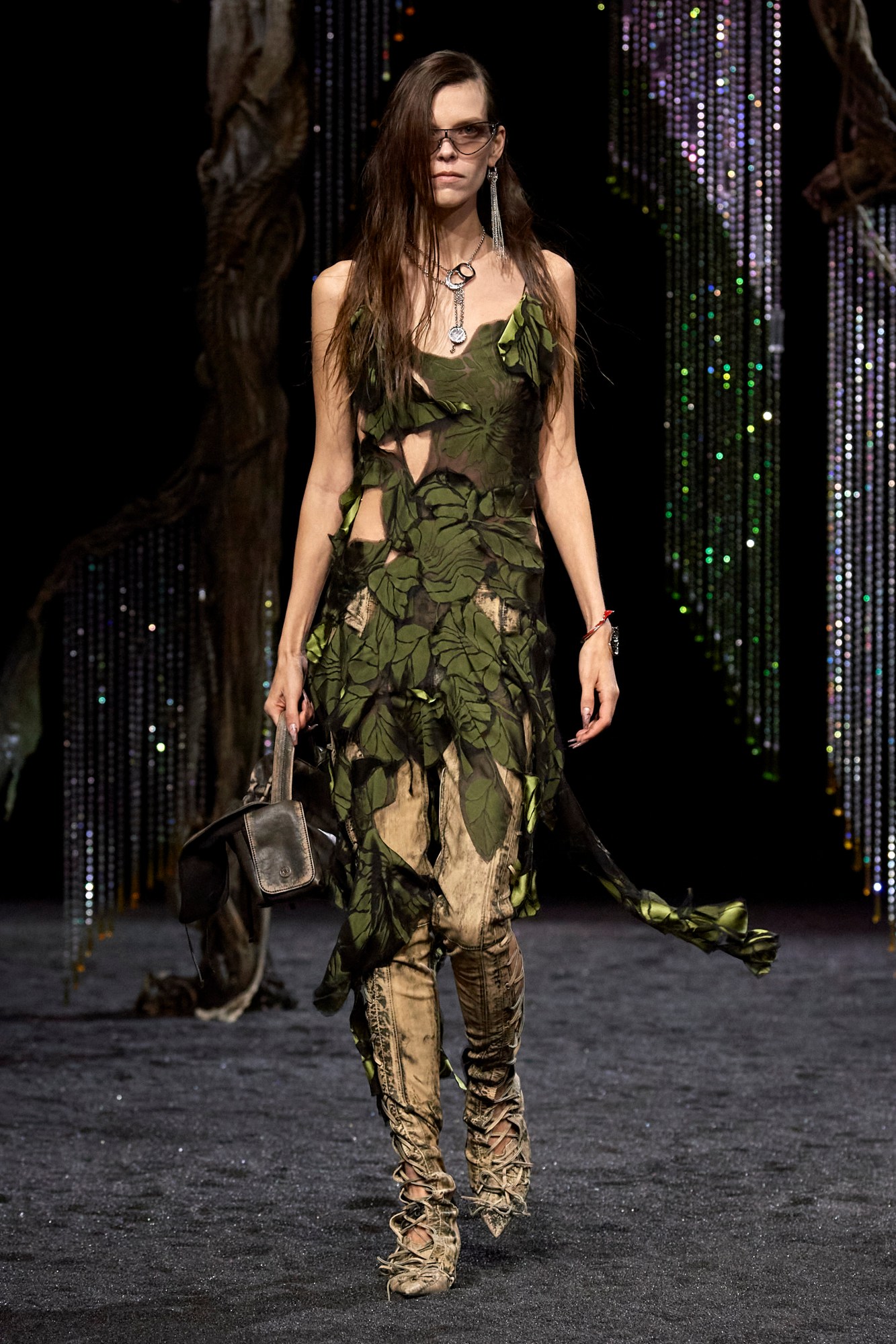
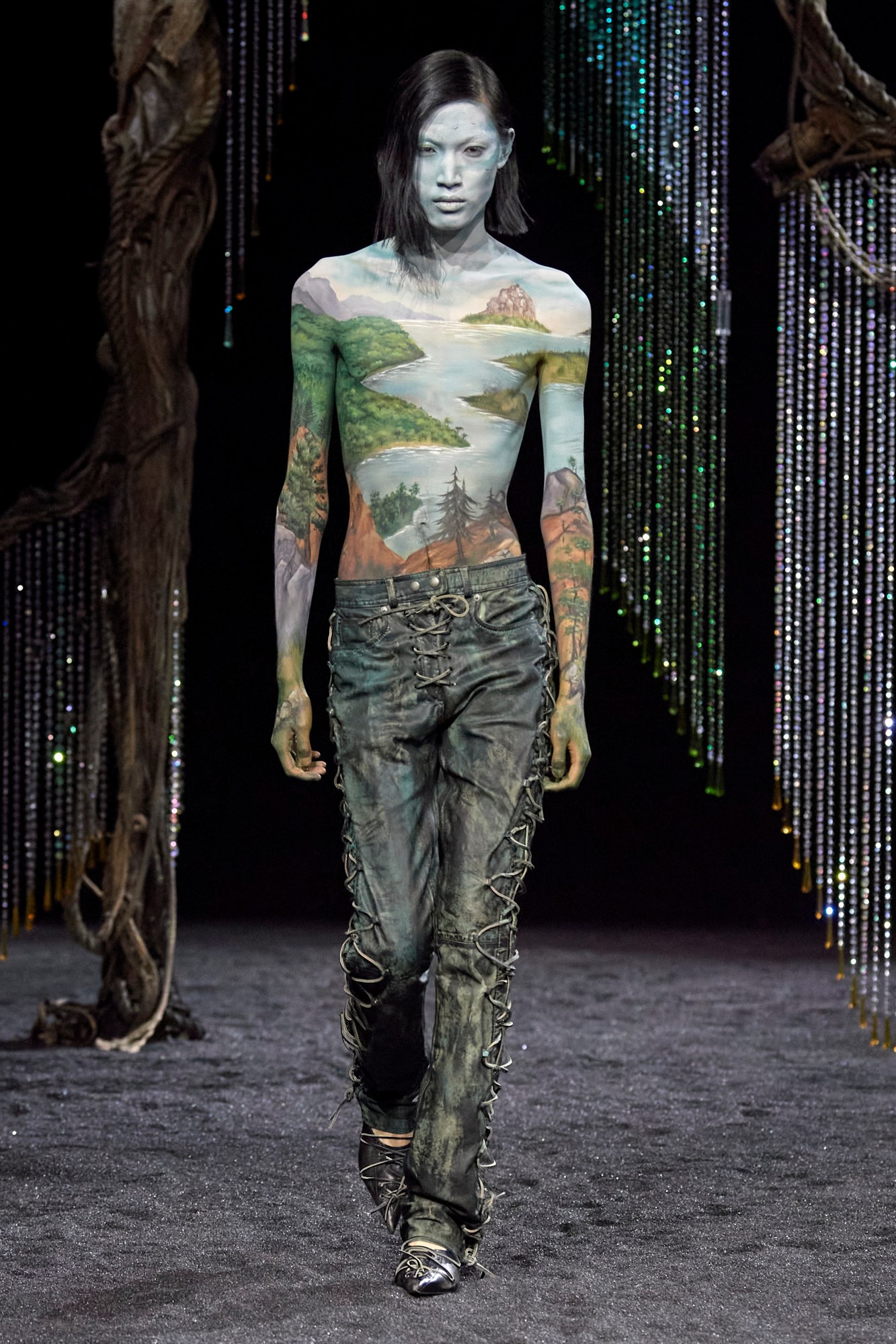
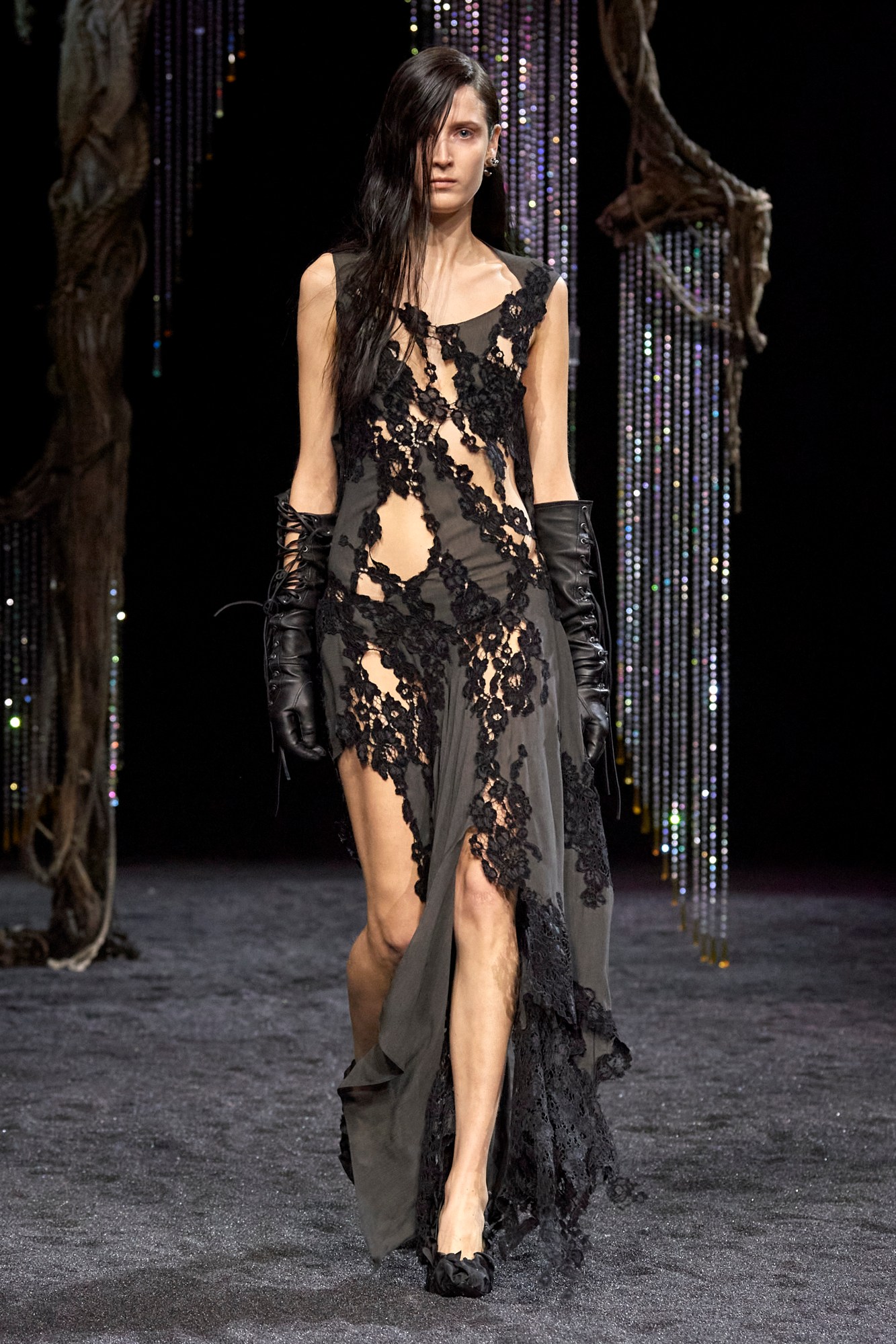
Acne Studios
Acne Studios took us to another world for AW23, one that felt both more magical and more prehistoric than our own. To get us there, Jonny Johansson transported us to a fantasy land. Models walked on glittering black sand, snaking through bejewelled tree stumps in an AW23 collection that looked both apocalyptic and fairytale. The dimly lit space and colour palette of the Swedish designer’s pieces was similarly apocalyptic, acid rain yellows, slate greys, dusky browns, earthy greens and voluminous outerwear suitable enough to get you through either a long Stockholm winter or a night on the dark side of the moon. “I wanted to capture the beauty of the darkness in both the collection and the set. Sweden is the kind of place where the city ends abruptly and then the pine forest begins. I’ve always enjoyed the contrast between urban life and nature, the idea that an infinite forest is just around the corner,” the designer explained. “In Scandinavia, nature rubs up against the city very often: you tend to have the playground on one side of the building and the forest on the other. But living in such close proximity to nature is becoming increasingly rare in our modern world.” That merging was reflected in the collection too. Models melded in with the foliage around them, floating through in slate grey dyed denim and painted leather, flowy silhouettes and layered gowns next to utilitarian pieces and strong stompy boots, the fabrics and the looks all fused together, complementing each other. Just as nature intended, to be fair. Driving home the earthiness of this point, one standout look melded clothes with body paint, a model covered in a forest universe scene. Very: if Hans Christian Anderson wrote a science fiction novel about the end of the world. RL
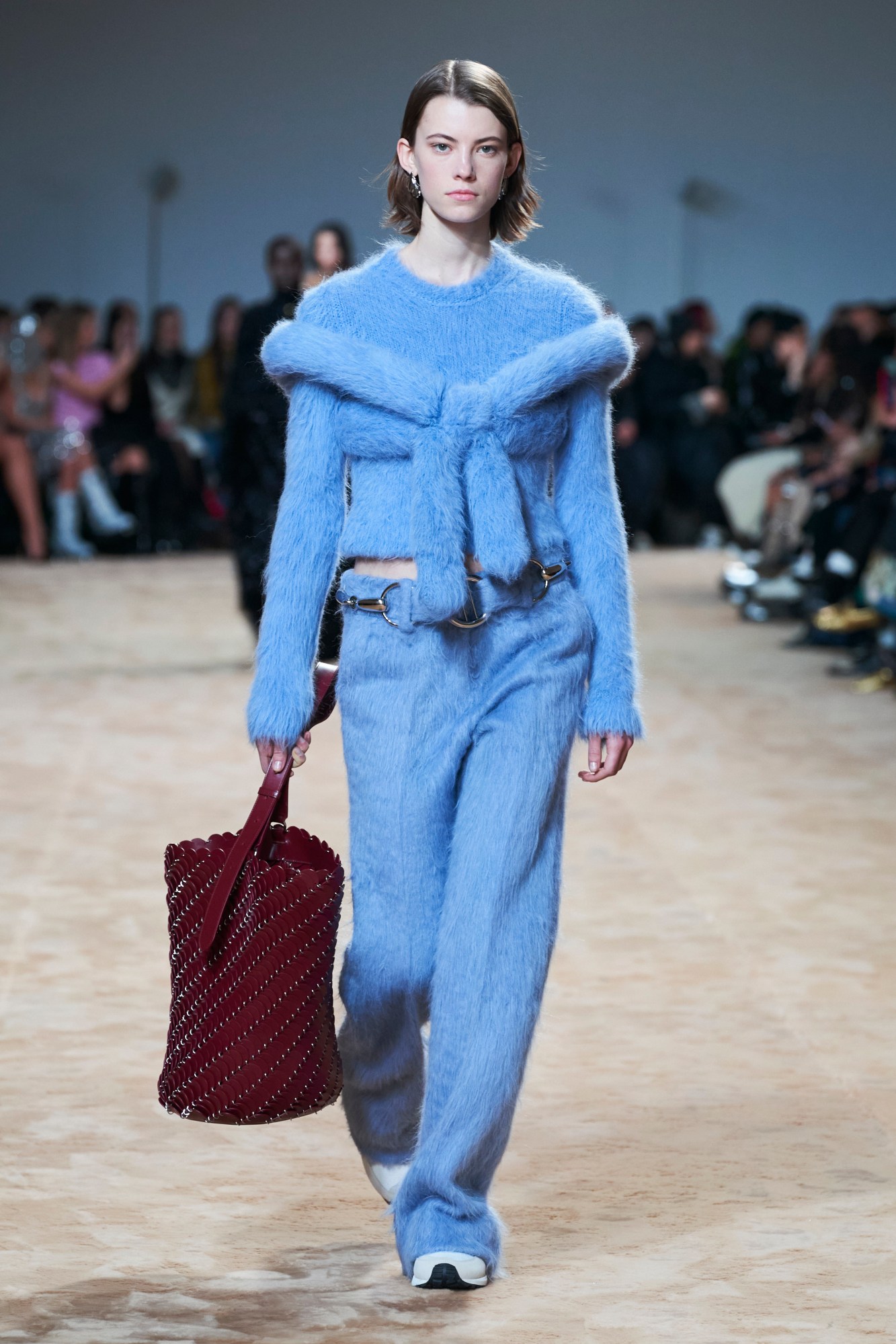

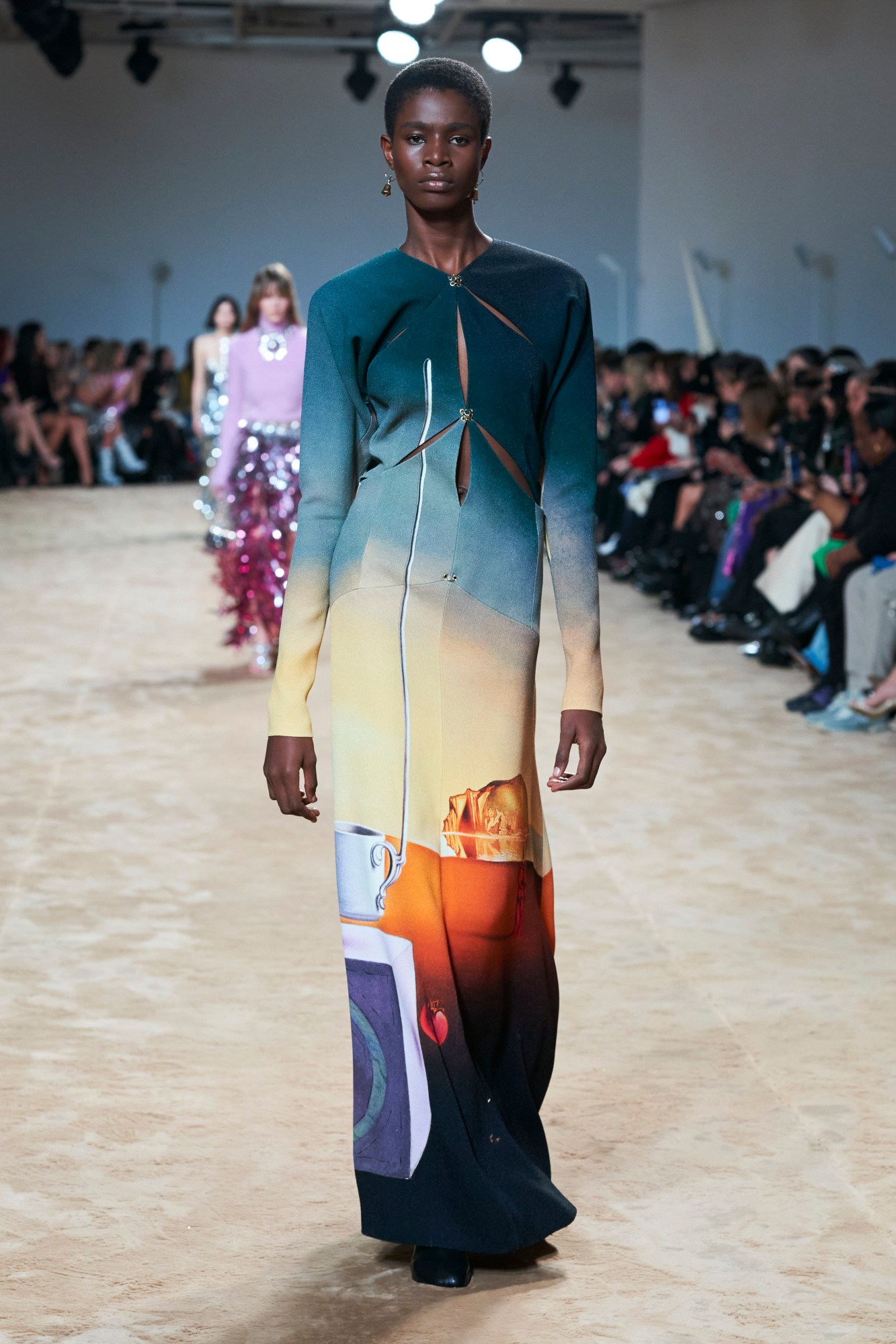
Paco Rabanne
Last month, the iconic Spanish-born designer Paco Rabanne passed away at the ripe age of 88. Known for his metal creations that revolutionised the classicism of haute couture in the Swinging Sixties, the designer was lightyears ahead of his time — and continues to be a key influence on generations of designers today. His namesake house’s current creative director, the talented Julien Dossena, closed his first show since the pandemic with a simple tribute to the designer: a parade of some of Paco’s original silver, armour-like mini dresses, which serves as a reminder of just how relevant the designer’s work is today.
Before that, though, there was his own interpretation of that legendary archive. In many ways, it felt like Julien laid down the gauntlet with a collection that was primarily focused on evening wear — one-of-a-kind dresses that draw on the iconic Barbarella chainmail, but instead much an almost mythological tilt — think Delphic drapery, mermaid skirts, long tinselly skirts that resembled half-human, half-animal women. A handful of floor-skimming dresses, slashed here and there to reveal glimmers of bare skin beneath, came with capital-S surrealist prints, easily recognisable as Salvador Dalíartworks to the knowing eye. They were a result of Julien’s deep dive into Paco’s friendship with the legendary artist in the 60s, and officially a collaboration with the Gala-Dalí Foundation.
But they weren’t the only surreal moments in the show. Lurex pieces, fluffy mohair sweaters with giant bows wrapped around the decolleté, and long chintz-silk dresses spliced with graphic lace, were simple yet intricate, impossible to take your eyes off of. Towards the end of the show came wearable chandeliers, dresses so laden with crystals and jangling strips of metal, that you heard them coming down the latte-carpeted catwalk before you saw them. Easy on the eye, as well as the ear — almost like fashion ASMR — they perfectly embodied the collection’s title, ‘Chasing Dreams’. This was a collection of mesmerising dresses, not exactly for popping to the supermarket, but for making transporting you to some faraway galaxy, not unlike Paco’s original space-age designs. They made a lasting impression on what has been rumoured to be Julien’s last collection for the house.
Dries Van Noten
Fashion week is nothing if not people watching, so Dries Van Noten‘s decision to sit the audience for his AW23 show in front of a giant mirror, reflecting both the collection and ourselves right back at us, felt very on the nose. The Belgian designer’s collection unfolded with the level of theatricality you’d expect from this kind of set up, accompanied musically by dramatic composition from fellow Belgian avant-garde drummer Lander Gyselinck. Following the models as they tracked a snaking line around Le Dôme de Paris, it was impossible not to also catch sight of yourself somewhere in the background (horrific!). If it felt unexpectedly intimate, that was intentional. This season the brand’s eponymous designer wanted to explore the intimacy and relationship between the garments we choose to wear and the person wearing them. The theme was simple: clothes for the love of clothes. The clothes themselves reflected (ha!) that too, exploring the power in contrasts and the limits of decoration. Rugged wool coats from English mills next to golden emboidered corsets and French-milled lace, the height of traditional femininity. Tailoring which emphasised the modern and the masculine (big shoulders, pinstripes, elongated trousers) was layered next to the ancient and the feminine; hand-painted flower prints, sheens of gold foil on jackets, coats with delicate overlays, and absolutely loads of organza and silk. Coats were reversible, shirts were doubled up, old techniques given new life in lean precise shapes. If the collection had a throughline it was: why not both! This was a celebration of doubling and reflection, concealment and depth, just about striking enough to get us all to stop looking at our own reflections and look at the clothes instead (for approx 30 seconds). RL
The Row
Review to come.


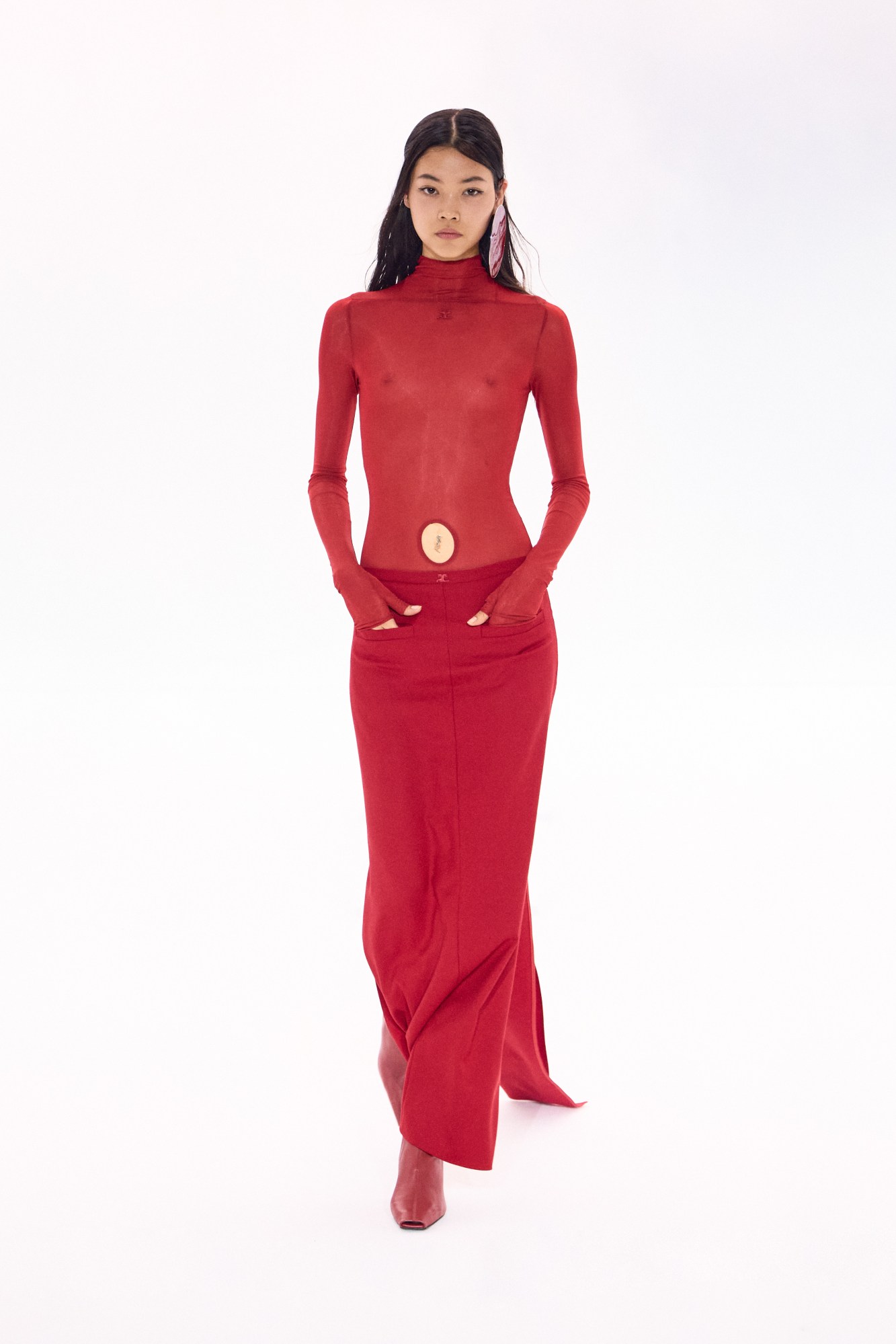
Courréges
Nicolas Di Felice’s latest collection for Courrèges, as in previous seasons, was presented around a square formation – a nod to the house’s foundations in geometry-driven design ethos – this time taking place in a fog-sprayed, backlit hall designed by artist Rémy Brière in collaboration with collective Matière Noire. It offered a fittingly eerie context for the looks that opened the collection – though attentions weren’t initially drawn to the clothes worn by the models, but rather to the iPhones they tapped away at, their screens lighting up their entranced faces. It was a deliciously ironic example of art imitating life (and, indeed, the other way round), given that if those models had taken a moment to break the stronghold of their screens and peer beyond them, they’d have found themselves at the heart of a reverse panopticon of phone cameras in turn.
This may, at first reading, sound like yet another of the increasingly tedious gimmicks that have come to dominate runways at the expense of focussing the audience’s attention on the actual clothes, but here, it actually worked to opposite effect. In punning on our collective technoiogical servitude, Nicolas cleverly encouraged his audience to focus on the reason we’d all assembled – the clothes. And my, what clothes they were! Marking a significant development in his vision for the house, this season saw the introduction of an almost-hexagonal, boulder-shouldered jacket silhouette – appearing in leather biker, translucent PVC and classic Courrèges vinyls. With its forward-sloping line evoking of a hunched body – over a screen, perhaps – it immediately suggested a notion of cloaking or shielding oneself from the storms that seem to be raging wherever you turn these days; a notion compounded by the thick gauge tweed coat, shearling aviator jacket and fleecy knit jumper that came with slashed and zippered side seams, allowing for each piece to be worn à la cape.
Yes, this was a collection filled with immaculately cut and proportioned outerwear, that didn’t hold Nicolas back from delving into the territory of insouciantly slinky minidresses, svelte column silhouettes and clubby cut-outs that he has rapidly made his own. Square-ish crop-tops, long-lined shift dresses and whittle-waisted pinstripe wool coats had gaping holes punched out at the décolleté, filled in talismanic mirrored discs. Elsewhere, cutouts on diaphanous mesh tops – some with leather sleeves – and buttoned denim jackets framed navels, with the draped waistbands of borderline-bumster trousers accented the hip. Closing out with a trio of gowns in gradient paillettes that glinting in the phone flashlights they caught as they passed by, a pertinent question came to mind: “If a collection files down a runway, but no one’s there to livestream it, does it even exist?” Thankfully for Nicolas, and for the esteemed house of which he is the current custodian, these were clothes that transcended the fickle transience of internet time, and will be well remembered long after they fade from our feeds. MS
Dior
Say the name Christian Dior and most people will have immediate associations: Paris, hourglass femininity, Frenchness, glamour, Hollywood, luxury, and perhaps most importantly, the 1950s. For most of us, the idea of Paris in the 1950s is glamorous, informed by Richard Avedon’s black-and-white photography, Audrey Hepburn in Funny Face (the original Emily in Paris), and of course, the mythology of Dior and its whittled waists and full skirts, a look that travelled the world and came to define the decade’s image of post-war women, from Old Hollywood stars to all-American housewives.
It made sense, then, that Maria Grazia Chiuri would want to examine the decade much deeper with her latest collection. It is, after all, the era most commonly associated with Christian Dior, who showed his era-defining ’New Look’ in 1947 and died a decade later. For Maria Grazia, though, it isn’t simply the silhouettes of clothes that draw her to the decade. In 1944, French women were given the right to vote, and in 1949, Simone de Beauvoir’s seminal feminist text The Second Sex triggered an intellectual revolution that changed the course of so many women’s lives. A new generation of women was redefining post-war life for themselves, women like the beatnik Queen of the Left Bank, Juliette Greco, the singer-artist-actress usually found at the Café de Flore; Edith Piaf, the gutsy chanteuse rumoured to have been let off for murder because it was a crime of passion; and even Catherine Dior, the couturier’s sister who survived a concentration camp to become a successful florist after the war. Read the full review here. OA
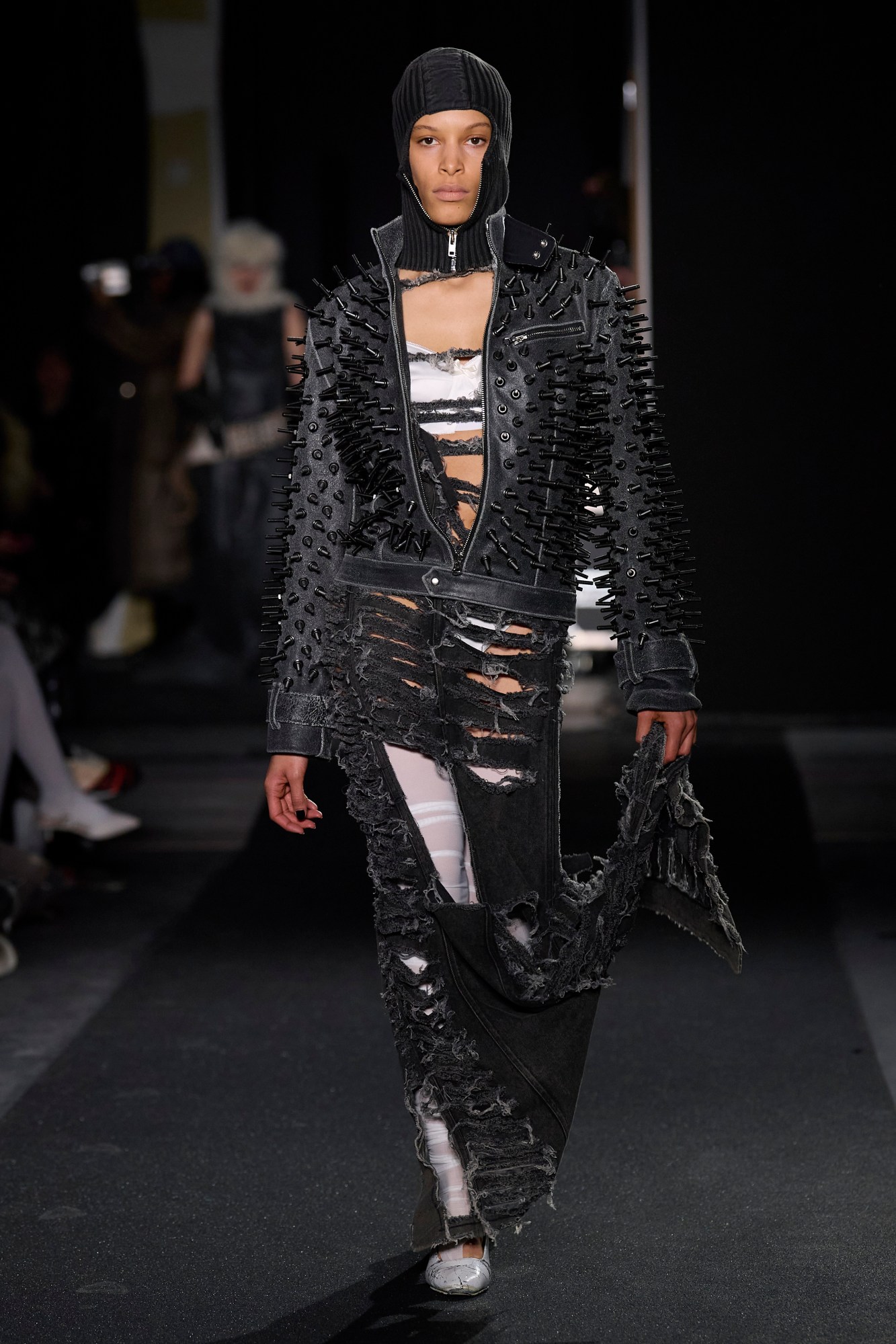


Vaquera
At this stage, Patric DiCaprio and Bryn Taubensee are familiar faces in Paris, with the show they opened the city’s fashion week as their third on the schedule since decamping from New York (where they still keep their studio). The move to showing in the global fashion hub has brought with it a notable elevation in their work, resulting in collections that feel both more accomplished and more accessible than those they presented in the city they still call home – rather than the esoteric fashion fan fiction they first made a name for, they’re now creators of serious fashion with a rapidly expanding fanbase.
Well, not too serious, though. This season, Vaquera’s trajectory in terms of technical execution and the development of directional-yet-plausibly-commercial products continued. Particular kudos to the pair for this season’s deftly cut leather pieces, including a peacoat, a full-length zip skirt, and cropped jacket with furry sleeves, as well as to developments on their signature ready-to-wear-underwear hybrid pieces, like wide-leg trousers featuring a scarlet thong appliqué at the crotch, and piqué polos with stiffly-cupped satin bras over the top. What really impressed, though, was how these looks were cleverly counterbalanced by pieces that exhibit the harebrained eccentricity that first caught the fashion world’s attention. A leather moto jacket came studded with heavy-duty screws – cutting a silhouette that echoed that famous image of a suit of Siberian bear armour – then complemented by a matching pair of trousers, clinking with the model’s every stomp. A clownishly proportioned pierrot suit and a debutante skirt came in what looked like plastic sheeting, bordered with swathes of snow-white faux fur, bringing a welcome dash of campiness and theatricality to a collection created by designers that, if this was anything to go by, we should all be taking seriously. MS
